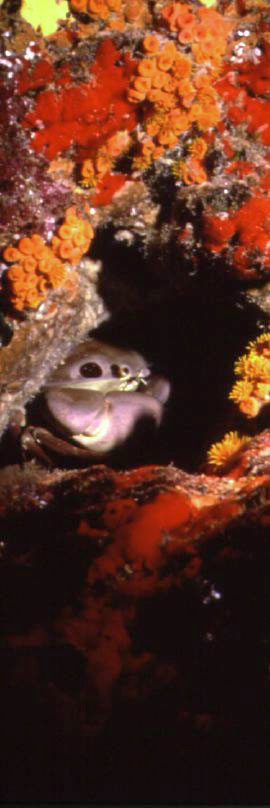| |
|
|
|
The Gulf of Maine includes more than 59,570 square kilometers of estuarine drainage areas. Estuaries in this region were formed by glaciers that removed soil cover, leaving behind rocky shorelines and steep-sided river channels. These estuaries are smaller on average and generally deeper than those found in other regions. The strong tides and basin geometry in these estuaries result in tidally dominated circulation patterns. Three large human population centers (Boston, Massachusetts; Manchester, New Hampshire; and Portland, Maine) are located in the Gulf of Maine estuarine drainage area.
|
Fig. 1. Geographical coverage of the five major marine regions of the United States, colored to indicate their boundaries within their 200-mile Exclusive Economic Zones. |
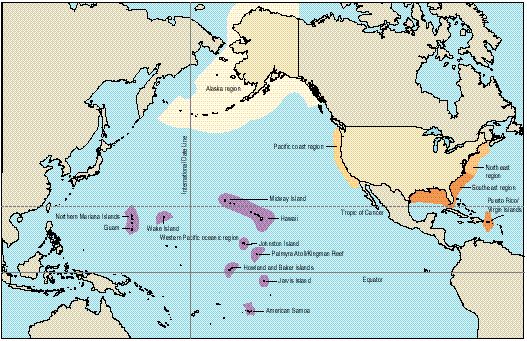
|
Georges Bank is generally delineated from the surrounding deeper Gulf of Maine by the area of equal depth (bathymetric contour) of 100 meters. Along the northern flank, sharp depth gradients between the Gulf of Maine and Georges Bank define the bank and generate equally sharp hydrographic and biological fronts. Changes in bottom depths and hydrographic conditions are more gradual along the eastern and southern areas of the bank. To the southwest, Georges Bank is bounded by the Great South Channel, which separates Georges Bank from Nantucket Shoals. The shallowest waters are found on the northwestern part of the bank. Daily and twice-daily tides, interacting with the shallow bottom topography of the bank, maintain exceptionally strong currents that result in a vertically well-mixed water column within the 60-meter isobath throughout the year (Butman 1987; Twichell et al. 1987). This vertical mixing exerts a major influence on the abundance and richness of biological populations on the bank.
|
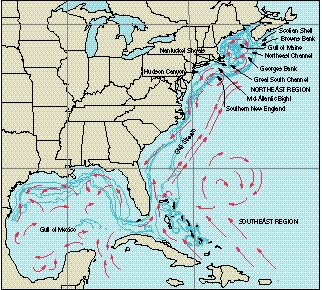
Fig. 2. General surface circulation and major areas of the Atlantic and gulf coasts. |
The southern New England and Middle Atlantic Bight areas include the shelf area between Cape Hatteras, North Carolina, and the Great South Channel off Cape Cod. The shelves in these areas slope gently offshore and are relatively shallow. Much of the bight from Long Island southward is less than 60 meters deep. Waters in southern New England, with respect to productivity and plankton, represent a transition between the more oceanic characteristics of the Georges Bank area and the dominant estuarine influences on the Middle Atlantic Bight. The water column of the Middle Atlantic Bight is well mixed during winter and strongly stratified during summer, with the exception of shallow coastal areas, which experience episodes of vertical mixing from storms, upwelling, and downwelling.
|
|
|
Fresh water enters the Middle Atlantic Bight principally at the mouth of the Hudson-Raritan, Delaware, and Chesapeake bays. Such local sources of fresh water are responsible for approximately 70% of the large year-to-year variation in salinity in the Middle Atlantic Bight and strongly influence hydrographic conditions (Manning 1991). The general circulation in the Middle Atlantic Bight is characterized by a net flow of shelf water from Georges Bank through the bight in a southwesterly direction toward Cape Hatteras. At the shelf break, a persistent hydrographic front separates the shelf from offshore slope waters. This front undergoes seasonal onshore-offshore movements. Though the front is coherent from Georges Bank to Cape Hatteras, warm core rings drifting southwest between the northern edge of the Gulf Stream current and the continental shelf break, in addition to intrusions of Gulf Stream water along the southern portion of the Middle Atlantic Bight, may entrain and displace significant amounts of shelf water and organisms (Fig. 3).
|
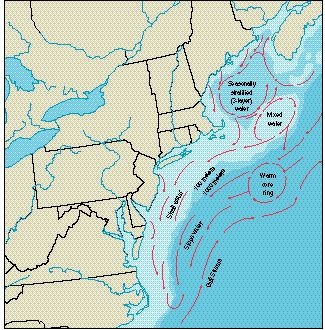
Fig. 3. a) General surface layer circulation of coastal and offshore surface waters of the Northeast region. b) Color-enhanced satellite image of relative productivity of the Northeast coast and offshore waters based on imagery from Nimbus 7 Coastal Zone Color Scanner. The yellow, red, and brown pigments represent chlorophyll levels, and blue depicts low-productivity Gulf Stream waters and the warm core ring.
a. |
The combined area of the southern New England-Middle Atlantic Bight accounts for more than 124,320 square kilometers of estuarine drainage, extending from Buzzards Bay in Massachusetts through Chesapeake Bay in Virginia. Chesapeake Bay has the largest total drainage area in the region and is one of the largest estuaries in the world. Almost half of all fresh water entering estuaries in the Northeast region flows into Chesapeake Bay (see chapter on Northeast). The mid-Atlantic coast ranks third, behind the Gulf of Mexico and South Atlantic regions, in total wetland area contained in estuarine drainages (National Oceanic and Atmospheric Administration 1991a), with forested wetlands being the most common wetland type. The major human population centers in the region--New York, Philadelphia, Baltimore, and Washington, D.C.--make this area the most densely populated coastal region in the nation. Urban land use still lags behind forest and agricultural land uses in the region's estuarine drainages; however, compared with other geographical regions, mid-Atlantic estua-rine drainages include the greatest percentage of urban land (National Oceanic and Atmospheric Administration 1990a).
|
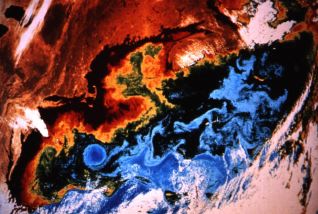
b. Courtesy National Oceanic and Atmospheric Administration |
Primary Production |
|
Primary production is relatively high throughout the Northeast shelf ecosystem and is exceptional on Georges Bank and in the nearshore waters of the southern New England-Middle Atlantic Bight, where the phytoplankton, influenced by nutrient-enriched estuarine plumes, produce three times the mean productivity of the world's continental shelves (O'Reilly et al. 1987; Fig. 4). Generally, phytoplankton abundance decreases from nearshore to the shelf break (Fig. 5). The highest concentrations of phytoplankton are usually observed near the mouths of the Hudson-Raritan, Delaware, and Chesapeake bays, over the shallow water on Georges Bank, and in a small area along the southeast edge of Nantucket Shoals. Lowest abundances are usually restricted to the most seaward stations sampled along the shelf break and the central deep waters in the Gulf of Maine. When relatively high primary production occurs in the Gulf of Maine, it is in the inshore western portion.
|
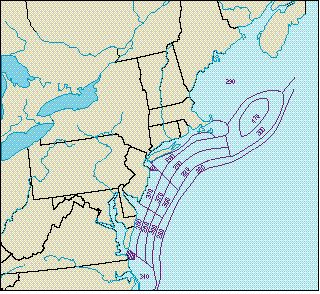
Fig. 4. Mean annual primary productivity (grams of organic carbon per square meter per year) of the coastal and offshore waters of the Northeast shelf ecosystem. |
The annual cycle of phytoplankton biomass follows the pattern expected for temperate continental shelf ecosystems, where there is at least a two-fold seasonal variation. The greatest phytoplankton concentrations and largest standing stocks occur during the winter-spring bloom; the lowest biomass is during summer, when vertical density stratification is greatest.
|
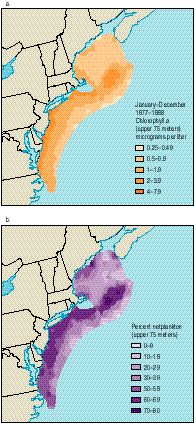
|
Fig. 5. a) Distribution of Chlorophyll a showing primary productivity, and b) distribution of netplankton representing larger phytoplankton (percentage of chlorophyll sample retained in a 20-micron sampling mesh) in the Northeast region, 19771988. |
The winter-spring bloom is a major biological event, but its timing, duration, and intensity vary significantly by area. In the southern New England-Middle Atlantic Bight, the bloom progresses from nearshore to the slope, occurring January through March in the nearshore and midshelf and during March in offshore shelf and slope waters. On Georges Bank, the winter-spring bloom peaks in shallow water during March and along the southern flank of the bank during April. The winter-spring blooms appear in February through March in the nearshore western Gulf of Maine and during April throughout the deeper waters of the gulf.
|
In most regions of the ecosystem, a secondary phytoplankton bloom is evident in the fall. As with the winter-spring bloom, the timing and intensity of the fall bloom vary regionally. In the shallow nearshore Middle Atlantic Bight, fall blooms appear in September through October. In the midshelf and outer-shelf regions and along the Middle Atlantic Bight shelf break, the bloom occurs a month later, in October, and follows the expected delay in destratification of deeper water. In the shallow water on Georges Bank, fall bloom starts in September and continues through November. In the deeper water, blooms appear during October. In some areas of the Gulf of Maine, the fall bloom approaches the magnitude of the winter-spring bloom, but Georges Bank, southern New England, and Middle Atlantic Bight fall blooms are clearly subordinate in magnitude to winter-spring blooms.
|
|
|
There are distinct patterns in the seasonal, regional, and vertical variation in plankton abundance which seem to reflect significant spatial diversity in species composition. Netplankton (larger than 25 microns) tends to dominate nearshore areas of the southern New England-Middle Atlantic Bight and the shallow water on Georges Bank, where chlorophyll concentrations are usually high. Nannoplankton (smaller than 25 microns) dominates deeper waters at the shelf break, as well as deep water in the Gulf of Maine, where chlorophyll levels are usually low (Fig. 3).
|
|
|
Findings support the relatively new idea (Malone et al. 1983) that netplankton prevails during the unstratified period when turbulence, vertical mixing, and nutrient levels are high and light for photosynthesis in the upper mixed layer is variable. Smaller nannoplankton and motile species prevail during density stratification, when turbulence is low and average light for photosynthesis is high in the upper mixed layer.
|
|
|
Planktonic Secondary Production |
|
Secondary production patterns of the Northeast shelf ecosystem are distinguishable in four geographic areas characterized by distinctive water depth, hydrography, food chain relationships, seasonal species succession, and pulses of zooplankton abundance. On Georges Bank, the annual peak is in spring, followed by a sharp decline from spring through summer. In the Gulf of Maine, the annual peak of zooplankton abundance occurs in May and declines less precipitously in autumn than on Georges Bank. In southern New England, zooplankton abundance is bimodal, with an initial peak in May and a secondary peak in August. In contrast to the other three areas, in the Middle Atlantic Bight zooplankton reaches an annual peak in autumn. The zooplankton of the Northeast region (Fig. 6) includes 394 taxa, with 50 dominant in at least one location. The taxa represented include chaetognaths, barnacle larvae, copepods, water fleas, crab larvae, echinoderm larvae, appendicularians, doliolids, and thaliaceans. Significant differences in patterns of dominance were observed in the four areas, from fewer dominant species in the northern portions of the ecosystem to increased biodiversity and dominance in the southern areas (Sherman et al. 1983).
|
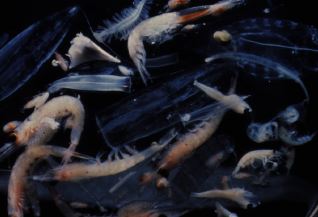
Fig. 6. Zooplankton. Courtesy National Marine Fisheries Service |
Based on analysis of 9,942 zooplankton volume measurements collected by the National Oceanic and Atmospheric Administration's Marine Resources Monitoring, Assessment, and Prediction program from 1977 to 1986, zooplankton was declining during the 1980's (Sherman et al. 1994). The trend for Georges Bank was more variable than for the other three areas. The persistent downward trend in zooplankton abundance coincided with the increase in abundance of principal open-ocean fishes--herring, mackerel, and butterfish. Zooplankton populations have been sufficiently robust in the Northeast shelf ecosystem, even through a period of decline, to sustain the recovery of both herring and mackerel populations. Sufficient zooplankton will also be needed to support a recovery of the depressed cods and related fishes, together with flounder stocks during their larval stages. This dependence of recovering fish populations on zooplankton represents yet another factor to be considered in the recovery of zooplankton itself. Whether the observed decline in zooplankton reflects a response to increasing predation by the growing populations of pelagic fishes or a biofeedback response to an environmental signal remains an important unanswered question. There are some indications of renewed growth in zooplankton populations. From further analysis of the data through 1992 over Georges Bank, Sherman et al. (1994) found that the zooplankton standing stocks may again be increasing (Fig. 7).
|
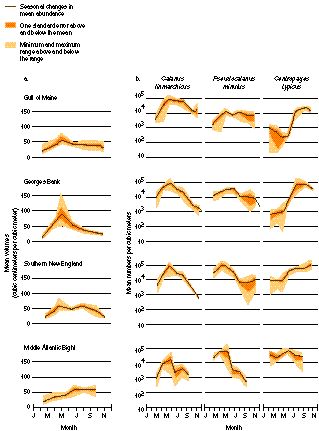
Fig. 7. a) Seasonal changes in the standing stock of zooplankton for four areas of the Northeast shelf ecosystem--the Gulf of Maine, Georges Bank, southern New England, and the Middle Atlantic Bight. Values are based on mean monthly volumes in cubic centimeters per 100 cubic meters of water and include the range and standard error of the mean. b) Seasonal pulses in abundance of the dominant copepods--Calanus finmarchicus, Pseudocalanus minutus, and Centropages typicus--in four areas of the Northeast shelf ecosystem are shown. |
To gain insights into the possibility of an environmentally mediated biofeedback, the zooplankton was examined for shifts in biodiversity over time as indicated by the abundance of five zooplankton species: Calanus finmarchicus, Pseudocalanus spp., Centropages typicus, Metridia lucens, and Centropages hamatus, for the four Northeast shelf areas from 1977 to 1987. Significant trends for Georges Bank and the Gulf of Maine were found. It appears that the dominant copepod community was undergoing a shift from Calanus finmarchicus, Pseudocalanus spp., Metridia lucens, and Centropages typicus toward an increasing abundance of C. hamatus on Georges Bank and in the Gulf of Maine (Sherman et al. 1994). The shift in species abundance may have been environmentally induced, as it is unlikely that the principal pelagic fishes would selectively avoid preying on C. hamatus. An ecosystem monitoring program presently under way through the National Marine Fisheries Service's Northeast Fisheries Science Center, in cooperation with the Environmental Protection Agency, is designed to provide more definitive information on factors that cause changes in the structure of the zooplankton community. Major shifts in biodiversity of the zooplankton community could affect the recruitment success of the presently depressed cod, haddock, and flounder populations.
|
|
|
Benthic Resources |
|
Information on the bottom of the Northeast shelf ecosystem is available from qualitative surveys beginning in the 1870's and quantitative sampling in the 1950's-1960's (Wigley and Theroux 1981; Fig. 8) and the 1970's-1980's (Steimle 1990). These surveys found the benthos to consist of a mosaic of assemblages. The 1970's-1980's surveys yielded 1,250 taxa, with polychaete worms most numerous (45% of the total), followed by crustaceans (23%), bivalves (12%), and gastropods (11%). Composition and abundances of dominant species vary temporally and spatially, but subsequent surveys of benthic assemblages have found them to be relatively stable. The only notable exceptions to this stability are in areas where waste disposal has altered the benthos or where shellfishes have been harvested. Larger bottom-dwelling animals like Atlantic rock crabs and lady crabs, the most abundant species, had fairly stable population sizes between 1978 and 1987. Stocks of the horseshoe crab, whose eggs are critically important as food for migrating shorebirds, were stable from the mid-1970's to mid-1980's, with no evidence that harvesting levels were depleting the resource, but continued monitoring was advised for this species (Botton and Ropes 1987).
|
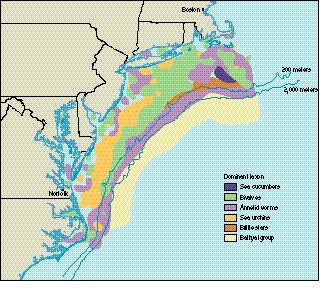
Fig. 8. Geographic distribution of biomass for each dominant benthic species or group in the Middle Atlantic Bight, part of the Northeast shelf ecosystem (from Wigley and Theroux 1981). |
The larger animals of submarine canyons on the shelf edge and continental slope, such as those off New Jersey and Delaware, have been sampled since the 1970's, with intensive work in the 1980's and early 1990's, in order to estimate the potential effects of oil and gas exploration and of waste disposal at Deepwater Dumpsite 106. Deepwater Dumpsite 106 is located approximately 170 kilometers southeast of New York City in depths of 1,700-2,750 meters. The benthic fauna of this area was found to be remarkably naturally diverse, with 798 species (58% new to science) recorded in the pre-oil exploration study.
|
|
|
Surveys of larger bottom-dwelling organisms have been conducted in all the major estuaries of the Northeast shelf ecosystem except Cobscook Bay in northern Maine. Only Chesapeake Bay has a major program for monitoring status and trends of benthic organisms; indicators there signaled recent improvements at some sites and increasing degradation at others. Data from the 1970's indicated that Delaware Bay and Raritan Bay had lower abundances of benthic fauna than did other Middle Atlantic estuaries, but the number of species in these bays was typical for the region. Studies in the early 1990's suggested no major changes had occurred in the Delaware Bay benthic ecosystem since the earlier work, whereas higher abundances and richness were reported for Raritan Bay in the late 1980's (Cerrato et al. 1989). In Chesapeake Bay and western Long Island Sound, chronic hypoxia (defined as less than 2 milligrams dissolved oxygen per liter of water) has altered the benthos and spurred nutrient reduction efforts. The decline of eelgrass in many northeastern estuaries since a 1930's wasting disease affected the plant has probably led to reduced abundance and diversity of benthic organisms in those areas.
|
|
|
Information is becoming available on the secondary production of benthic invertebrates, especially harvestable and forage species and community dominants. Annual productivity estimates of benthic organisms on Georges Bank suggest that production is relatively high there (more than 100 kilocalories per square meter) compared with other offshore and coastal areas in the northwest Atlantic (Steimle 1987).
|
|
|
Fisheries Resources |
|
The Northeast shelf ecosystem contains a myriad of finfish and invertebrate species, some of which exist wholly within the ecosystem and others that are migratory and cross the regional boundary. Briggs (1974) reported about 250 shore fishes in this area, and Grosslein and Azarovitz (1982) indicated that 180 species of fishes and invertebrates were recorded in 1974 in the spring and autumn bottom trawl surveys conducted between Nova Scotia and Cape Hatteras, North Carolina, by the National Marine Fisheries Service's Northeast Fisheries Science Center. This comprehensive survey, which began in 1963, provides an invaluable time-series of relative abundance estimates of all the fish and invertebrate species caught by this gear. The number of species is not comprehensive, however, because some are not caught in the otter trawls used in those surveys (for example, sharks, large pelagic fishes such as tuna and billfish, small or elusive pelagic fishes, and species residing in water deeper than 365 meters). About 50-75 of the species caught during the surveys are harvested in commercial and recreational fisheries. Although not supporting any fisheries, the remaining species are nevertheless important elements in the complex web of the ecosystem, serving as a food source for those species more directly used by humans.
|
|
|

Recent catches of these economically important fishes, both offshore and nearshore-estuarine, have been reduced because of the overexploitation of many stocks--such as most groundfishes and sea scallops--and the underutilization of others--such as Atlantic mackerel and Atlantic herring. A major shift in dominance has taken place within the finfish community from groundfishes in the 1960's--Atlantic cod, haddock, pollock, white hake, silver hake, and flounders--to predominantly elasmobranchs such as spiny dogfish and skates, and pelagic fishes such as mackerel and herring in recent years (Fig. 9). This shift is the consequence of excessive trawl fishing on groundfish and has led to reduced numbers of mature fishes, diminished spawning success, abnormally few older fishes, and stock depletion.
|
Fig. 9. Trends in indices of abundance of three groups of fishes in the Northeast region, 19681994. |
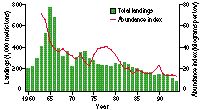
The demersal groundfish group (about 35 species) has a long-term potential yield of more than 500,000 metric tons; nearly every stock is overexploited. This overall abundance declined substantially in the past 30 years to an all-time low in 1994 (Fig. 10). Initially the decline was the result of heavy distant-water fleet fishing in the 1960's-1970's and, more recently, it is because of excessive domestic fishing pressure. Recent (1994) catches are about 160,000 metric tons per year. The status and trends of the major fish resources in the northeastern region are summarized in Table 1. Haddock, yellowtail flounder, and Atlantic cod stocks on Georges Bank have collapsed--1994 landings were only 23% of long-term potential yield (Fig. 11). Other groundfish species are generally low in abundance, and populations are expected to remain depressed. Consequently, large portions of the bank and southern New England were closed to fishing, effective December 1994, to reduce fishing pressure and avert reducing the abundance of these species to levels that would not support fishing of any kind (Fig. 12).
|
Fig. 10. Landings and abundance index of principal Northeast flounders and groundfishes, 19601994 (from National Oceanic and Atmospheric Administration 1996). |
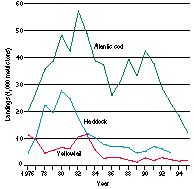
Abundance of spiny dogfish and skates combined (seven species), expressed as kilograms per tow from research bottom trawl surveys, has increased four- to five-fold since the late 1960's (Fig. 13). The biomass of spiny dogfish alone was estimated to be about 650,000 metric tons in 1994 (Northeast Fisheries Science Center 1994). This increase, coupled with the decline in cods and related fishes and flounders, has resulted in dogfish and skates increasing in relative abundance from 25% of the total fish biomass on Georges Bank in 1963 to about 75% in recent years. Currently, dogfish and skates are high in abundance and declining slightly.
|
Fig. 11. Total landings of Atlantic cod, haddock, and yellowtail flounder from Georges Bank, 19761995. |
|
The status and trends of anadromous species--which breed in rivers--and pelagic species are also summarized in Table 1. The long-term potential yield of anadromous species such as striped bass, river herrings, Atlantic salmon, American shad, and sturgeons is unknown, but current annual landings of less than 4,000 metric tons are far below historical levels. In contrast to most marine fishes, these anadromous species have been affected greatly by nonfishing activities, including the damming of rivers and environmental contamination (see chapters on Water Use and Environmental Contaminants). Atlantic salmon abundance has declined precipitously (Fig. 14), and the National Oceanic and Atmospheric Administration and the U.S. Fish and Wildlife Service have accepted a State of Maine Conservation Plan to conserve a population complex of Atlantic salmon in seven Maine rivers as an alternative to listing it as threatened under the U.S. Endangered Species Act. The striped bass is another species that was reduced to low numbers in the late 1970's and early 1980's by excessive fishing pressure (Fig. 15). Striped bass populations, however, have responded positively to a series of restrictive management measures imposed in the 1980's; this species' recruitment and abundance are now increasing (National Oceanic and Atmospheric Administration 1993). |
Table 1. Status and trends of major fish resources in the Northeast region.
| Fish species |
Status and trend |
| Groundfish/flounders |
| American plaice |
Average abundance, overutilized, stable |
| Atlantic cod |
Very low abundance, overutilized, depressed |
| Haddock |
Very low abundance, overutilized, depressed |
| Pollock |
Average abundance, fully utilized, stable |
| Redfish |
Low abundance, overutilized, depressed |
| Red hake |
Average-low abundance, underutilized, stable |
| Silver hake |
Low abundance, fully utilized, depressed |
| Skates and dogfish |
High abundance, fully utilized, declining |
| Summer flounder |
Average abundance, overutilized, increasing |
| Windowpane |
Low abundance, fully utilized, declining |
| Winter flounder |
Low abundance, overutilized, depressed |
| Witch flounder |
Low abundance, overutilized, stable |
| Yellowtail flounder |
Very low abundance, overutilized, depressed |
| Anadromous fishes |
| American shad |
Low abundance, overutilized, variable |
| Atlantic salmon |
Low abundance, fully utilized, variable |
| River herring |
Low abundance, overutilized, variable |
| Striped bass |
High abundance, fully utilized, increasing |
| Sturgeons |
Low abundance, overutilized, stable |
| Pelagic fishesa |
| Atlantic herring |
High abundance, underutilized, stable to increasing |
| Atlantic mackerel |
High abundance, underutilized, stable to increasing |
| Bluefish |
Low abundance, overutilized, declining |
| Butterfish |
Average abundance, underutilized, stable |
| Sharks |
Unknown abundance, some species possibly fully or overutilized, unknown trend |
aFor highly migratory pelagic fishes see text discussion of the Southeast region. |
|
| | |
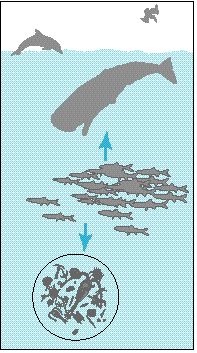
The pelagic fishes (Atlantic mackerel, Atlantic menhaden, Atlantic herring, bluefish, and butterfish) have a long-term potential yield of 900,000 metric tons and support a catch of 500,000 metric tons per year. Mackerel and herring, currently underutilized, were heavily fished by distant-water fleets from the mid-1960's to mid-1970's (Fig. 16). Their populations decreased to minimal levels around 1980 but have subsequently increased to present record-high levels, measured in excess of 2 million metric tons each (Northeast Fisheries Science Center 1993). Mackerel and herring stocks can support long-term potential yields of 200,000 and 120,000 metric tons, respectively. Bluefish, an important recreational species that supported catches as high as 76,500 metric tons in 1980, has since declined and is now overexploited. Atlantic menhaden, distributed from Canada to Florida, is fully utilized, with a long-term potential yield of 480,000 metric tons per year and recent annual catches of 360,000 metric tons.
|
Fig. 12. The removal of hundreds of thousands of metric tons of fishes through fishing activity may result in cascade effects down the marine food chain to phytoplankton and zooplankton, and up the food chain to marine birds and mammals. |
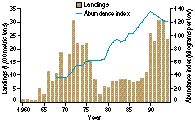
The long-term potential yield of highly migratory pelagic fishes in the Atlantic (such as swordfish, bluefin tuna, yellowfin tuna, bigeye tuna, albacore, skipjack tuna, blue marlin, white marlin, sailfish, and spearfish) is about 250,000 metric tons, less than 20,000 metric tons of which is the U.S. share (prorated based on previous catches). Recent catches have averaged about 230,000 metric tons worldwide, with 16,000 metric tons taken by the United States (Fig. 17). Virtually all the species are either fully or overutilized, with the abundance of several species (for example, swordfish, bluefin tuna, and marlin) below or far below optimal levels.
|
Fig. 13. Landings and abundance index of Northeast skates and dogfish, 19601994 (from National Oceanic and Atmospheric Administration 1996). |
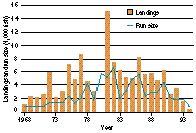
Little is known about the abundance of large and small coastal and pelagic sharks in the Atlantic, but their long-term potential yield is estimated to be about 10,000 metric tons per year, the level of current catches. Sharks traditionally were fished moderately, but in recent years, large coastal sharks have been particularly subject to increased fishing pressure, resulting in overexploitation (Fig. 18).
|
Fig. 14. Spawning run size of Atlantic salmon returning to Maine rivers, and total catch by U.S. anglers and at-sea catch by foreign vessels, 19681994 (from National Oceanic and Atmospheric Administration 1996). |
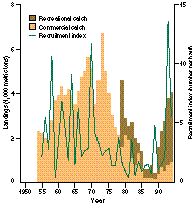
Valuable crustacean and molluscan resources occur in offshore and nearshore (estuarine) waters. Offshore species such as American lobster, sea scallop, Atlantic surfclam, ocean quahog, long-finned squid, short-finned squid, and northern shrimp have a long-term potential yield of 160,000-200,000 metric tons, with smaller recent landings. Their population status and trends are summarized in Table 2. With the exception of short-finned squid, all are either fully utilized or overutilized. Sea scallops in particular (7,400 metric tons landed in the Northeast region in 1993; Fig. 19), and to a lesser extent lobsters in the Gulf of Maine (25,500 metric tons landed in 1993 throughout the Northeast; Fig. 20), are exploited at rates exceeding management definitions of overfishing. Sea scallops, whose reproductive success exhibits high annual variability, are now at a low level of abundance. Green sea urchins (for which we have no estimate of long-term potential yield) have been subjected to ever- increasing fishing pressure since a fishery began in 1987. Landings in 1993 were more than 19,000 metric tons, a three-fold increase from 1990, with a strong likelihood of overexploitation in some areas (for example, coastal Maine). Various species of crab (for example, Jonah, Atlantic rock, and red crabs), some found both offshore and nearshore, produced about 4,500 metric tons of landings in 1993 and are underutilized.
|
Fig. 15. Striped bass catch and recruitment index of young striped bass in Chesapeake Bay, 19501994 (from National Oceanic and Atmospheric Administration 1996). |
|
Nearshore and estuarine species (for example, eastern oysters, northern quahogs, softshell clams, blue mussels, bay scallops, whelks or conchs, and blue crabs) are generally fully or overutilized (Table 2) and have a long-term potential yield of about 100,000 metric tons (meat weight only, except for blue crab). Eastern oyster landings fell sharply in the late 1980's (Fig. 21) and are now, at about 11,000 metric tons per year, far below long-term potential yield. Populations in the principal historical eastern oyster areas, the Chesapeake and Delaware bays, are largely depleted by effects of disease (MSX and dermo); Connecticut now accounts for most eastern oyster production. Bay scallops, with recent landings averaging about 160 metric tons (1990-1992), are overexploited and at reduced levels of abundance. Recent landings of blue mussels (Fig. 22), with an uncertain long-term potential yield, have increased to an average 3,500 metric tons per year. Northern quahog (hardshell clam) landings (Fig. 22) are now fairly steady at about 4,700 metric tons per year and are probably overexploited. Softshell clams (average catches of 2,100 metric tons in 1990-1992; Fig. 22) appear to be fully exploited, with decreased abundance in Maryland and Maine. Blue crab off the Atlantic coast is fully utilized, with commercial landings averaging 44,000 metric tons per year since 1985 (Fig. 21). Their greatest concentration is in Chesapeake Bay, where the recreational harvest has made up approximately 30%-40% of the total catch in recent years. |
Table 2. Status and trends of selected crustaceans and mollusks in the Northeast region.
| Habitat/species |
Status and trend |
| Offshore |
|
| American lobster |
High abundance, overutilized, variable |
| Atlantic surfclam |
Average abundance, fully utilized, declining |
| Crabs |
High abundance, underutilized, relatively stable |
| Long-finned squid |
Average abundance, fully utilized, variable |
| Northern shrimp |
Average abundance, fully utilized, relatively stable |
| Ocean quahog |
Average abundance, fully utilized, declining |
| Sea scallop |
Low abundance, overutilized, variable |
| Sea urchins |
Average abundance, in danger of being overutilized, unknown trend |
| Short-finned squid |
Average abundance, underutilized, variable |
| Nearshore and estuarine |
| Bay scallop |
Low abundance, overutilized, relatively stable |
| Blue crab |
Average abundance, fully utilized, relatively stable |
| Blue mussel |
Average abundance, fully utilized, stable |
| Eastern oyster |
Low to depleted abundance, overutilized, stable |
| Hardshell clam |
Low abundance, overutilized, stable |
| Softshell clam |
Low abundance, overutilized, stable |
|
| | |
Marine Birds |
|
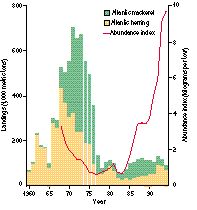
Marine birds, which breed, forage, or migrate through marine environments, consist of several ecological groupings. Some breeding marine birds nest on nearshore beaches, coastal cliffs, or islands near the coast. These species forage in either coastal, nearshore, or pelagic habitats during the breeding season--usually summer and fall--but often migrate to other regions during other seasons. During winter, marine birds that breed farther north may spend the winter living and foraging in more southern environments. For example, some birds that nest in the Canadian arctic and subarctic may be prevalent in the winter in the Northeast. Another group of marine birds found in all U.S. marine systems, sometimes in immense numbers, are birds that breed in tropical environments or in the Southern Hemisphere. Birds of this latter group are almost always found offshore near the continental shelf break and include tropicbirds, shearwaters, albatrosses, petrels, storm-petrels, and skuas.
|
Fig. 16. Landings of Atlantic herring and Atlantic mackerel in the Northeast region and their combined abundance index, 19601994 (from National Oceanic and Atmospheric Administration 1996). |
Buckley and Buckley (1984) reported that at least 20 marine bird species nest regularly in the Northeast region, while 9 others irregularly nest there or in the near vicinity. Schneider and Heinemann (1996) completed a recent overview of predominant marine birds inhabiting the Northeast shelf ecosystem. Gulls, terns, and herons are important species breeding within the ecosystem. Other species of marine birds that do not breed in the ecosystem are nevertheless important and occupy two ecological regimes within the ecosystem, coastal and pelagic. In the coastal zone, plovers, sandpipers, and other shorebirds are important predators of beach and intertidal invertebrates. Other nonbreeding but abundant species are for the most part pelagic, breeding in colonies around the margin of the northwestern Atlantic basin.
|
|
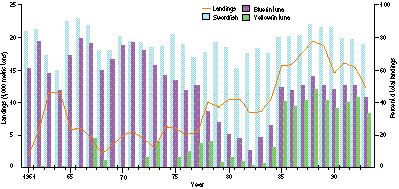
|
Fig. 17. U.S. landings of tunas, swordfish, marlins, and spearfish from the western North Atlantic Ocean, and percentages of selected species, 19601994 (from National Oceanic and Atmospheric Administration 1996). |
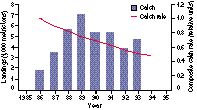
In the Gulf of Maine, the dominant bird populations include Leach's storm-petrel, great cormorant, razorbill, and Atlantic puffin. Farther south, terns, gulls, and jaegers are the dominant pelagic birds. Species abundances in the Northeast region are highly seasonal. The most numerous species in early summer is the sooty shearwater, a regular migrant from its Southern Hemisphere breeding areas; in late summer, Wilson's storm-petrel is more abundant. The greater shearwater is abundant in autumn. During winter, the ecosystem is inhabited by southward-migrating flocks of Iceland gulls, glaucous gulls, black-legged kittiwakes, Leach's storm-petrels, dovekies, and razorbills.
|
Fig. 18. Landings and relative catch rates of large coastal sharks in the western Atlantic Ocean and Gulf of Mexico by commercial vessels, 19851995 (from National Oceanic and Atmospheric Administration 1996). |
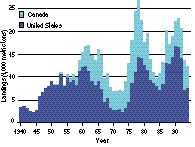
Researchers observed the changing population densities of pelagic marine birds during the National Oceanic and Atmospheric Administration's Marine Resources Monitoring, Assessment, and Prediction surveys of the Northeast shelf ecosystem, conducted from 1976 to 1988. Some of these pelagic marine species breed in the area, but others are only winter visitors or passage migrants, thus the trends revealed do not necessarily relate to breeding population sizes. Based on analysis of the surveys, northern fulmar, great black-backed gull, and herring gull populations declined from 1978 to 1980. Other species showing similar decreasing trends in abundance were greater shearwater, sooty shearwater, Cory's shearwater, Wilson's storm-petrel, black-legged kittiwake, and pomarine jaeger. Some of these species feed heavily on trawler-discarded offal at sea. Schneider and Heinemann (1996) hypothesized that as fish stocks decreased in abundance in the early 1980's, the amount of offal discarded at sea also declined, which may have reduced the survival of some marine birds. Another possibility is that the birds moved their foraging activities elsewhere. Significant year-to-year variability was observed among other marine birds, including ring-billed gulls, common terns, northern gannets, laughing gulls, Leach's storm-petrels, red phalaropes, and dovekies. The causes of this variability have not been determined.
|
Fig. 19. U.S. and Canadian landings of sea scallops from the mid-Atlantic coast, Gulf of Maine, and Georges Banks, 19401994 (from National Oceanic and Atmospheric Administration 1996). |
Marine Mammals |
|
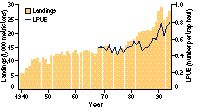
Since at least the 1500's, humans have interacted with marine mammals in waters off the coast of what is now the United States. Historically, much of this interaction has been the result of the whaling industry; although the last whaling in eastern U.S. waters took place around the 1920's, these interactions have continued. Along the New England coast, nonconsumptive "uses" of whales have replaced commercial whaling--whale watching has emerged as a multimillion dollar industry. It is probable that the economic value of whalewatching today exceeds that of whale harvesting in previous eras. Despite the general change in attitude of the American public to a nonconsumptive interest in marine mammals, as well as the recreational, educational, and research benefits of whalewatching, marine mammals today are still in jeopardy from human interactions, such as entanglement in fishing nets, bycatch (the incidental take of nontarget species), and ship collisions. The larger whales occasionally become entangled in fishing nets and line, which leads to their injury and reduced viability, although the animals often escape or are released. The smaller whales, primarily harbor porpoises and dolphins, are also caught in fishing nets, which is almost always fatal. Large whales are occasionally involved in vessel collisions, events that also may be fatal or leave an animal with debilitating injuries. Indirect effects of human influences are more difficult to assess but include habitat degradation and loss.
|
Fig. 20. Landings of American lobsters in U.S. waters, and landings per unit effort (LPUE) in Maine, 19401994 (from National Oceanic and Atmospheric Administration 1996). |
| |
|
|
|
Expanding seal populations result in more frequent interactions with coastal fishing activities and aquaculture facilities. Harbor seals and other species are an increasing component of the marine mammal bycatch of fisheries. The additional dimension of indirect fishery interactions is that marine mammals compete with humans (or vice versa) for food (fishes and squid).
|
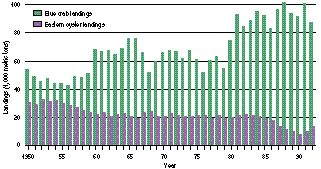
Fig. 21. Commercial landings of blue crabs and eastern oysters (19501992) along U.S. Atlantic and Gulf of Mexico coasts (from National Oceanic and Atmospheric Administration 1996). |
|
The Northeast region supports 34 stocks of at least as many species of marine mammals, for which the National Marine Fisheries Service has management responsibility (Table 3). Twenty-one of these species are classified as strategic stocks according to the 1994 amendments to the Marine Mammal Protection Act. Strategic stocks are those that are listed as endangered or threatened under the U.S. Endangered Species Act, are depleted under the Marine Mammal Protection Act, have total annual mortality rates that are not sustainable, or are those for which there are known removals but with uncertain status. Mortality of some strategic stocks exceeds their Potential Biological Removal (PBR), a management term set by 1994 amendments to the Marine Mammal Protection Act to define the removal rate beyond which a marine mammal stock would be impeded from recovery and reaching or maintaining its optimal sustainable population level. Under the Marine Mammal Protection Act, the short-term goal is to reduce incidental takes (mortality and serious injury caused by humans) to at or below PBR level. |
Table 3. Status and trends of marine mammal stocks in waters of U.S. jurisdiction.
| |
|
Region/species |
Area |
Minimum populationa |
Statusb |
| Alaska |
| |
Seals, sea lions, and walruses |
| |
|
Bearded seal |
Alaska |
N/A |
N/S |
| |
|
Harbor seal |
Bering Sea |
12,648 |
N/S |
| |
|
Harbor seal |
Gulf of Alaska |
22,427 |
N/S |
| |
|
Harbor seal |
Southeast Alaska |
35,226 |
N/S |
| |
|
Northern fur seal |
Eastern Pacific |
969,595 |
D |
| |
|
Ribbon seal |
Alaska |
N/A |
N/S |
| |
|
Ringed seal |
Alaska |
N/A |
N/S |
| |
|
Spotted seal |
Alaska |
N/A |
N/S |
| |
|
Northern sea lion |
Eastern U.S. stock |
37,166 |
T |
| |
|
Northern sea lion |
Western U.S. stock |
42,536 |
E |
| |
|
Pacific walrus |
Alaska |
188,316 |
N/S |
| |
Whales, dolphins, and porpoises |
| |
|
Baird's beaked whale |
Alaska |
N/A |
N/S |
| |
|
Beluga whale |
Beaufort Sea |
32,453 |
N/S |
| |
|
Beluga whale |
Bristol Bay |
1,316 |
N/S |
| |
|
Beluga whale |
Cook Inlet |
752 |
* |
| |
|
Beluga whale |
E. Chukchi Sea |
3,710 |
N/S |
| |
|
Beluga whale |
E. Bering Sea |
6,439 |
N/S |
| |
|
Bowhead whale |
W. Arctic |
7,738 |
E |
| |
|
Cuvier's beaked whale |
Alaska |
N/A |
N/S |
| |
|
Fin whale |
Northeast Pacific |
N/A |
E |
| |
|
Gray whale |
E. North Pacific |
21,597 |
N/S |
| |
|
Humpback whale |
Central North Pacific |
1,407 |
E |
| |
|
Humpback whale |
W. North Pacific |
N/A |
E |
| |
|
Killer whale |
E. North Pacific, northern resident |
764 |
N/S |
| |
|
Killer whale |
E. North Pacific, transient |
314 |
N/S |
| |
|
Minke whale |
Alaska |
N/A |
N/S |
| |
|
Northern right whale |
North Pacific |
N/A |
E |
| |
|
Sperm whale |
North Pacific |
N/A |
E |
| |
|
Stejneger's beaked whale |
Alaska |
N/A |
N/S |
| |
|
Pacific white-sided dolphin |
North Pacific |
486,719 |
N/S |
| |
|
Dall's porpoise |
Alaska |
76,874 |
N/S |
| |
|
Harbor porpoise |
Bering Sea |
8,549 |
N/S |
| |
|
Harbor porpoise |
Gulf of Alaska |
7,085 |
N/S |
| |
|
Harbor porpoise |
Southeast Alaska |
8,156 |
N/S |
| |
Sea otters and polar bears |
| |
|
Sea otter |
Alaska |
100,000 |
N/S |
| |
|
Polar bear |
Southern Beaufort Sea |
1,579 |
N/S |
| |
|
Polar bear |
Chukchi/Bering Sea |
N/A |
N/S |
Atlantic and Gulf of Mexico |
| |
Seals |
| |
|
Gray seal |
N.W. North Atlantic |
2,035 |
N/S |
| |
|
Harbor seal |
W. North Atlantic |
28,810 |
N/S |
| |
|
Harp seal |
N.W. North Atlantic |
N/A |
N/S |
| |
|
Spinner dolphin |
N. Gulf of Mexico |
4,465 |
N/S |
| |
|
Hooded seal |
N.W. North Atlantic |
N/A |
N/S |
| |
Whales, dolphins, and porpoises |
| |
|
Blainville's beaked whale |
N. Gulf of Mexico |
N/A |
N/S |
| |
|
Blainville's beaked whale |
W. North Atlantic |
N/A |
N/S |
| |
|
Blue whale |
W. North Atlantic |
N/A |
E |
| |
|
Bryde's whale |
N. Gulf of Mexico |
17 |
N/S |
| |
|
Cuvier's beaked whale |
N. Gulf of Mexico |
20 |
N/S |
| |
|
Cuvier's beaked whale |
W. North Atlantic |
895 |
* |
| |
|
Dwarf sperm whale |
N. Gulf of Mexico |
N/A |
* |
| |
|
Dwarf sperm whale |
W. North Atlantic |
N/A |
* |
| |
|
False killer whale |
N. Gulf of Mexico |
236 |
N/S |
| |
|
Fin whale |
W. North Atlantic |
1,704 |
E |
| |
|
Gervais' beaked whale |
N. Gulf of Mexico |
N/A |
N/S |
| |
|
Gervais' beaked whale |
W. North Atlantic |
N/A |
N/S |
| |
|
Humpback whale |
W. North Atlantic |
4,848 |
E |
| |
|
Killer whale |
N. Gulf of Mexico |
197 |
N/S |
| |
|
Killer whale |
W. North Atlantic |
N/A |
N/S |
| |
|
Long-finned pilot whale |
W. North Atlantic |
4,968 |
* |
| |
|
Melon-headed whale |
N. Gulf of Mexico |
2,888 |
N/S |
| |
|
Minke whale |
Canadian east coast |
2,053 |
N/S |
| |
|
North Atlantic right whale |
W. North Atlantic |
295 |
E |
| |
|
Northern bottlenose whale |
W. North Atlantic |
N/A |
N/S |
| |
|
Pygmy killer whale |
N. Gulf of Mexico |
285 |
N/S |
| |
|
Pygmy killer whale |
W. North Atlantic |
6 |
N/S |
| |
|
Pygmy sperm whale |
N. Gulf of Mexico |
N/A |
* |
| |
|
Pygmy sperm whale |
W. North Atlantic |
N/A |
* |
| |
|
Sei whale |
W. North Atlantic |
N/A |
E |
| |
|
Short-finned pilot whale |
N. Gulf of Mexico |
186 |
* |
| |
|
Short-finned pilot whale |
W. North Atlantic |
457 |
* |
| |
|
Sowerby's beaked whale |
W. North Atlantic |
N/A |
N/S |
| |
|
Sperm whale |
N. Gulf of Mexico |
411 |
E |
| |
|
Sperm whale |
W. North Atlantic |
1,617 |
E |
| |
|
True's beaked whale |
W. North Atlantic |
N/A |
N/S |
| |
|
Atlantic spotted dolphin |
N. Gulf of Mexico |
2,255 |
N/S |
| |
|
Atlantic spotted dolphin |
W. North Atlantic |
1,617 |
* |
| |
|
Atlantic white-sided dolphin |
W. North Atlantic |
19,196 |
N/S |
| |
|
Bottlenose dolphin |
E. Gulf of Mexico, coastal |
8,963 |
N/S |
| |
|
Bottlenose dolphin |
Gulf of Mexico, bay, sound, estuarine |
3,933 |
* |
| |
|
Bottlenose dolphin |
Gulf of Mexico, outer continental shelf |
43,233 |
N/S |
| |
|
Bottlenose dolphin |
Gulf of Mexico, shelf edge and slope |
4,530 |
N/S |
| |
|
Bottlenose dolphin |
W. North Atlantic, coastal |
2,482 |
D |
| |
|
Bottlenose dolphin |
W. North Atlantic, offshore |
8,794 |
N/S |
| |
|
Bottlenose dolphin |
N. Gulf of Mexico, coastal |
3,518 |
N/S |
| |
|
Bottlenose dolphin |
W. Gulf of Mexico, coastal |
2,938 |
N/S |
| |
|
Clymene dolphin |
N. Gulf of Mexico |
4,120 |
N/S |
| |
|
Common dolphin |
W. North Atlantic |
15,470 |
* |
| |
|
Fraser's dolphin |
N. Gulf of Mexico |
66 |
N/S |
| |
|
Pantropical spotted dolphin |
N. Gulf of Mexico |
26,510 |
N/S |
| |
|
Pantropical spotted dolphin |
W. North Atlantic |
1,617 |
* |
| |
|
Risso's dolphin |
N. Gulf of Mexico |
2,199 |
N/S |
| |
|
Risso's dolphin |
W. North Atlantic |
11,140 |
N/S |
| |
|
Rough-toothed dolphin |
N. Gulf of Mexico |
660 |
N/S |
| |
|
Spinner dolphin |
W. North Atlantic |
N/A |
N/S |
| |
|
Striped dolphin |
N. Gulf of Mexico |
3,409 |
N/S |
| |
|
Striped dolphin |
W. North Atlantic |
18,220 |
N/S |
| |
|
White-beaked dolphin |
W. North Atlantic |
N/A |
N/S |
| |
|
Harbor porpoise |
Gulf of Maine/ Bay of Fundy |
48,289 |
* |
| |
Manatees |
| |
|
West Indian manatee |
Antillean |
86 |
E |
| |
|
West Indian manatee |
Florida |
1,822 |
E |
Pacific and Western Pacific |
| |
Sea otters |
| |
|
Sea otter |
California |
2,376 |
E |
| |
|
Sea otter |
Washington |
360 |
N/S |
| |
Seals, sea lions, and walruses |
| |
|
Guadalupe fur seal |
Mexico to California |
3,028 |
T |
| |
|
|
|
|
|
| |
|
Harbor seal |
Washington, inland waters |
15,349 |
N/S |
| |
|
Harbor seal |
California |
27,962 |
N/S |
| |
|
Harbor seal |
Oregon to Washington, coastal |
25,665 |
N/S |
| |
|
Hawaiian monk seal |
Hawaii |
1,366 |
E |
| |
|
Northern elephant seal |
California, breeding |
51,625 |
N/S |
| |
|
Northern fur seal |
San Miguel Island |
5,018 |
N/S |
| |
|
California sea lion |
United States |
111,339 |
N/S |
| |
Whales, dolphins, and porpoises |
| |
|
Baird's beaked whale |
California to Washington |
252 |
N/S |
| |
|
Blainville's beaked whale |
Hawaii |
N/A |
N/S |
| |
|
Blue whale |
California to Mexico |
1,463 |
E |
| |
|
Blue whale |
Hawaii |
N/A |
E |
| |
|
Bryde's whale |
E. Tropical Pacific |
11,163 |
N/S |
| |
|
Bryde's whale |
Hawaii |
N/A |
N/S |
| |
|
Cuvier's beaked whale |
California to Washington |
6,070 |
N/S |
| |
|
Cuvier's beaked whale |
Hawaii |
N/A |
N/S |
| |
|
Dwarf sperm whale |
California to Washington |
N/A |
N/S |
| |
|
Dwarf sperm whale |
Hawaii |
N/A |
N/S |
| |
|
False killer whale |
Hawaii |
N/A |
N/S |
| |
|
Fin whale |
California to Washington |
747 |
E |
| |
|
Fin whale |
Hawaii |
N/A |
E |
| |
|
Humpback whale |
California to Mexico |
563 |
E |
| |
|
Killer whale |
California to Washington |
436 |
N/S |
| |
|
Killer whale |
Eastern N. Pacific, southern resident |
96 |
N/S |
| |
|
Killer whale |
Hawaii |
N/A |
N/S |
| |
|
Melon-headed whale |
Hawaii |
N/A |
N/S |
| |
|
Mesoplodont beaked whales |
California to Washington |
1,169 |
* |
| |
|
Minke whale |
California to Washington |
122 |
* |
| |
|
Pygmy killer whale |
Hawaii |
N/A |
N/S |
| |
|
Pygmy sperm whale |
California to Washington |
2,059 |
N/S |
| |
|
Pygmy sperm whale |
Hawaii |
N/A |
N/S |
| |
|
Sei whale |
E. North Pacific |
N/A |
E |
| |
|
Short-finned pilot whale |
California to Washington |
741 |
* |
| |
|
Short-finned pilot whale |
Hawaii |
N/A |
N/S |
| |
|
Sperm whale |
California to Washington |
896 |
E |
| |
|
Sperm whale |
Hawaii |
N/A |
E |
| |
|
Bottlenose dolphin |
California, coastal |
134 |
N/S |
| |
|
Bottlenose dolphin |
California to Washington, offshore |
1,904 |
N/S |
| |
|
Bottlenose dolphin |
Hawaii |
N/A |
N/S |
| |
|
Central American spinner dolphin |
E. Tropical Pacific |
N/A |
N/S |
| |
|
Common dolphin |
E. Tropical Pacific, central |
297,400 |
N/S |
| |
|
Common dolphin, long-beaked |
California |
5,504 |
N/S |
| |
|
Common dolphin |
E. Tropical Pacific, northern |
353,100 |
N/S |
| |
|
Common dolphin, short-beaked |
California to Washington |
309,717 |
N/S |
| |
|
Common dolphin |
E. Tropical Pacific, southern |
1,845,600 |
N/S |
| |
|
Eastern spinner dolphin |
E. Tropical Pacific |
518,500 |
D |
| |
|
Northern right whale dolphin |
California to Washington |
15,080 |
N/S |
| |
|
Pacific white-sided dolphin |
California to Washington |
82,939 |
N/S |
| |
|
Pantropical spotted dolphin |
Hawaii |
N/A |
N/S |
| |
|
Risso's dolphin |
California to Washington |
22,388 |
N/S |
| |
|
Risso's dolphin |
Hawaii |
N/A |
N/S |
| |
|
Rough-toothed dolphin |
Hawaii |
N/A |
N/S |
| |
|
Spinner dolphin |
Hawaii |
677 |
N/S |
| |
|
Spotted dolphin |
E. Tropical Pacific, coastal |
22,500 |
N/S |
| |
|
Spotted dolphin |
E. Tropical Pacific, northeastern |
648,900 |
D |
| |
|
Spotted dolphin |
E. Tropical Pacific, west/south |
1,145,100 |
N/S |
| |
|
Striped dolphin |
California to Washington |
19,248 |
N/S |
| |
|
Striped dolphin |
E. Tropical Pacific |
1,745,900 |
N/S |
| |
|
Striped dolphin |
Hawaii |
N/A |
N/S |
| |
|
Whitebelly spinner dolphin |
E. Tropical Pacific |
872,000 |
N/S |
| |
|
Dall's porpoise |
California to Washington |
34,393 |
N/S |
| |
|
Harbor porpoise |
Central California |
3,431 |
N/S |
| |
|
Harbor porpoise |
N. California |
7,640 |
N/S |
| |
|
Harbor porpoise |
Oregon to Washington, coast |
22,046 |
N/S |
| |
|
Harbor porpoise |
Washington, inland |
2,681 |
N/S |
aN/A = not available or not determined. |
| bN/S = no special status under the Endangered Species Act/ Marine Mammal Protection Act; D = depleted; T = threatened; E = endangered; and * = Marine Mammal Protection Act strategic stock because human-caused take exceeds potential biological removal. |
|
| | |
Fig. 22. Commercial landings of hardshell clams, softshell clams, and blue mussels (19501994) along U.S. Atlantic and Gulf of Mexico coasts (from National Oceanic and Atmospheric Administration 1996).
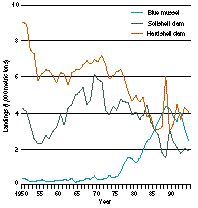
|
In the western North Atlantic, strategic stock species include endangered right whales, humpback whales, fin whales (Figs. 23 and 24), sei whales, blue whales, and sperm whales (Fig. 25); the mid-Atlantic coastal bottlenose dolphin, which is listed as depleted under the Marine Mammal Protection Act; and stocks whose estimated mortality exceeds PBR: Cuvier's beaked whale, dwarf sperm whale, long-finned pilot whale, pygmy sperm whale, short-finned pilot whale, Atlantic spotted dolphin, common dolphin, pantropical spotted dolphin, and the Gulf of Maine-Bay of Fundy harbor porpoise. Of these strategic stocks, North Atlantic right whales are believed to be increasing, Western North Atlantic coastal bottlenose dolphins are believed to be stable, and the population trends for the remaining species, such as the Atlantic white-sided dolphin (Fig. 26), are unknown.
|
In general, the distribution and abundance of marine mammals ebb and flow with the seasons. This phenomenon is almost solely linked to food, because cetacean (whale, dolphin, and porpoise) distributions are far from regular or random but almost always correspond with the location of food sources. Cetaceans generally enter the Northeast region in spring and circulate through the feeding grounds during summer and into fall. During the feeding season, cetaceans in the Northeast region probably intermix with animals of the Canadian Scotian shelf and northward. As the year wanes, whales migrate to wintering grounds in waters of the mid-Atlantic and southeastern United States, offshore deep-ocean areas, and the West Indies. A few individuals of most species, however, occupy the Northeast region throughout the winter.
|
Although some migration patterns have been described, it is generally observed that whales appear and disappear and that their whereabouts and habitats, when the animals are absent from their better-known feeding grounds, remain largely unknown. For most species, this is particularly true for the wintering and calving grounds. Where whales are concerned, the waters of the northeastern United States are not a discrete entity but rather part of a continuum that stretches through large sections of the Atlantic Ocean throughout the Northern Hemisphere. The various calving and feeding grounds are not residences but temporary stopping points.
|
In terms of numbers and ecological effects, marine mammals are significant components of the northeastern marine ecosystem, although many of their populations have been reduced in historical times. The fin whale and humpback whale, for example, are recovering from commercial depletion and presently represent the largest component of the cetacean population in northwest Atlantic waters; their abundance is estimated at 6,000 animals or more during the peak feeding season. The mid-Atlantic coastal and offshore populations of bottlenose dolphin are depleted following a significant die-off in 1987-1988. The abundance of harbor porpoises has been estimated at 47,200 individuals in the Gulf of Maine-Bay of Fundy area; they have been proposed for listing as threatened under the Endangered Species Act because their annual incidental death rate exceeds their birth rate. Populations of harbor seal, gray seal, harp seal, and hooded seal appear to be increasing and expanding their ranges along New England's coasts. The seasonal abundance and population trends of other marine mammals are not well known.
|
The majority of present research on and management activities for marine mammals is aimed at reducing resource use conflicts and mitigating adverse effects of interactions between humans and these animals. Research on northwest Atlantic marine mammal populations has focused on three primary questions: (1) Have fisheries interactions and other human-related activities directly or indirectly disadvantaged marine mammals or adversely altered their environment? (2) Are the depleted and endangered marine mammals recovering, and have adequate steps been taken to encourage their recovery? and (3) What management actions are and will be necessary in the future to minimize or avoid potential conflicts between marine mammal conservation and human activities, such as commercial fishing and coastal development? For example, in 1994, Cape Cod Bay, Stellwagen Bank, the Great South Channel, and coastal waters of the southeastern United States all were designated under the U.S. Endangered Species Act as critical habitats for the North Atlantic right whale. Amendments to the Marine Mammal Protection Act in 1994 and to the Northeast Multispecies Fishery Management Plan mandate a reduction in harbor porpoise bycatch, and research on gear modifications--including the use of acoustic deterrent devices--is directed at reducing interactions between fisheries and harbor porpoises.
|
Southeast Region
|
Environment and Physical Features
|
The Southeast region, including the islands of Puerto Rico and the U.S. Virgin Islands in the Caribbean, encompasses such diverse marine habitats as extensive coral reefs, salt marshes, tidal flats, seagrass and barrier islands, and nearshore, oceanic, and tropical island areas. The region is composed of three large marine ecosystems: the Gulf of Mexico (Brown et al. 1991), the Southeast shelf (Yoder 1991), and the Caribbean (Richards and Bohnsack 1990). The gulf and Southeast shelf ecosystems share many physical and ecological characteristics. Their fisheries have similar species compositions: both ecosystems have broad continental shelves with many coastal lagoons, estuaries, and marshes, and both systems support reefs with a tropical affinity and a complex multispecies structure. Also, both ecosystems are strongly influenced by Atlantic western boundary current systems (the Loop Current in the Gulf of Mexico and the Gulf Stream in the Southeast shelf), and both receive major freshwater outflows from large drainage systems bordered by extensive estuarine wetlands. Fishes and invertebrates of the insular shelf of the Caribbean ecosystem are similar to those of reefs in the other two systems but are influenced by quite distinct oceanic processes that occur as a result of the Antilles Current, tropical latitudes, and other conditions of the Caribbean.
|
The Gulf of Mexico ecosystem, "America's inland sea," is fed by warm tropical waters of the Caribbean, which enter through the Yucatan Straits (Fig. 27). This flow develops into the Loop Current and a number of associated eddies in the gulf (Fig. 2). Part of the water entering the gulf bends to the east, flows through the Straits of Florida, and joins the Florida Current. Some of the water flows farther north into the gulf and then veers to the east to form a clockwise gyre off west Florida. The remaining water turns west, traverses most of the width of the gulf, and contributes to a complex series of anticyclonic warm eddies that eventually exit through the Florida Straits, form the Florida Current, and flow into the Atlantic Ocean. There the water forms the Gulf Stream as it moves northward, carrying its warm waters along the South Atlantic coast (Rabalais and Boesch 1987). The circulation, hydrographic conditions, and productivity of the South Atlantic Bight are influenced by these Gulf Stream waters, which follow the shelf edge from the Straits of Florida to Cape Hatteras.
|
The Southeast shelf ecosystem is characterized by bays and sounds with extensive coastal marshes. These wetlands form unique habitats that provide important links to production of living marine resources. The Southeast shelf ecosystem accounts for almost 145,040 square kilometers of estuarine drainage, extending from the temperate latitudes of North Carolina to the tropics of southern Florida and the northern Gulf of Mexico (National Oceanic and Atmospheric Administration 1990a). The largest estuary of the Southeast shelf is the combined Albemarle and Pamlico sounds. The Gulf of Mexico ecosystem accounts for more than 248,640 square kilometers of estuarine drainage, extending from south Florida to the Texas-Mexico border. Major features include the Mississippi and Atchafalaya deltas, which form a complex web of estuarine channels and extensive coastal wetlands that are important habitat for many fisheries. This region has the largest estuarine drainage area of all the U.S. regions. The fluvial drainage areas of the Mississippi and Atchafalaya rivers receive water from more than half of the contiguous United States. This drainage system creates tremendous freshwater flow into estuaries, accounting for about half of all the water discharged to U.S. estuaries.
|
Although wetlands are extensive in the Southeast region, an estimated 1,295 square kilometers of these wetlands were lost each year between the mid-1950's and late 1970's (Day and Craig 1981) because of sea-level rise, land subsidence, and human alterations such as channelization of estuaries, canal dredging through wetlands to accommodate oil and gas production, and impoundments (see chapter on Coastal Louisiana). The dense swamps and marshes of much of the region historically restricted coastal development. However, draining of wetlands uncovered an immensely fertile soil that expanded agricultural activity, particularly in the Mississippi delta and areas near the Florida Everglades. Conflicts over multiple uses of resources abound in this region, where the major population centers are growing rapidly. The Southeast's human population is expected to grow by almost 26% over the next 20 years, a faster rate than most other coastal regions in the country (Culliton et al. 1990).
|
|
Primary and Secondary Production |
|
Primary and secondary production are enhanced by upwelling. Upwellings of the tropical and lower temperate waters of the Southeast shelf ecosystem, however, are not as intense and evident as in the higher latitude regions. More important to production in this ecosystem is the role of ichthyoplankton, the component of plankton made up of larval fishes. In the Gulf of Mexico ecosystem, four distinct groups of ichthyoplankton species have been identified: estuarine-dependent, coastal, reef (local or tropical), and oceanic. The general life history pattern of the estuarine-dependent species of the Gulf of Mexico and Southeast shelf ecosystems is characterized by fish that spawn in shallow (less than 200 meters), nearshore waters, with postlarval and juvenile stages inhabiting estuaries. How well the larvae survive--and how effectively they are recruited to estuarine nursery areas--is largely controlled by tides, prevailing winds, and surface currents.
|
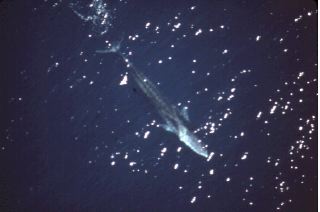
Fig. 23. The fin whale, the most abundant large cetacean in the western North Atlantic. Courtesy Cetacean and Turtle Assessment Program, University of Rhode Island |
The coastal species are a diverse group of finfish and shellfish that complete all or most of their life cycle in the open ocean or deepwater realms associated with the continental shelf. This group is believed to undergo extreme fluctuations in abundance, probably in response to changes in environmental conditions on the shelf. The locations of principal spawning areas of coastal species and the factors that may determine the species' reproductive success and ultimate recruitment are poorly known. Because spawning usually occurs in shelf waters, major oceanic phenomena, such as gravity-oriented current boundaries or eddies, and riverine fronts may offer key microhabitats for successful reproduction and recruitment of coastal species.
|
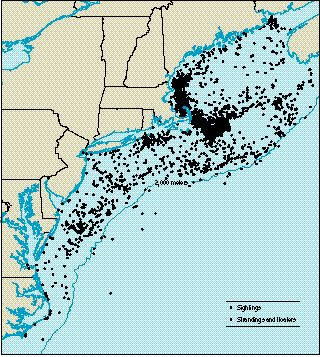
Fig. 24. Sightings of the fin whale from 1966 to 1989 (n = 3,858) in the Northeast region. The 2,000-meter depth contour defines the boundary of the survey area. During the peak spring summer feeding season, there may be between 2,500 and 3,000 fin whales in the Northeast region waters. Modified from Hain et al. (1992). Strandings and floaters are dead whales found ashore or at sea. |
The reef species in the Southeast region spawn virtually continuously, maximizing the potential recruitment of young to a reef. For many reef fishes and invertebrates, spawning is believed to be related to lunar--thus tidal--conditions in a regular fashion that promotes local retention of larvae. Recruitment has been thought to vary little, regulated more by the availability of suitable habitat than by oceanic conditions or number of spawning stock. The oceanic species spend their entire life cycles in the oceanic waters of the Gulf of Mexico and the South Atlantic.
|
Recent studies indicate that species richness of ichthyoplankton in the Gulf of Mexico ecosystem--in these very different groups--is among the highest of all regions currently reported. A recent gulfwide study by Richards et al. (1993) documented 100 families, including many deepwater species, taken in 87 plankton tows along the boundary of the Loop Current, the major hydrographic feature in the Gulf of Mexico. The boundary was determined by real-time satellite images of the Loop Current.
|
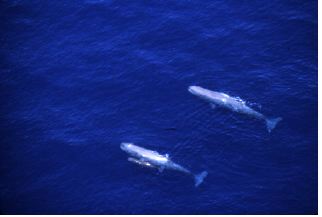
Fig. 25. Sperm whales in deep water over the continental slope just south of Georges Bank. Courtesy Cetacean and Turtle Assessment Program, University of Rhode Island |
Benthic Resources |
|
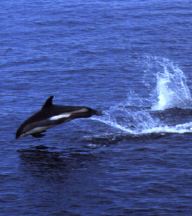
Most studies of the benthic community in the Gulf of Mexico and Southeast shelf ecosystems have been concerned with the characterization of the fauna. Patterns of community composition (Harper and McKinney 1980; Baker et al. 1981) vary by substrate and by factors associated with the depth gradient, such as temperature and temperature variability, freshwater plumes, changes in sediment particle sizes, and the decreasing effects of wind-forced hydraulic factors, including hurricanes (Tenore 1979). The soft-bottom communities are generally dominated by polychaete worms (47%-51%), crustaceans (28%-29%), and mollusks (10%-17%). Hard-bottom communities are characterized by animals and plants living on the bottom surface, including macroalgae, coralline algae, sponges, soft coral, and often patches of the fungus Agaricia. Other areas of soft-bottom sands may be covered with layers of coralline algae nodules or with an algal nodule pavement with Agaricia accumulations (Woodward-Clyde Consultants and Continental Shelf Association, Inc., 1983). Characteristically, the benthic fauna of the north inner shelf is an extension of the warm temperate Carolinian province, with divisions at the Rio Grande and east of the Mississippi delta. The southern portion of the South Texas Continental Shelf is inhabited by a more tropical Caribbean fauna. The fauna of the outer shelf of the northwestern gulf has more definite tropical affinities than those of the warm temperate inner shelf.
|
Fig. 26. The white-sided dolphin is the most abundant dolphin in continental shelf waters of the northeastern United States.
Courtesy Cetacean and Turtle Assessment Program, University of Rhode Island |
Overall, the mollusk populations (oysters, clams, conchs, and so forth) in the Southeast region have declined from the levels of 100 years ago. Much of this decline is attributed to disease, overexploitation, and habitat degradation. Habitat degradation is best measured by an index developed by Engle et al. (1994), which is designed for broad spatial generalizations of ecological conditions. Benthic data from selected study sites can be used to estimate the percentage of surface area that exhibits benthic community structures similar to those attributed to known degraded sites. Engle et al. (1994) indicated that 31% of the sediments in the Gulf of Mexico estuaries contained degraded benthic communities. They also noted that 27% of large estuaries, 41% of small estuaries, and 80% of Mississippi River sites exhibited low benthic index scores. These results indicate intense destructive pressures on coastal habitats in the Southeast shelf ecosystem.
|
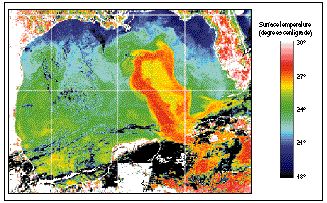
Fig. 27. Color satellite photo showing surface water temperature profiles for the Gulf of Mexico, as detected by a National Oceanic and Atmospheric Administration satellite. |
Losses of submersed aquatic vegetation, such as reduction of seagrass beds and destruction of coral reefs due to coral bleaching, are occurring throughout the region, resulting in continued loss of primary nursery habitat. Coral reefs of the Gulf of Mexico and Southeast shelf ecosystems are also subjected to harvest of live rock, where part of the reef is taken for the purpose of selling the attached flora and fauna by the aquarium industry. Because of the destructive nature of this industry, it is currently coming under management by the Gulf of Mexico and South Atlantic fishery management councils.
|
|
|
Fisheries Resources |
|
Over the past 40 years, the National Marine Fisheries Service has assembled a vast data base identifying stocks of marine organisms from the Southeast region. Much effort has been directed toward developing an inventory of species. This work has resulted in an extensive data base of hundreds of new geographical records and an expanding list of previously undescribed species and genera (Donaldson et al. 1996). Additionally, many other state and federal agencies collect and make available resource data from the Southeast region. These data are used in conjunction with the National Marine Fisheries Service data for analysis of management recommendations. Included in this data source are the departments of Interior and Defense, the Environmental Protection Agency, and the several states in the region, as well as other elements within the Department of Commerce, National Oceanic and Atmospheric Administration.
|
|
|
|
The major fishery resources in the Southeast region are the Southeast and Caribbean invertebrates, gulf menhaden, gulf butterfish, Atlantic shark, Atlantic and Gulf of Mexico coastal pelagic fishes, Atlantic-Gulf of Mexico- Caribbean reef fishes, Southeast drum and croaker, Atlantic highly migratory species, and nearshore fishery resources. Many of these resources are harvested by both the commercial and recreational fisheries. Table 4 provides information on the status of each of these groups. |
Table 4. Status and trends of major fish resources in the Southeast region.
| Species |
Status and trend |
| Atlantic croaker |
Below-average abundance and overutilized, unknown |
| Butterfish |
Above-average abundance and underutilized, stable |
| Menhaden |
|
| Atlantic |
Low abundance and fully utilized, stable |
| Gulf of Mexico |
Average abundance and fully utilized, increasing |
| Red drum |
|
| Atlantic |
Below-average abundance and overutilized, unknown |
| Gulf of Mexico |
Below-average abundance and overutilized, unknown |
| Atlantic sharks |
|
| Large coastal sharks |
Below-average abundance, overutilized, probably declining |
| Small coastal sharks |
Above-average abundance, fully utilized, probably declining |
| Pelagic sharks |
Unknown abundance and trend |
| Billfishes |
|
| Blue marlin/North Atlantic |
Unknown abundance and trend, overexploited |
| Sailfish/West Atlantic |
Unknown abundance and trend, moderately exploited |
| Swordfish/North Atlantic |
Below-average abundance, overexploited, unknown |
| White marlin/North Atlantic |
Unknown abundance and trend, overexploited |
| Coastal pelagic fishes |
|
| Cero |
Unknown status and trend |
| Cobia |
Unknown status and trend |
| Dolphin |
Unknown status and trend |
| King mackerel/South Atlantic |
Average abundance, underexploited, stable |
| King mackerel/Gulf of Mexico |
Low abundance, overexploited, stable |
| Spanish mackerel/South Atlantic |
Average abundance, overexploited, stable |
| Spanish mackerel/Gulf of Mexico |
Low abundance, overexploited, declining |
| Oceanic pelagic fishes |
|
| Albacore/North Atlantic |
Unknown abundance and trend, fully exploited |
| Bigeye tuna/Atlantic |
Unknown abundance and trend, fully exploited |
| Bluefin tuna/West Atlantic |
Below abundance of 1970's, unknown |
| Skipjack tuna/West Atlantic |
Unknown abundance and trend, fully exploited |
| Yellowfin tuna/West Atlantic |
Unknown abundance and trend, approaching full exploitation |
|
| | |
Southeast and Caribbean Invertebrates
|
The Southeast and Caribbean invertebrate fisheries are important both recreationally and commercially and include shrimps, Caribbean spiny lobster, stone crab, conches, and corals. Shrimps support one of the most valuable U.S. fisheries, based on revenue accumulated after harvest. Some fisheries, such as those for spiny lobsters and stone crab, have only moderate value on a national basis but are valuable regionally (Southeast Fisheries Science Center 1995).
|
Penaeid shrimp have been harvested commercially since the late 1800's. Nine species of shrimps contribute to the U.S. shrimp fishery in the Gulf of Mexico and the Atlantic, of which brown shrimp, white shrimp, and pink shrimp make up more than 95% of the commercial harvest. Other species harvested commercially include the royal red shrimp, seabob shrimp, and rock shrimp. These species are generally found in all continental shelf waters in the U.S. Atlantic and the Gulf of Mexico inside 110-meter depths. In the Gulf of Mexico, the largest densities of brown shrimp occur off the Texas-Louisiana coast, the largest concentration of white shrimp occurs off the Louisiana coast, and the greatest densities of pink shrimp occur off the southwestern coast of Florida. Along the south Atlantic, the center of abundance for white shrimp is off the Georgia and South Carolina coasts, while the center of abundance for brown shrimp is off the North Carolina and South Carolina coasts.
|
|
Each shrimp species is assessed as two stocks: Gulf of Mexico and U.S. Atlantic. Shrimp in the Southeast are harvested year-round; however, peak seasonal shrimping is species-specific. Shrimp management is under both state and federal control. The commercial fisheries in the Exclusive Economic Zone are managed under federal fishery management plans. Each of the eight states in the Southeast region uses different management measures to control the harvest of shrimp under its jurisdiction. The status and trends of the stocks are summarized in Table 5. |
Table 5. Status and trends of major invertebrate populations in the Southeast region.
| Species |
Status and trend |
| Brown shrimp |
|
| Gulf of Mexico |
High abundance, fully exploited, stable |
| Atlantic |
High abundance, fully exploited, stable |
| Pink shrimp |
|
| Gulf of Mexico |
Historical low abundance, fully exploited, depressed |
| Atlantic |
Unknown abundance and trend |
| Spiny lobster |
|
| Southeastern United States |
Below-average abundance, overutilized, trend unknown |
| Caribbean |
Average abundance, stable |
| Stone crab |
Average abundance, stable to declining |
| White shrimp |
|
| Gulf of Mexico |
Average abundance, fully exploited, stable |
| Atlantic |
Average abundance, fully exploited, stable |
|
| | |
The average annual shrimp catch from the Gulf of Mexico during 1980-1992 was 107,340 metric tons. The largest catch occurred in 1986 (137,949 metric tons) and the smallest in 1983 (86,484 metric tons). On average, brown shrimp account for 57%, white shrimp 31%, and pink shrimp 8% of the total shrimp catch. The other six commercially harvested shrimp species combined account for only 4% of the total. Currently the fishery is overcapitalized, with more effort being expended than is reasonably necessary to harvest the shrimp.
|
Gulf of Mexico brown shrimp and white shrimp catches have increased significantly over the past 34 years. Pink shrimp catches were level until 1985; all shrimp landings declined in recent seasons. The number of young brown shrimp produced per parent has increased significantly, but white shrimp have not increased. The increase in brown shrimp appears related to marsh alterations. Coastal subsidence and sea-level rise in the northwestern gulf inundate intertidal marshes longer, allowing the shrimp to feed for longer periods within the marsh area. In the gulf, both factors have also expanded estuarine areas, created more marsh edges, and provided more protection from predators. As a result, the nursery function of those marshes has been magnified and brown shrimp production has expanded. However, continued subsidence will lead to marsh deterioration and ultimate loss of supporting wetlands, and current high fishery yields may not be sustainable. Pink shrimp landings reached an all-time low in 1989 and remained lower than the pre-1986 average. Catches began to recover in 1993 and 1994 and exceeded the pre-1986 average in 1995. All commercial shrimp are harvested at maximum levels.
|
|
|
Annual catches of spiny lobsters were stable during the 1980's, running about 2,700 metric tons for the Gulf of Mexico. On Florida's Atlantic coast, catches averaged 230 metric tons. This fishery is considered overcapitalized. The recreational fishery is large, but its catch is unknown. Southeastern lobster stock levels remain below the long-term potential yield. Annual catches for Puerto Rico averaged 136 metric tons over the past 23 years. These stocks now appear to be overutilized. U.S. Virgin Islands catches for 1980-1991 were fairly stable and averaged 27 metric tons (Southeast Fisheries Science Center 1995).
|
|
|
Annual catches of stone crab (based on claw weight) varied from 1,200 to 1,400 metric tons in the Gulf of Mexico through the 1980's. Atlantic coast catches averaged around 34 metric tons. Fishing efforts on stone crabs more than doubled during the period from 1979-1980 (295,000 traps set) to 1992-1993 (686,000 traps set) but have been relatively stable in recent years. Thus, more of the catches have been harvested earlier, which has shortened the fishing season. It is unlikely that recent catch levels can be sustained on a long-term basis (Southeast Fisheries Science Center 1995).
|
|
|
| Southeast Menhaden and Butterfish |
|
Menhaden are a herringlike species found in coastal and estuarine waters of the U.S. Southeast shelf and Gulf of Mexico ecosystems. The menhaden fishery, one of the larger and older fisheries in the United States, is managed by individual states, with coordination handled by the Atlantic States Marine Fisheries Commission and the Gulf States Marine Fisheries Commission. The Atlantic menhaden population is fully utilized, with a long-term potential yield of 480,000 metric tons per year and recent average catch of 360,000 metric tons (Fig. 28). In the Gulf of Mexico, the fish is also fully utilized, with a long-term potential yield of 660,000 metric tons and recent average catch of 500,000 metric tons (Southeast Fisheries Science Center 1995; Fig. 28).
|
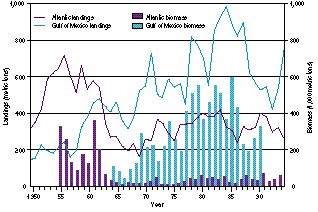
Fig. 28. Landings and spawning biomass trends of menhaden populations in the Southeast region. |
Abundance of the Atlantic menhaden stock has been low for 30 years and is expected to remain low; however, this fishery is in a rebuilding phase (Table 4). The fishery is supported mainly by young recruit fish. Although Atlantic menhaden may live 10 years, most fish of the catch are 3 years of age or younger because of the biology of the species and the economic dependence of the industry on whatever fish are present, regardless of their age. Thus, overuse because of growth overfishing--or harvest of small fish that could have been significantly larger and heavier if they had survived to an older age--is a prime management concern for this stock. The spawning biomass of the Gulf of Mexico stock has been much higher than the Southeast shelf stock. Menhaden abundance is at average historical levels, having declined by more than 50% from its 1983 peak level. The fishery bottomed out in 1992, and there is now an upswing in recruitment. Gulf menhaden may live for 5 years, but most landed are 1 or 2 years old. Because the gulf stock is short-lived and has a high natural mortality, growth overfishing has not been a management concern.
|
|
|
In 1986, a directed bottom trawl fishery for gulf butterfish began. Currently, only one or two vessels target butterfish, and the fishery is not regulated. Gulf butterfish are underutilized, with a long-term potential yield of 26,500 metric tons and recent average catch of 19,700 metric tons. Butterfish incidentally captured by offshore Gulf of Mexico shrimp fleets have composed from 80% to 97% of the annual catch since 1986. The abundance and trends of the stock are not well known.
|
|
|
| Atlantic-Gulf of Mexico Sharks |
|
About 350 species of sharks are known worldwide. Of those, 72 species frequent the waters of the U.S. Atlantic, the Gulf of Mexico, Puerto Rico, and the U.S. Virgin Islands. Both recreational and commercial shark fishermen seek coastal sharks along the Atlantic seaboard. Pelagic sharks are targeted by tournament anglers off the mid-Atlantic states and are incidentally caught by swordfish and tuna longliners. Nontournament anglers usually catch small coastal sharks that are generally not targeted by commercial fisheries. The Gulf of Mexico shrimp fishery catches and discards many small coastal sharks. There is also a mobile longline fishery targeting large coastal sharks both in the Atlantic and gulf waters, taking several species that are important to anglers. Many other fisheries catch sharks as bycatch which, depending on the species, are either discarded or marketed.
|
|
|
The long-term potential yield of the large coastal sharks is 3,400 metric tons, and the recent average catch has been 3,800 metric tons. The resource is currently overutilized (Table 4). The small coastal sharks have a long-term potential yield of 3,600 metric tons, and the recent average catch is 3,000 metric tons. This fishery is believed to be fully utilized. The long-term potential yield for the pelagic sharks is currently unknown, but the recent average catch is 2,730 metric tons. The status of use for this group is unknown.
|
|
|
Data are lacking on shark population dynamics. Anecdotal information indicates that the shark populations in the Southeast are declining. Sharks grow and reproduce slowly, thus they are very vulnerable to overfishing. Recently, a new fishery management plan has been implemented to prevent overfishing, prohibit the practice of finning, discourage the discarding of shark carcasses, rebuild currently overfished stock, and improve data collection (Southeast Fisheries Science Center 1995).
|
|
|
| Coastal Pelagic Fishes |
|
Coastal pelagic fishes inhabiting waters off the southeastern United States include king mackerel, Spanish mackerel, cobia, dolphin, and cero. These species range in coastal and continental shelf waters from the northeastern United States through the Gulf of Mexico and the Caribbean Sea and as far south as Brazil. In 1990, more than 90% of coastal pelagic fishes in the Southeast were landed in Florida. Commercial fisheries harvest Spanish mackerel by hook and line. A recreational fishery also exists for Spanish mackerel, accounting for about 25%-42% of the landings of this species. King mackerel are commercially fished from Chesapeake Bay southward. Major production areas include North Carolina and the lower east coast of Florida (Cape Canaveral to Palm Beach), the Florida Keys, and Grand Isle, Louisiana (Southeast Fisheries Science Center 1995).
|
|
|
During 1979-1991, recreational fishermen caught 8,000-17,000 metric tons per year of coastal pelagic fishes, and commercial fishermen caught 5,000-14,000 metric tons per year. King mackerel and Spanish mackerel account for about 95% of all coastal pelagic fishes harvested. The long-term potential yield for this group was estimated to be 22,554 metric tons, and recent average catches were 11,104 metric tons. As a group, coastal pelagic fishes yield only about 56% of long-term potential yield, and certain species are fished near or over maximum production levels (Table 4). Three of the four mackerel stocks are considered overfished. The gulf king mackerel stock is believed to have a large long-term potential yield but is currently severely depleted. Accurate assessment of the status of cobia and dolphin is not yet possible.
|
|
|
Coastal pelagic fishes are jointly managed under the Coastal Migratory Pelagic Resources Fishery Management Plan and the regulations adopted by the South Atlantic and Gulf of Mexico fishery management councils, and are implemented by the National Marine Fisheries Service. Only U.S. fisheries are regulated, although Mexican catches are thought to be large.
|
|
|
| Oceanic Pelagic Fishes |
|
The Atlantic oceanic pelagic fishes are wide-ranging and highly migratory. A broad array of species make up this complex, which is harvested by international fishing fleets. The United States is among the major harvesting nations for some of these species (Southeast Fisheries Science Center 1995). The status and trends of these resources are summarized in Table 4.
|
|
|
Northern bluefin tuna is a large migratory pelagic species that is found in the Atlantic and Pacific oceans. In the western Atlantic, bluefin tuna occur from Labrador and Newfoundland south into the Gulf of Mexico, the Caribbean Sea, and off Brazil. The peak yields of bluefin tuna from the western Atlantic (about 8,000-19,000 metric tons) occurred in 1963-1966, when much of the catch was taken by longlines off Brazil. The most recent assessment of west Atlantic bluefin tuna, which was carried out by the International Commission for the Conservation of Atlantic Tunas in 1991 using catch and effort data through 1990, showed that all size classes of fish were substantially below the 1970 levels. The rate of decline slowed with the imposition of catch restrictions in 1982. The long-term potential yield for the stock was estimated at 3,000-13,000 metric tons. Best estimates of current potential yield in the western Atlantic were about 2,000 metric tons. The recent average catch for 1989-1991 was 2,850 metric tons, of which 62% (1,760 metric tons) was taken by U.S. anglers.
|
|
|
Populations of yellowfin tuna are found worldwide in tropical waters. In the Atlantic, their greatest concentrations have been between the equator and the 15° latitudes. However, migrations take place to the north and the south along the North American east coast, and as a result, coastal concentrations of yellowfin tuna are found seasonally off the northeastern United States and Uruguay. In addition, substantial concentrations of yellowfin are found in the Gulf of Mexico. The long-term potential yield was estimated at 33,000 metric tons, with 30% located in the gulf. There is no estimate of the current potential yield; however, the recent average annual catch was 30,000 metric tons for the total stock, with the United States taking 6,200 metric tons. Status of the gulf stock is currently unknown, but a 1991 review suggested that the stock in the Gulf of Mexico may be approaching full exploitation (Southeast Fisheries Science Center 1995).
|
|
|
Bigeye tuna are found in tropical oceans around the world. In the Atlantic they are widely distributed in both tropical and temperate waters, between 45°N and 45°S latitudes. Bigeye tuna catch has increased from levels seen in the early 1960's to a peak of 74,500 metric tons in 1985. Roughly two-thirds of the catch was taken in longline fisheries, with the remaining catch taken by surface gear. Japanese longliners accounted for 40% of total landings in 1991. The long-term potential yield ranged from 61,200 to 74,000 metric tons. There is no estimate of the current potential yield. Recent average catch for the stock is 69,200 metric tons, with the United States taking 782 metric tons. This fishery resource is thought to be fully exploited (Southeast Fisheries Science Center 1995).
|
|
|
Albacore tuna are found in tropical and temperate waters of all oceans and range from 40°S to 50°N latitude. Albacore generally do not grow as large as bluefin, bigeye, or yellowfin tuna of a similar age. The number of North Atlantic albacore catches has declined from 1964 to 1995. Peak catches occurred in 1964, when 64,400 metric tons were landed. The catch was 26,134 metric tons in 1995. Most of the recent catches were taken in surface fisheries, mainly by bait boats and trolled lines, although drift gillnets and pelagic trawls were also used. Before 1987, up to 50% of the catch was by longline gear. In 1993, the International Commission for the Conservation of Atlantic Tunas estimated the long-term potential yield for North Atlantic albacore to range from 37,340 to 68,930 metric tons. There is no estimate of the current potential yield. The recent average catch for the stock was 30,850 metric tons, of which the United States landed 376 metric tons. This fishery is considered to be fully exploited (Southeast Fisheries Science Center 1995).
|
|
|
Skipjack tuna--a relatively small tuna--occurs in tropical and warm temperate seas. The western Atlantic skipjack catch has dramatically increased in recent years from relatively low levels during 1960-1979 to a peak of 40,000 metric tons in 1985. The long-term potential yield for western Atlantic skipjack was estimated at 33,000 metric tons. Its current potential yield is unknown. The recent average catch was 26,900 metric tons, of which the United States harvested 357 metric tons. This resource is considered fully exploited.
|
|
|
At least five species of tunas are included in the "other tuna" category. They include Atlantic bonito, little tunny, frigate tuna, blackfin tuna, and wahoo. Others may also be included but are not discriminated to species level in the international landings statistics. In the Atlantic, the recent average catch of this tuna group (1989-1991) totaled 51,600 metric tons; about 732 metric tons were taken through U.S. fishing efforts (Southeast Fisheries Science Center 1995).
|
|
|
The billfish fishery in the Atlantic Ocean includes swordfish, blue marlin, white marlin, sailfish, and longbill spearfish. The swordfish is the most widely distributed billfish, with the widest water temperature tolerance; they are found in waters with surface temperatures ranging from 5°C to 27°C. Their preferred habitat is near the edge of continental shelves in waters 100-3,000 meters deep, near oceanic frontal zones, and near seamounts and mid-ocean islands. The swordfish fishery is conducted mainly by longline fleets, with the Spanish and U.S. fleets dominating recent catches. These two nations have accounted for about 76% of the total North Atlantic swordfish catch in recent years. The catch and effort data showed a continual increase from 1978, when the United States eased its mercury-content regulation, to a peak catch of nearly 20,000 metric tons in 1987. Since 1987, catches have continued to decline under effort reduction. The species' long-term potential yield is estimated to be between 11,600 and 16,800 metric tons. Its current potential yield ranges from 8,000 to 14,200 metric tons. The recent average catch was 15,300 metric tons, with the United States taking 5,400 metric tons. This fishery is considered overexploited (Southeast Fisheries Science Center 1995).
|
|
|
The other billfish species are taken mostly as incidental catch in the commercial tuna and swordfish fisheries. There is also a growing recreational fishery targeting billfishes by the United States and many other countries in the Caribbean Sea and the eastern Atlantic. The recent development and geographical expansion of longline fisheries in the Gulf of Mexico for tuna and in the Caribbean for swordfish and tunas, as well as geographical expansions of the longline fleet off Africa, are raising concern for the welfare of billfish populations. The growth of these fisheries is expected to result in increased discard mortalities of billfish. Assessment of billfish stocks has generally been hampered by data limitations. Because of domestic concern over the future prospects for billfish resources, U.S. restrictions of billfish landings were implemented in October 1988 under the United States Fishery Management Plan for Atlantic Billfishes. The plan eliminates possession and sale of billfish by commercial fishermen and uses size limits to restrict the allowable catch of billfish by recreational gear (rod and reel).
|
|
|
The long-term potential yields for blue marlin and white marlin were estimated to be 1,718 metric tons and 593 metric tons, respectively. There are no estimates of their current potential yield. Recent average catches were 1,183 metric tons (253 metric tons by the United States) for blue marlin and 253 metric tons (63 metric tons by the United States) for white marlin. Both species are believed to be overexploited. Neither long-term potential yield nor current potential yield is known for sailfish. Its recent average catch was 619 metric tons, with the United States harvesting 32 metric tons annually (Southeast Fisheries Science Center 1995). The sailfish fishery is thought to be moderately exploited (Table 4).
|
|
|
| Reef Fishes |
|
Reef fishes include more than 100 species that prefer coral reefs, artificial structures, or other hard-bottom areas, and tilefishes that prefer muddy bottom areas. They range along the coast to a depth of about 200 meters. Reef fish fisheries compete with fisheries for other reef organisms, including spiny lobsters, conch, stone crab, corals, and live rock and ornamental aquarium species. Nonconsumptive uses of reef resources (such as ecotourism, sport diving, educational programs, and scientific research) are also economically important and can conflict with traditional commercial and recreational fisheries. Although reef fish have been caught for centuries, systematic data collection for this group began only in the late 1970's when recreational fishery surveys began. Data collection remains difficult because of diverse users and scattered landings at many ports. Fishing pressure has increased with growing human populations, greater demands for fishery products, and technological improvements such as the use of longlines, wire fish traps, electronic fish finders, and navigational aids (Southeast Fisheries Science Center 1995).
|
|
|
Reef fisheries vary widely by area. In most cases, the current and long-term potential yields are unknown, though for many species they are probably higher than recent average catches would indicate because the reefs are currently overfished. The reef fish management unit contains about 100 species (excluding those for the marine aquarium trade). In the Southeast region, the unit is managed by the South Atlantic Fishery Management Council, the Gulf of Mexico Fishery Management Council, and the Caribbean Fishery Management Council. The long-term potential yield for this complex fishery has been estimated at 48,054 metric tons, with average recent catches at 35,185 metric tons. While landings and value for individual species are not large, reef fishes as a group produce significant landings and values (Southeast Fisheries Science Center 1995).
|
|
|
Reef fishes are vulnerable to overfishing because--among other factors--they are long-lived, slow growing, easily captured, and have delayed reproduction. More reef fish species are at maximum use or overfished now than in the past, and fishing pressure has shifted to other species in an effort to meet market and ethnic group needs. Most species are probably either fully utilized or overutilized. Red snapper, traditionally the most important gulf reef fish, is overutilized in part as a result of its incidental catch by the shrimp fishery. Eight of the ten major species in the Atlantic headboat fishery have shown significant size declines since 1972. In the Caribbean, such traditional fishery mainstays as Nassau grouper have practically disappeared, and total landings of species of more recent importance, such as the red hind, have declined since the late 1970's. Landings of amberjacks, lane snapper, vermillion snapper, and similar species have increased as catches of traditional species have declined.
|
|
|
Red snapper less than 1 year old are a major problem as bycatch in the gulf shrimp fishery. Bycatch of other species and undersized fish also pose difficulties on the stocks, even if the bycatch species are returned to the sea. Scientific information for the assessment of most reef fishes is generally lacking or limited. Balancing the interests of the diverse users of reef fishes, especially between commercial and recreational groups, is a difficult management issue.
|
|
|
| Southeast Drum and Croaker |
|
Important species in this unit are the weakfish, Atlantic croaker, spot, red drum, black drum, kingfishes (whiting), spotted seatrout, and other seatrouts. Most drum and croaker are harvested in state waters and are therefore under state management. Many of these species are targeted for management under interjurisdictional management plans in both the Gulf of Mexico and the U.S. South Atlantic. In recent years, several states have set regulations favoring recreational use of some species, such as the red drum. However, red drum in the Gulf of Mexico Exclusive Economic Zone continue to be managed under a federal management plan. Many of the species in this complex are affected by the shrimp trawl fishery bycatch, especially weakfish in the U.S. South Atlantic region.
|
|
|
The long-term potential yield of Atlantic croaker is 50,000 metric tons, and the recent average catch is 4,946 metric tons. This fishery is judged to be overutilized because of bycatch from the shrimp fishery. The resource is of below-average abundance, and its trend is unknown (Table 4).
|
|
|
Commercial purse seining of adult red drum in federal waters of the Gulf of Mexico developed rapidly in the middle 1980's as demand grew for the Cajun dish, blackened redfish. Before that, nearly all red drum were harvested in nearshore state waters as juveniles. Commercial landings of all drum peaked in 1956 at more than 32,000 metric tons, more than 20,000 metric tons above the 1953 level. Long-term potential yield of red drum was estimated at 75,815 metric tons, and the recent average catch was 25,689 metric tons for the period 1988-1990. Both the Gulf of Mexico and Southeast shelf red drum stocks are thought to be overutilized. Management plans have been developed in both areas that ban red drum fishing and possession in federal waters until the adult population increases in size. The status of the remaining species in this complex fishery is unknown.
|
|
|
| Nearshore Resources |
|
Many U.S. coastal and estuarine species provide important recreational and commercial fisheries that are not federally managed. This diverse unit includes highly prized game fishes. It also includes small fishes used for bait, food, or processing into oil and meal. Valuable invertebrates like blue crabs, northern quahogs, softshell clams, bay scallops, and oysters are also in this group.
|
|
|
Most species in this group live near the shore during much or all of their lives. Some, like the striped bass, are anadromous, moving into fresh water to spawn but spending their adult lives in estuaries or at sea. In contrast, the American eel is catadromous, living much of its life in fresh or brackish water but migrating far offshore to spawn in the Sargasso Sea.
|
|
|
Many of these species are widely distributed. Shads, river herrings, sturgeons, sardines, mullets, Florida pompano, and Atlantic calico scallops are harvested primarily along the middle and southern U.S. Atlantic coast and in the Gulf of Mexico. Many of the game fishes are particularly valuable to the Florida economy, whereas invertebrates, like the blue crab and eastern oysters, support major fisheries from the gulf to Chesapeake Bay. The small bait fishes and food fishes are harvested by both recreational and commercial fisheries that use cast nets, gill nets, seines, dip nets, and pound nets; the southern Florida ballyhoo fishery, for example, supplies bait to the charter boat industry (Southeast Fisheries Science Center 1995).
|
|
|
It is difficult to assess the status of these stocks throughout their ranges because they are under varied management and data collection systems. Comprehensive assessments are scarce. Many of the species in the group are probably overexploited. Stock levels of many are below their historical averages.
|
|
|
Recent catches of nearshore species have been estimated at more than 221,000 metric tons, a conservative figure because data are not available for many species, such as sport catches. Some species, such as tarpon and bonefish, are sought primarily for sport and are usually released alive; consequently, few or no landings data are reported even though they provide significant local and regional economic benefits.
|
|
|
| Sea Turtles |
|
Sea turtles are highly migratory and ply the world's oceans. All marine turtles are listed either as endangered or threatened under the U.S. Endangered Species Act (see box on Sea Turtles in Caribbean Islands chapter). The Kemp's ridley, hawksbill, and leatherback are listed as endangered throughout their ranges. The loggerhead and olive ridley are listed as threatened, as is the green turtle, except its Florida nesting population, which is listed as endangered (Southeast Fisheries Science Center 1995).
|
|
|
Historical data on sea turtle numbers are limited. In addition, the time during which data have been collected is short relative to the long life and low reproductive rate of all sea turtle species. The estimated number of female loggerheads nesting annually in the southeastern United States is about 20,000-28,000. Most nest along Florida's east coast, where nest numbers have been stable for 5 years. Only about 700-800 female Kemp's ridleys nest each year along a limited portion of Mexico's gulf coast, compared to 40,000 females seen nesting on one beach alone on a single day in 1947. This documented decline in the Kemp's ridley is probably indicative of similar population trends for other sea turtles, though the magnitude and period of their respective declines may be different.
|
|
|
Historically, the green turtle has supported commercial harvests along the Florida and Texas coasts. Currently, 400-500 green turtles nest each year along the Florida coast. Recent data suggest that the populations of green turtles and Kemp's ridley turtles in the Gulf of Mexico may be increasing. There are no historical estimates for the numbers of hawksbill or leatherback turtles nesting on U.S. Caribbean beaches. The hawksbill has been heavily exploited, and continued trade of products from this species suggests that further declines are possible. The abundance trend of the leatherback in U.S. waters is unknown.
|
|
|
Sea turtles are threatened by many factors, most related to human actions. A principal concern is incidental capture in commercial fisheries. Trawl, longline, and gill net fisheries pose the greatest threats. Before the implementation of turtle excluder device regulations, the National Academy of Science estimated that a maximum of 44,000 turtles, mostly loggerheads and Kemp's ridleys, were killed annually in the Gulf of Mexico and southeast U.S. Atlantic shrimp fishery. Although use of turtle excluder devices is mandated for the shrimp fishery and most of the summer flounder trawl fishery, recent sea turtle kills indicate that significant mortality still occurs in some areas. Thus, there is a continuing need to refine the turtle excluder device and to continue enforcement of its use. Sea turtles are also taken and killed in pelagic longline fisheries and gill net fisheries, and they are vulnerable to dredging operations and outer continental shelf oil and gas activities. Of particular concern are the gill net fisheries for coastal species, including sharks.
|
|
|
Propeller strikes and vessel collisions also pose significant threats to sea turtles, especially in areas of high human population, where recreational boat traffic is heavy and coastal ports are active. A disease known as green turtle fibropapilloma is affecting a significant number of green turtles, most notably in Florida and Hawaii. The tumors from green turtle fibropapilloma infection, which occur primarily on the skin and eyes, can be fatal. The cause of the disease remains unknown.
|
|
|
Protected nesting beaches of the southeastern United States are essential to the recovery and survival of sea turtles. Many nesting beaches have already been significantly degraded or destroyed. Nesting habitat is threatened by rigid shoreline protection or coastal armoring such as sea walls, groins, revetments, and sandbag installations. Additionally, nesting habitat is negatively affected by beach nourishment projects that are improperly timed to occur during the nesting season or that use poor- quality fill material. Artificial beachfront lighting, increased human activity, and beach vehicles also threaten species recovery. Thus, conservation and long-term protection of marine turtle nesting habitat are high management priorities.
|
|
|
Marine Birds |
|
In the Southeast region, marine birds fall into several groups. First are species that nest and forage on beaches or strands and adjacent islands. Many of these shore and nearshore species are nearly year-round residents. In the winter, the populations of the former group are augmented by large numbers of wintering individuals from more northern ecosystems, some marine and some freshwater or terrestrial. Birds that forage in the pelagic environment comprise species mixtures that originate from many sources. These include birds that nest in more northern areas and may be migrating to or from more southerly environments--a group that includes several gulls, terns, jaegers, and phalaropes; birds such as boobies, noddies, and terns that nest on tropical islands, including Florida's Dry Tortugas; and birds from the Southern Hemisphere or far-offshore islands that follow ocean currents during their nonbreeding seasons, especially tropicbirds, petrels, storm-petrels, and shearwaters. At least 26 marine bird species nest in the Southeast region, including Puerto Rico and the U.S. Virgin Islands (Clapp and Buckley 1984; van Halewyn and Norton 1984; also see chapter on the Caribbean Islands).
|
|
|
Knowledge of marine birds is greatest for coastal and nearshore species, which can be studied from onshore areas, but it is rudimentary for oceanic species. Several studies sponsored by the Minerals Management Service (Clapp et al. 1982a,b; Clapp et al. 1983; Fritts et al. 1983) provide information on the occurrence and distribution of coastal and oceanic birds, their life histories, their risk from oil contamination, and the importance of populations in the southeastern United States relative to their global distribution and abundance. These studies covered the area from North Carolina to the Mexican border of Texas and included transect surveys in selected areas.
|
|
|
Since these studies, more recent work (Patteson and Brinkley 1994; Peake and Elwonger 1996), although less quantitative, has added greatly to our knowledge about the birds that frequent the continental shelf break and the Gulf Stream. Patteson and Brinkley (1994) provide a listing of 63 nearshore and pelagic birds found during dozens of birding trips off the coast of Virginia, Maryland, and North Carolina and also describe the seasonality of movements by different species. On trips to the Gulf Stream off North Carolina, they discovered several pelagic species new to U.S. waters. Rare pelagic birds sighted on their trips included yellow-nosed albatross, black-browed albatross, little shearwater, Audubon's shearwater, Bermuda petrel, Herald petrel, Bulwer's petrel, cape petrel, band-rumped storm-petrel, white-faced storm-petrel, white-tailed tropicbird, red-tailed tropicbird, great skua, Antarctic skua, and South Polar skua.
|
|
|
The Minerals Management Service studies identified 115 species of shorebirds and seabirds: 53 species of ducks, geese and swans; 40 species of loons, grebes, albatrosses, shearwaters, storm-petrels, tropicbirds, frigatebirds, cormorants, boobies, northern gannet, and pelicans; and 22 species of gulls, terns, and skimmers (Clapp et al. 1982a,b; Clapp et al. 1983; Fritts et al. 1983). Some of these bird populations have declined in numbers or have been extirpated locally by pesticides and petroleum. The brown pelican in the northern Gulf of Mexico was in serious decline in the 1940's and 1950's because of weather and pesticide effects. By 1960 only four breeding pairs of brown pelicans remained in the area. Since DDT was banned and individuals were reintroduced from the more abundant Florida populations, the species has made a substantial but incomplete recovery (Clapp et al. 1982a).
|
|
|
Distribution of marine birds varies throughout the Southeast region. In the lower coastal region of Texas the most abundant near- shore species are laughing gull, royal tern, herring gull, and ring-billed gulls. Seven other species of gulls and terns have been observed in low numbers. One of these, Franklin's gull, a wintering species, has been seen only on the lower Texas coast, where gulls and terns account for 91% of all marine birds. Phalaropes, jaegers, and black skimmers are observed only occasionally. Six species of pelicans and their allies have been observed in low numbers. The American white pelican, a wintering species that breeds in the interior far to the north, has been seen in great numbers. Brown pelicans in Texas suffered a great reduction in numbers in the 1950's, and sightings in the early 1980's indicate continued low numbers. In the early studies, only two species of shearwaters were identified off Texas--Cory's shearwater and Audubon's shearwater--but sooty shearwaters, Manx shearwaters, and greater shearwaters have been reported more recently (Peake and Elwonger 1996). Previous sightings of shearwaters off Texas had been infrequent. Storm-petrels had also been seen off Texas on a regular basis, but in low numbers; some species such as band-rumped storm-petrel, Wilson's storm-petrel, and Leach's storm-petrel are now known to occur regularly in certain seasons over deep offshore waters (Peake and Elwonger 1996).
|
|
|
Twenty-five species of birds have been observed off the west-central Louisiana coast. Gulls and terns accounted for 96% of all marine birds seen in that area. The most abundant species are laughing gull, herring gull, royal tern, and ring-billed gulls. Phalaropes, jaegers, and black skimmers have been observed in small numbers. Seven species of pelicans and their allies have been identified. The most abundant species nearshore is the northern gannet, a winter visitor that breeds on rocky cliffs around the North Atlantic. The American white pelican and double-crested cormorant are common in coastal or inland habitats. The white-tailed tropicbird, brown pelican, masked booby, brown booby, and bridled tern are rare. The abundance of northern gannets in west-central Louisiana was reported as greater than expected. Large numbers of magnificent frigatebirds are reported from eastern Louisiana, on the Chandeleur Islands, but none were reported from the west-central Louisiana area. The large number of birds seen in the west-central Louisiana area may be related to the high productivity of Louisiana coastal waters.
|
|
|
Pelagic bird populations off the Gulf of Mexico coast were little known until the 1990's. Peake and Elwonger (1996) detail up-to-date findings based on trips off Louisiana and Texas, and a recently completed marine mammal study also recorded pelagic birds (Davis and Fargion 1996). Although truly pelagic habitats are limited in U.S. gulf waters, many previously unrecorded or rare pelagic birds are known to be regular inhabitants. Peake and Elwonger (1996) list 43 species of nearshore and pelagic birds, including previously unrecorded rarities such as the white-chinned petrel, four species of boobies, bridled terns, sooty terns, and brown noddies.
|
|
|
Twenty-four species of marine birds were observed off the southwest coast of Florida near Naples (Peake and Elwonger 1996). The number of species observed was similar to that of other areas; however, the number of individuals observed in this vicinity was the second lowest of all four areas in the Minerals Management Service studies (Clapp et al. 1982a,b; Clapp et al. 1983; Fritts et al. 1983). The southwest coast of Florida supported more tern species and larger numbers of terns than the coasts of Texas and Louisiana, and the east coast of Florida. On the west coast of Florida, terns accounted for 67% of all seabirds seen, and black skimmers and black terns were more abundant off Florida's southwest coast than in the other areas studied. Laughing gulls, herring gulls, and ring-billed gulls were seen in low numbers. Pelicans and their allies accounted for only 9% of the seabirds recorded. The most abundant species, in order of decreasing abundance, were the brown pelican, the double-crested cormorant, and the magnificent frigatebird. Frigatebirds were more abundant in this area than in other parts of the Southeast region. Four species of shearwaters, storm-petrels, and their allies occurred in low numbers. The most abundant species was Audubon's shearwater, followed by storm-petrels, Cory's shearwaters, and greater shearwaters. Common loons occurred in large numbers compared to other areas of the Southeast and were observed as far as 114 kilometers from shore.
|
|
|
The abundance of many species of seabirds along the west coast of Florida--such as the common loon, brown pelican, magnificent frigatebird, and several terns--is probably related to the abundance of fish found in the shallow waters of the wide shelf in that area. The occurrence and abundance of sooty terns, magnificent frigatebirds, and brown noddies are probably related to the proximity of the nesting sites located in the Marquesas Keys and Dry Tortugas off Key West, Florida.
|
|
|
The number of species of seabirds observed (25) off the east-central Florida coast is similar in number to other areas, yet the number of individuals there was the lowest of all the areas (Peake and Elwonger 1996). The percentage of gulls and terns in this area was not as high as in other areas, although bridled terns and sooty terns were seen in higher numbers. Seven species of terns were identified. Only three species of gulls were found in this area: herring gulls, laughing gulls, and Bonaparte's gulls. The pelicans and their allies accounted for about 25% of the marine birds observed, and the brown pelican was the most abundant species of this group. The American white pelican was seasonally common in estuarine areas during winter. Shearwaters and storm-petrels and their allies were more numerous and diverse than in the other areas.
|
|
|
The most obvious oceanographic feature that separates the Atlantic coast--from Cape Hatteras south to Florida--from other areas is the presence of the Gulf Stream moving north along the coast. At Cape Hatteras, the Gulf Stream veers eastward into the Atlantic. The higher relative abundance of several pelagic birds in the Southeast, including the shearwaters, the black-capped petrel, the sooty tern, the bridled tern, the jaegers, and the tropicbirds, may be related to food availability provided by warm-water fauna in the Gulf Stream. Many of the species opportunistically feed along current boundaries and convergences. The black-capped petrel has been seen primarily along the east coast, indicating its near restriction to Atlantic waters. Black-capped petrels are very rare in the Gulf of Mexico (Peake and Elwonger 1996).
|
|
|
Marine birds, like other animal species in the Southeast, are showing signs of stress. Probably the most pressing issue regarding the health of bird populations in the Southeast is the continued rapid development of the area due to increased human populations, resulting in destruction of habitat for both the birds and the organisms supporting their food chain.
|
|
|
| |
|
|
|
Marine Mammals |
|
Blaylock et al. 19957657">Blaylock et al. (1995) reported that the Southeast region supports 26 marine mammals that range in distribution from the southeastern Atlantic coast to the Gulf of Mexico (Table 3). The U.S. Fish and Wildlife Service has management authority for two populations of West Indian manatee (Florida and Antillean), and the National Marine Fisheries Service has responsibility for the management of the remaining cetacean (whale and porpoise) and pinniped (seal) populations. These include populations that are classified as strategic under the Marine Mammal Protection Act. Strategic stocks are those listed under the U.S. Endangered Species Act as endangered or threatened, or under the Marine Mammal Protection Act as depleted or with estimated mortality exceeding PBR. Stategic stocks have annual mortality that is not sustainable, or they suffer from known fisheries-related mortality, yet their status is unknown. On the southeastern Atlantic coast, these strategic stocks include the Western North Atlantic coastal bottlenose dolphin. In the northern Gulf of Mexico, strategic stocks include the endangered sperm whale, bay and sound stocks of northern bottlenose dolphins, dwarf sperm whales, pygmy sperm whales, short-finned pilot whales, and the Florida and Antillean stocks of endangered West Indian manatees. Mid-Atlantic coastal bottlenose dolphins are believed to be stable, and both stocks of West Indian manatees are believed to be declining. Population trends are unknown for the remaining marine mammals, including the killer whale (Fig. 29) and the striped dolphin (Fig. 30).
|
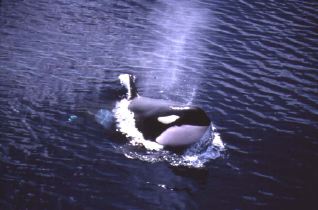
Fig. 29. Killer whale in the Gulf of Mexico. Courtesy K. D. Mullin, National Marine Fisheries Service |
Alaska Region |
|
Environment and Physical Features |
|
Two large marine ecosystems have been identified off Alaska, the eastern Bering Sea-Aleutians and the Gulf of Alaska. The Bering Sea is a semi-enclosed high-latitude sea. Of its total area of 2.3 million square kilometers, 44% is continental shelf, 13% is continental slope, and 43% is deepwater basin. Its broad continental shelf is biologically one of the most productive areas of the world. A special feature of the Bering Sea is the pack ice that covers most of its eastern and northern continental shelf during winter and spring. The dominant circulation of the water (Fig. 31) begins with the passage of North Pacific water (the Alaskan Stream) through the major passes separating the Aleutian Islands (Favorite et al. 1976) and into the Bering Sea. There is net water transport eastward along the Aleutian chain, and a turn northward at the continental shelf break and at the eastern perimeter of Bristol Bay. Eventually Bering Sea water exits northward through the Bering Straits, or westward and south along the Russian coast, entering the western North Pacific via the Kamchatka Strait. Some resident water joins new North Pacific water entering Near Strait, which sustains a permanent gyre around the deep basin in the central Bering Sea.
|
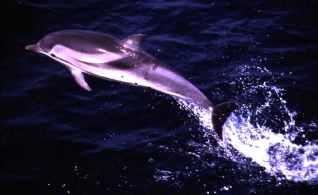
Fig. 30. Striped dolphin in the Gulf of Mexico. Courtesy C. L. Roden, National Marine Fisheries Service |
The dominant circulation in the Gulf of Alaska (Musgrave et al. 1992) is characterized by the cyclonic flow of the Alaska Gyre. The circulation consists of the eastward-flowing Subarctic Current System at about 50°N latitude and the Alaska Current System along the northern Gulf of Alaska. Large seasonal variations in the wind-stress curl in the Gulf of Alaska affect the meanders of the Alaska Stream and eddies of nearshore areas. It is the variations in these flows and eddies of the nearshore environment that affect a large part of the biological variability of the region. The Gulf of Alaska has about 160,000 square kilometers of continental shelf, which is less than 25% of the eastern Bering Sea shelf. At the northeast end of the Gulf of Alaska lies Prince William Sound, site of the 1989 Exxon Valdez oil spill.
|
|
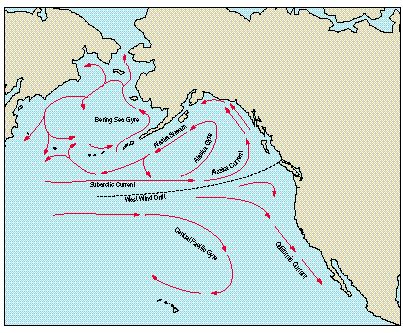
|
Fig. 31. General surface circulation and major areas of the North Pacific Ocean. |
Primary and Secondary Production |
|
Ice-edge dynamics play an extremely important role in boosting Bering Sea production. In late winter and early spring, enough light penetrates the Bering Sea ice cover to promote growth of the algal community living in the lower portion of the sea ice. As radiation increases, blooms begin under the ice and the open water south of the ice edge. The most intense primary production, however, does not occur until the ice edge begins to break up in spring over the wide continental shelf. As the ice separates into many smaller floes, light penetration into the sea increases significantly while the partial ice cover continues to minimize wind mixing. Under these conditions, intense phytoplankton blooms occur. As the ice edge retreats northward, further blooms continue, prolonging the period of high primary production over the Bering Sea shelf. As much as 65% of the annual primary production in the Bering Sea occurs during April and May (Niebauer 1981). In other areas off the Alaska coast, phytoplankton blooms occur over areas of upwelling. Such areas are widespread, particularly at edges of the various water domains on the shelf and shelfbreak, at the heads of submarine canyons, at the edges of gullies on the continental shelf, in island passes of the Aleutian Islands, and around submerged seamounts.
|
|
|
The organic matter formed by primary production is transferred to secondary zooplankton producers, which graze throughout the water column. The zooplankton grazers are often an assemblage of copepods and krill that form prey-predator links between the primary producers and upper trophic levels (Fig. 32). Shrimplike krill are important in the food web, since they are eaten by almost all other animals in the area.
|
Fig. 32. Food relationships in the marine environment. |
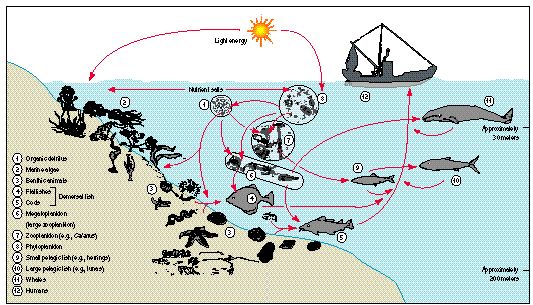
|
Benthic Resources |
|
The benthic invertebrate community off Alaska consists of at least 472 species of invertebrates making up the macroinfauna; the major groups include 143 species of polychaete worms, 76 species of amphipods, 76 species of gastropods, and 54 species of bivalves (Stoker 1981). More information is available for the more conspicuous forms of macrobenthos. The smaller organisms of the benthos (microbenthos and meiobenthos) are poorly known. The microbenthos consists of bacteria and protozoans, which are essential for the mineralization of organic debris that settles to the sea bottom. The meiobenthos consists of small animals such as minute crustaceans, nematode worms, and young stages of benthic invertebrates. Macrobenthos of direct commercial value include king crabs, Tanner crabs, and shrimps.
|
|
|
|
Three species of king crab are economically important: red, blue, and brown or golden king crab. With minor exceptions, king crab populations off Alaska are low in abundance and are projected to remain low in the near future (Table 6). King crab populations have generally been declining (Fig. 33) because of the occurrence of weak year-classes and increased adult mortality. Increased mortality has resulted from many factors, including natural predation by halibut, Pacific cod, and yellowfin sole; competition for space and food with bottom fishes; handling mortality by the crab-pot fisheries; and disease. |
Table 6. Status and trends of major shellfish resources off the coast of Alaska.
| Region/species |
Status and trend |
| Bering Sea |
|
| Blue king crab |
Average abundance, fully utilized, stable |
| Golden king crab |
Low abundance, fully utilized, declining |
| Korean hair crab |
Low abundance, fully utilized, stable |
| Red king crab |
Low abundance, overutilized, declining |
| Shrimps |
Low abundance, little utilized, stable |
| Sea snails |
High abundance, underutilized, stable |
| Snow crabs |
Above-average abundance, fully utilized, declining |
| Tanner crabs |
Above-average abundance, fully utilized, declining |
| Gulf of Alaska |
|
| Dungeness crab |
Low abundance, fully utilized, cyclic |
| Scallops |
Low or unknown abundance, fully utilized, unknown trend |
| Sea urchins |
Unknown abundance, underutilized, unknown trend |
| Shrimps |
Low abundance, fully utilized, stable |
| Tanner crabs |
Low to average abundance, fully utilized, stable |
|
| | |
Two species of Tanner crabs predominate, Tanner crab and snow crab. Tanner crabs are much less abundant than snow crabs (Fig. 34) and have been declining. Korean hair crabs are also declining and are substantially less abundant than king crabs and Tanner crabs. Dungeness crab is a nearshore species found mainly in the Gulf of Alaska. Its abundance is cyclic and currently low in all areas.
|
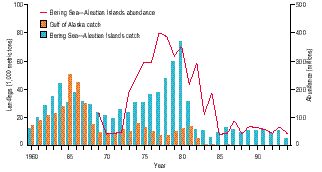
Fig. 33. Alaska king crab landings and abundance, 19601994. |
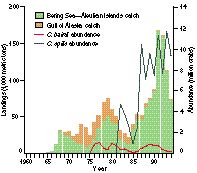
All shrimp populations in Alaskan waters are currently low in abundance and have supported only small localized fisheries since 1973. Pink shrimp constituted a major commercial fishery in the Gulf of Alaska through the late 1970's, yet this and other shrimp species are presently depressed with no apparent signs of increase. The Kodiak stock of weathervane scallops appears low, and stocks in other areas are generally unknown. Several other species of scallops smaller than weathervane scallops may have additional commercial potential, but their abundance is unknown.
|
Fig. 34. Abundance and landings of Tanner and snow crabs, 19601994. |
The sea snail resource of the eastern Bering Sea is composed of about 15 species broadly distributed over the continental shelf. The Pribilof whelk is the most abundant species, with many of the same genus (lyre whelk and fat whelk) also very common. Other common species include the Oregon triton, as well as several other whelks. The sea snail resource is known to be fairly large and is currently harvested in limited areas around the Pribilof Islands (Pereyra et al. 1976).
|
|
|
Although bivalves are widely distributed on the shelf, they are concentrated in the midshelf region of the Bering Sea. Some species are found in the nearshore surf zones. The Pacific razor clam is found on sand beaches of the Alaska Peninsula. Other clams inhabiting the Alaska Peninsula include the surfclam, the Alaska great-tellin, two species of cockles, and other less frequently taken species. The status and trends of bivalve populations are largely unknown.
|
|
|
Sea cucumbers and sea urchins are recent fisheries in Alaska. Hand-picked by divers in the southeast and Kodiak areas, their abundance and trends are not known. The sea urchin fishery is being jeopardized by heavy predation from increased sea otter populations.
|
|
|
Thirty-four species of corals are found in Alaskan waters--21 species of octocorals, 2 species of hexacorals, and 11 species of hydrocorals. Two of the more abundant species are the red tree coral and the sea raspberry coral, which occur in rugged habitat of boulders and bedrock. Southeast Alaska probably has the largest number of coral species in Alaska because of the variety of habitats there, which differ in depth, substrate, temperature, and currents. The status of corals in Alaska is unknown.
|
|
|
Demersal Fish Resources |
|
The total exploitable biomass of Alaska's groundfish resources has been declining slowly since 1995, when it reached 19.6 million metric tons in the Bering Sea-Aleutian region and 4.2 million metric tons in the Gulf of Alaska (National Oceanic and Atmospheric Administration 1996). These are very large biomass levels compared to the standing stocks of other groundfish resources in the world. The long-term potential yield or maximum sustainable yield for the groundfish complex in the Bering Sea-Aleutian Islands region is about 3 million metric tons. The current potential yield is also 3 million metric tons, which reflects the present good health of the resources. Recent average catch has been regulated to be below 2.0 million metric tons, which reflects a conservative management philosophy of limiting catches to protect less abundant species.
|
|
|
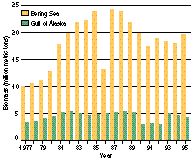
All the groundfish populations in the Bering Sea-Aleutian Islands, with one exception, are abundant and in good to excellent condition (Fig. 35; Table 7). The two main walleye pollock stocks are moderately abundant and until 1994 were above the biomass levels that would produce long-term potential yield. However, the transboundary eastern Bering Sea pollock stock may be showing stress in 1996 due to heavy harvesting taking place off Cape Navarin, Russia. The Aleutian Basin pollock stock, which spawns in the U.S. Exclusive Economic Zone and migrates through the international zone of the central Bering Sea known as the "Donut Hole," is very low in abundance. All of the flatfish populations but one are abundant and in good to excellent condition. Greenland turbot, a deepwater slope species, is the only depressed flatfish stock. Its abundance is projected to remain low through the 1990's. Pacific cod abundance is near a historical high and is expected to be relatively stable over the next few years. Sablefish or blackcod is low to average in abundance, and its recruitment has been relatively weak. Abundance of rockfish groups, particularly Pacific ocean perch, dropped sharply because of intensive foreign fisheries in the 1960's and remained low into the early 1980's. In recent years, their catch levels have been set well below current potential yield to help rebuild the stocks, and the Pacific ocean perch stocks are now recovering. Little is known about other rockfishes. The Atka mackerel stock that occurs mainly in the Aleutian Islands region is at average abundance and is decreasing.
|
Fig. 35. Biomass trends of groundfish populations in the BeringAleutians region and the Gulf of Alaska, 19771995. |
|
In the Gulf of Alaska, overall abundance of groundfish has been relatively stable (Fig. 35). The most abundant species in the gulf are flatfishes, particularly arrowtooth flounder, and Pacific cod. Sablefish abundance is at an average level, whereas abundances of pollock and Pacific ocean perch are low. The abundances of deepwater flatfish, shallow-water flatfish, flathead sole, demersal shelf rockfish, northern rockfish, pelagic shelf rockfish, other slope rockfish, thornyheads, and Atka mackerel are not well known. The long-term potential yield for Gulf of Alaska groundfish is about 450,000 metric tons. The current potential yield is 535,000 metric tons, well above long-term potential yield because of high flatfish abundance. Recent average catches are less than half of current potential yield because flatfishes, especially Greenland turbot and arrowtooth flounder, are substantially underutilized in the Gulf of Alaska. |
Table 7. Status and trends of major fish resources off the coast of Alaska.
| Region/species |
Status and trend |
| Bering Sea and Aleutians groundfish |
| Arrowtooth flounder |
Very high abundance, underutilized, increasing |
| Atka mackerel |
Average abundance, fully utilized, decreasing |
| Greenland turbot |
Low abundance, fully utilized, stable |
| Pacific cod |
High abundance, fully utilized, stable to increasing |
| Rock sole |
Very high abundance, underutilized, increasing |
| Rockfishes |
Average abundance, fully utilized, stable |
| Sablefish |
Average abundance, fully utilized, decreasing |
| Walleye pollock |
Average abundance, fully utilized, stable to increasing |
| Yellowfin sole |
Very high abundance, underutilized, stable to increasing |
| Other flatfishes |
Very high abundance, underutilized, increasing |
| All other fishes |
Above-average abundance, underutilized, stable |
| Gulf of Alaska groundfish |
| Atka mackerel |
Low abundance, fully utilized, unknown trend |
| Flatfishes |
Very high abundance, underutilized, stable to increasing |
| Pacific cod |
High abundance, fully utilized, stable to increasing |
| Pacific halibut |
Above-average abundance, fully utilized, declining |
| Rockfishes |
Below-average abundance, fully utilized, declining |
| Sablefish |
Average abundance, fully utilized, declining slowly |
| Walleye pollock |
Below-average abundance, fully utilized, declining |
| Salmonids |
| Chinook salmon |
Below-average abundance, overutilized, stable |
| Chum salmon |
Below-average abundance, fully utilized, stable |
| Coho salmon |
Above-average abundance, fully utilized, stable |
| Pink salmon |
High abundance, fully utilized, stable |
| Sockeye salmon |
High abundance, fully utilized, stable |
|
| | |
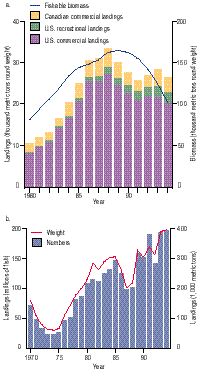
Pacific halibut is another groundfish species that has supported an important traditional fishery for the United States and Canada. Its long-term potential yield in U.S. waters is 30,000 metric tons. The 1995 potential yield is 23,000 metric tons, reflecting the relatively good, albeit declining, condition of the stock. The exploitable biomass of Pacific halibut peaked at 270,000 metric tons in 1988-1989. The population began declining at about 5% per year froM 1990 to 1993 (Fig. 36a) and accelerated to a 10% loss from 1993 to 1994.
|
Fig. 36. a) Landings and abundance of Pacific halibut in the northeastern Pacific, 19801994, and b) Alaska salmon landings, 19701994. |
The Fisheries-Oceanography Coordinated Investigations is a National Oceanic and Atmospheric Administration research program seeking to understand recruitment processes of Alaska fishes (Schumacher and Kendall 1995). The scientists in the program study both living organisms and their environment--especially processes within early life history stages--through integrated field, laboratory, and modeling studies. The initial focus of the Fisheries-Oceanography Coordinated Investigations studies was walleye pollock spawning in Shelikof Strait, Gulf of Alaska (Fig. 37). The choice of this population for research was based on the development of a large fishery and the substantial variation in this species' recruitment in the late 1970's and early 1980's. Also, the early life history of this population is quite predictable and is restricted both temporally and spatially. Walleye pollock spawn consistently in a small part of Shelikof Strait in early spring, producing a large patch of eggs and subsequently larvae. In most years, this concentration of larvae drifts to the southwest through the strait during April and May. Large numbers of larvae are often found in eddies, where feeding conditions are favorable. Fisheries-Oceanography Coordinated Investigations found that first-feeding larvae have a higher survival rate during calm sea conditions than in storms, and that in many years recruitment is largely already determined by the end of the larval period.
|
|
|
Pelagic Resources |
|
Along with zooplankton, pelagic fishes and invertebrates form important linkages in the food web of the Alaska marine ecosystems. Two of the biggest groups, squid and forage fish, are particularly important. Squid are eaten by marine mammals, seabirds, and, to a lesser extent, by fish. Squid make up more than 80% of the diets of sperm, bottlenose, and beaked whales and about one-half of the diet of Dall's porpoise. Marine birds are also known to feed heavily on squid. About 5% or less of the diet of most groundfish consists of squid; however, squid play a larger role in the diet of salmon. The biomass of squid is generally very large because of its lower-order position in the food chain.
|
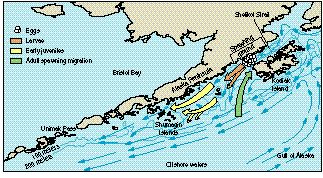
Fig. 37. Features of early life history of walleye pollock in Shelikof Strait, Gulf of Alaska. |
Livingston (1993) estimated that other groundfish consumed the most walleye pollock in terms of both biomass and numbers, with marine mammal and bird consumption 15-100 times less. Most of the pollock eaten by groundfish are less than 1 year old, putting groundfish in direct competition with marine birds and some marine mammals (for example, northern fur seals, juvenile Northern sea lions, harbor seals, spotted seals, and cetaceans) for this food resource. The fishery, on the other hand, takes pollock 3 years and older and therefore competes less directly with marine birds and some marine mammals (for example, adult Northern sea lions) than with those groundfish predators of adult pollock, such as Pacific halibut and arrowtooth flounder.
|
|
|
The major pelagic forage fishes off Alaska are Pacific herring, capelin, eulachon, rainbow smelt, Pacific sand lance, lanternfishes, and juvenile walleye pollock. Other important forage species, which usually occur either inshore and seasonally or in the northern Bering Sea, include smelts (for example, surf smelt), juvenile Pacific sandfish, Arctic cod, saffron cod, and juvenile Pacific cod. The status and trends of these pelagic forage species are largely unknown.
|
|
|
There is, however, anecdotal information that osmerid abundances, particularly capelin and eulachon, may have declined significantly since the mid-1970's. Major stocks of Pacific herring occur in southeast Alaska, Prince William Sound, and Kodiak Island-Cook Inlet. In the Bering Sea, they occur in northern Bristol Bay and Norton Sound. In the Chukchi Sea, commercial concentrations are located only in Kotzebue Sound. The potential yield of Pacific herring stocks is difficult to determine because stock abundance is highly variable. In the Gulf of Alaska, Pacific herring stocks are at moderate to high abundance. In the Bering Sea, abundance of the stocks is about average, but the trend is not well defined.
|
|
|
Five species of salmon are dominant off Alaska: sockeye or red salmon, pink salmon, chum or dog salmon, king or chinook salmon, and coho or silver salmon. There are also two species from exclusively Asian river systems, masu salmon and amago salmon, that are found in the North Pacific. Atlantic salmon that are occasionally found in southeast Alaska are believed to be strays from net pens in British Columbia. It is not known whether the species will establish wild runs or to what extent its presence might affect other species.
|
|
|
Salmon are anadromous species that live as adults at sea and return to freshwater streams to spawn. Juvenile salmon migrate out to sea to feed, and upon reaching maturity, return to the freshwater systems from which they originated. The adults deposit and fertilize eggs in gravel beds. After hatching, salmon fry mature for a variable period of time in fresh water and then become smolts and prepare for migration into the marine environment in spring or early summer. In addition to natural populations of salmon, hatcheries contribute fry and smolts to the marine environment. Alaska has 38 hatcheries which released 1.5 billion fish in 1993, and hatcheries in Japan release approximately 2.2 billion fish each year (North Pacific Anadromous Fish Commission 1993). The early survival of these fish is unknown, but hatchery-produced adults do contribute significantly to catches in some areas.
|
|
|
All five species of Pacific salmon in Alaska are fully utilized or overutilized (Table 7). Management of salmon is directed at achieving escapement goals, reducing incidental harvests, rebuilding wild runs, and increasing production through enhancement. The catch trends for salmon have increased significantly over the past 20 years (Fig. 36b). Chinook and chum salmon stocks are generally below the abundance levels that would produce long-term potential yield. Coho salmon stocks are near long-term potential yield levels, and pink salmon and sockeye salmon are above long-term potential yield levels. The salmon stock levels tend to be cyclic and are within normal parameters at present.
|
|
|
Marine Birds |
|
The Bering Sea and Gulf of Alaska support the largest and most diverse assemblages of marine birds in the northern hemisphere (Hatch and Piatt 1995). An overview of general information on Alaska seabirds and related management concerns has been prepared by the U.S. Fish and Wildlife Service (1992). The status and trends of marine bird populations in Alaska from this and other publications are summarized here.
|
|
|
More than 100 million birds of over 100 species depend on Alaska marine ecosystems during some part of their life cycle. These include loons, grebes, and waterfowl, as well as typical marine birds such as shearwaters, gulls, and alcids. At least three-fourths of these species breed in Alaska, and the rest are visitors from a wide variety of locations throughout the Pacific Ocean. Some visitors are transequatorial migrants from as far away as Antarctica. Twelve breeding species each have Alaska populations estimated to exceed one million individuals: northern fulmar, fork-tailed storm-petrel, Leach's storm-petrel, common murre, thick-billed murre, black-legged kittiwake, parakeet auklet, Cassin's auklet, crested auklet, least auklet, horned puffin, and tufted puffin. Two nonbreeding visitor species, sooty shearwater and short-tailed shearwater, also exceed one million individuals when in Alaska (Lensink 1984; Sowls et al. 1978). The Alaska population of many marine bird species represents a significant portion of their total world and North American populations; examples are the emperor goose, the red-faced cormorant, the red-legged kittiwake, the marbled murrelet, and the whiskered auklet.
|
|
|
At sea, marine bird densities are highest over the continental shelf and in the vicinity of breeding colonies (Gould et al. 1982). Important habitats include areas where environmental processes enhance prey abundance and availability, such as ice edges, upwellings, frontal systems, and eddies. Marine birds are secondary and tertiary consumers. Their major food items in Alaska include small fish such as young Arctic cod, capelin, Pacific sand lance, and young walleye pollock and invertebrates such as small squid, small crustaceans, and mollusks. Several species-- for example, albatrosses, northern fulmars, and gulls--consume significant quantities of bait, discarded bycatch, and offal at commercial fishing operations. Recently, population changes of several Alaska marine birds have been linked to episodic and decadal changes in prey abundance.
|
|
|
The U.S. Fish and Wildlife Service and the U.S. Geological Survey in Anchorage, Alaska, maintain data bases for monitoring population size and productivity of marine bird colonies. For half of Alaska's marine bird species (for example, storm-petrels, alcids, and jaegers), information on trends is scant or nonexistent. Most populations for which there are data appear to be stable. The major colonies are protected as either national or state wildlife refuges.
|
|
|
Alaska populations of marine birds listed as endangered or threatened are the short- tailed albatross and the spectacled eider. Steller's eider has been proposed for listing as threatened. Declines in populations are thought to be significant in several other marine bird populations, including American goldeneye, several scoters, harlequin duck, red-legged kittiwake, marbled murrelet, Kittlitz's murrelet, and pigeon guillemot. One bright standout among these troubled populations is a continuing increase in sightings of short-tailed albatrosses. The Aleutian Canada goose, a federally listed endangered species, nests on the Aleutian Islands but is not a seabird in any sense.
|
|
|
Marine Mammals |
|
The Alaska region has 37 stocks of more than 25 species of marine mammals (Table 3). Management of marine mammals is carried out under the Marine Mammal Protection Act of 1972 and the U.S. Endangered Species Act of 1973. Additional management actions are addressed by the Magnuson Fishery Conservation and Management Act of 1976. According to the criteria provided in the 1994 Amendments to the Marine Mammal Protection Act, there are 10 strategic stocks found in waters of the Alaska Region: northern fur seal (listed as depleted under the Marine Mammal Protection Act); the sperm whale, western North Pacific and central North Pacific humpback whales, fin whale, North Pacific right whale, the western U.S. stock of Northern sea lion, and bowhead whale (all listed as endangered under the Endangered Species Act); the eastern U.S. stock of Northern sea lion (listed as threatened under the Endangered Species Act); and the Cook Inlet stock of beluga whale (designated as strategic because total annual removals by humans exceed potential biological removal). Of the 37 Alaskan marine mammal stocks, 9 are believed to be increasing, 7 are believed to be stable, 2 are declining, and the population status of the remaining 19 is unknown.
|
|
|
Some of the most commonly observed species in the eastern North Pacific Ocean, such as the gray whale, Northern sea lion, harbor seal, California sea lion, and sea otter, are normally found close to shore. Other species, like humpback whales, traverse ocean basins while traveling to coastal feeding areas along Alaska's shores. Still others, such as fin whales, usually remain in offshore waters, whereas North Pacific right whales are so rare they are seldom seen. Most of the large whales make long-distance migrations, and other species may move hundreds of kilometers between seasons. In Alaska the annual ingress and egress of sea ice and the annual cycle in the day-night photoperiod influence these seasonal movements. Seasonal migrations from high-latitude summer feeding areas to winter breeding areas in lower latitudes are therefore common among large whales.
|
|
|
Pacific Coast Region |
|
Environment and Physical Features |
|
The Pacific coast region is adjacent to the three Pacific coast states, California, Oregon, and Washington. The continental shelf is narrow--the 200-meter depth contour typically occurs from 8 to 32 kilometers offshore. The eastward-moving North Pacific Current (also called the West Wind Drift) impinges on North America off the state of Washington and splits to form the northward warm Alaska Current and the southward cold California Current (Fig. 31). The California Current travels the full length of the Pacific coast and turns offshore to flow west across the Pacific off the coast of Baja California. A northward-flowing countercurrent underlies the California Current and surfaces each winter to form the warm, inshore Davidson Current.
|
|
|
Variability in the Pacific coast ocean climate is driven by large-scale atmospheric influences, including the El Niño-Southern Oscillation in the equatorial Pacific and the North Pacific low pressure atmospheric cell known as the Aleutian Low. Every few years the California Current weakens and upwelling is reduced, resulting in a warm condition that has become known as El Niño. The El Niño conditions strongly affect the southern California end http://all.net/journal/netsec/
|
|
|
There is also a between-decades pattern of climate variability that is clearest at the southern end of the region. The California Current appears to exhibit warm and cold periods, or regimes, each lasting decades and causing large biological shifts in the ecosystem. The most recent temperature shifts were from warm to cold in the early 1940's and back to warm in 1976 (lasting to the present). Samples of fish scales preserved in anaerobic sediments off Santa Barbara, California, provide a 2,000-year record of sardine and anchovy abundances, whose fluctuations show a periodicity of about 60 years. These temperature regimes appear to be associated with long-term variability in the amount of North Pacific Current flow that is directed northward into the Alaska Current as opposed to southward into the California Current.
|
|
|
The predominant ecosystem types on the Pacific coast include nearshore-coastal, continental shelf, and oceanic systems. The nearshore-coastal ecosystem extends from the intertidal zone out to 3 kilometers from shore and includes a diversity of habitats. The rocky intertidal habitat is dominated by macroalgae and sea anemones, barnacles, snails, starfishes, abalones, and mussels. The fish found here include smaller individuals of more offshore taxa like rockfishes and sculpins. Several estuarine bays and major embayments are found in the nearshore-coastal ecosystem. The Pacific coast region accounts for almost 98,420 square kilometers of estuarine drainage area. The larger estuaries--Puget Sound, Columbia River, and San Francisco Bay--together account for 53% of the estuarine drainage along the Pacific coast (National Oceanic and Atmospheric Administration 1990a). San Francisco Bay contains more than half of all wetlands in this region, even though it is estimated to have lost almost 95% of its wetlands since the time of its settlement by humans. The continental shelf ecosystem encompasses the upwelling zone and the inner portions of the California Current, between the nearshore-coastal ecosystem and the offshore oceanic ecosystem. The continental shelf extends to the 200-meter isobath, beyond which lies the continental slope. Associated benthic habitats are highly productive and support extensive fisheries for benthic fishes and invertebrates. Beyond the continental shelf edge (200-meter isobath) is the oceanic ecosystem, where three broad depth zones are recognized: epipelagic (0-200 meters), mesopelagic (200- 600 meters), and bathypelagic (600 meters to near bottom). The epipelagic zone is the most productive of the three zones.
|
|
|
Primary and Secondary Production |
|
Like other boundary currents on eastern rims of large oceans, the California Current is an area of high primary and secondary productivity. Nutrients are added to the ecosystem through a combination of coastal upwelling and advection. Initially upwelled water is characteristically low in plankton, but microalgae grow rapidly in the presence of nutrients and can achieve substantial blooms in a few days. Diatoms are the most abundant phytoplankton, but dinoflagellates can be especially important as food for larval fishes or as the source of red tides. Primary production is followed by secondary production of zooplankton, especially copepods and krill. Secondary production is most notable in the core of the California Current, far offshore. Also, krill densities are highest at the northern end of the system, where they are preyed on by marine birds, baleen whales, and coastal migrating fishes such as Pacific whiting, jack mackerel, and salmon. Large gelatinous zooplankton are very abundant on the shelf in late summer, particularly north of Cape Mendocino, although their importance in the ecosystem is not well understood.
|
|
|
The continental shelf ecosystem is trophically based on phytoplankton production responding to nutrients obtained from coastal processes, including upwelling, turbulent mixing, and river discharging. Secondary production of copepods, krill, and other zooplankton provides a rich pelagic environment for schooling fishes (anchovy, sardine), marine birds, and large whales. Other piscivorous fish and marine mammals also occupy higher trophic levels. The mesopelagic and bathypelagic zones are probably the largest habitats in oceanic ecosystems. However, since they depend on settling of production from the surface layer for most of their productivity, they generally contain small, slow-growing nekton species of little commercial importance, such as lanternfishes.
|
|
|
Benthic Resources |
|
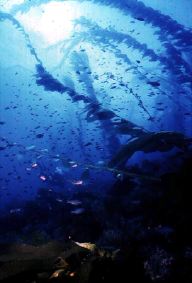
Within the nearshore-coastal ecosystem, kelp forests are a prominent feature of much of the rocky coastal areas and the few offshore islands present in the region (Fig. 38). These forests are vertically stratified much as terrestrial forests are and include a canopy of fast-growing giant or bull kelp, an upper understory of larger macrophytes, and a lower understory of coralline and filamentous algae. Only a few invertebrates--such as limpets, kelp crabs, and sea urchins--are commonly found well off the bottom, although many species use the cover provided by the understory and holdfasts of the kelp. The subtidal sandy-bottom habitats are generally devoid of most attached vegetation but may contain a substantial biomass of detritus that has been deposited from nearshore regions. This detritus supports a high biomass of scavenging epifauna such as starfishes, crabs, and small crustaceans in the inshore area, which progressively gives way, with increasing depth, to suspension-feeding polychaete worms, sea pens, sand dollars, shrimp, and bivalves.
|
Fig. 38. Kelp forest teeming with marine life.
Courtesy National Marine Fisheries Service |
The nearshore-coastal ecosystem is heavily exploited for a variety of shellfish, including crabs, sea urchins, and abalone. The Dungeness crab population is naturally cyclic, so the fishery experiences booms and busts with a 6- to 7-year periodicity. Along the central California coast, foraging by the recovering sea otter population has eliminated most nearshore shellfish of commercial or recreational interest, but elsewhere these resources are subject to intense exploitation. The once-thriving commercial abalone industry has declined severely (see box on California Abalone in California chapter). Sea urchins are harvested for their eggs, mainly for use in Japanese sushi. This industry grew rapidly during the 1980's but has recently declined as the favored red sea urchins have become depleted. Kelp forests briefly flourished when grazing by urchins was reduced, and the population of smaller purple urchins subsequently grew in the absence of competing red urchins. Markets are now becoming established for purple sea urchins, and the population is expected to decline substantially from its present high level.
|
|
|
Only a few benthic invertebrate resources are harvested as extensively as demersal fishes along the Pacific coast. The most commonly exploited is the Dungeness crab, which ranges throughout the region but occurs in commercial quantities mainly north of Cape Mendocino. This species is found in many bays and shallow coastal water, where the crabs are caught by recreational fishermen, and extends onto the shelf to a depth of about 90 meters, where the crabs are caught in commercial crabbing operations using baited traps. Commercial landings of Dungeness crab are characterized by substantial fluctuations over time and indicate a 10-12-year cycle. A 1991 outbreak of domoic acid produced by toxic dinoflagellates, which commonly affects bivalves and is bioconcentrated by crabs, curtailed the fishery for a season because of perceived health threats to humans. The outbreak was no longer a problem by the following year.
|
|
|
Pink shrimp are abundant on the continental shelf from Washington through northern California but are found deeper (70-200 meters) than Dungeness crabs. Shrimps are important in the demersal food web. They are pursued commercially mainly by trawling with special shrimp nets. The fishery peaked in 1977, declined for a number of years following the 1982-1983 El Niño event, and then was revived in the early 1990's. The population size of pink shrimp appears to be related to levels of summer upwelling and is not as cyclic as that of the Dungeness crab.
|
|
|
Recently, new benthic communities have been discovered that are associated with hydrothermal vents off Washington and Oregon. These are composed of animal life forms that are entirely chemosynthetic in origin (that is, they synthesize organic substances using energy solely from chemical reactions rather than from photosynthesis).
|
|
|
Fisheries Resources |
|
|
Most of the fisheries production in the Pacific coast region is taken from the continental shelf ecosystem. The status and trends of the major pelagic fishes are summarized in Table 8. Sea turtles, including the olive ridley, leatherback, hawksbill, loggerhead, and green turtle, also inhabit the epipelagic zone and undertake extensive migrations. |
Table 8. Status and trends of major fish resources off the Pacific coast region.
| Species |
Status and trend |
| Pelagic |
|
| Chub mackerel |
Average abundance, fully utilized, declining |
| Jack mackerel |
Below-average abundance, underutilized, stable |
| Northern anchovy |
Below-average abundance, fully utilized, declining slowly |
| Pacific herring |
Low abundance, fully utilized, cyclic |
| Pacific sardine |
Abundance rebuilt from depleted levels, fully utilized, increasing |
| Groundfish |
|
| Dover sole |
Above-average abundance, fully utilized, stable |
| English sole |
Average abundance, fully utilized, stable |
| Pacific whiting |
Above-average abundance, fully utilized, stable |
| Petrale sole |
Average abundance, fully utilized, stable |
| Rockfishes |
Average to below-average abundances, fully to overutilized, declining |
| Sablefish |
Average abundance, fully utilized, declining |
| Salmonids |
|
| Chinook salmon |
Many depressed stocks, overutilized, low abundance |
| Chum salmon |
Fairly good condition, overutilized, stable |
| Coho salmon |
Low abundance, overutilized, depressed |
| Sockeye salmon |
Overutilized, and stable at low levels |
| Cutthroat trout |
Low abundance, overutilized, depressed |
| Pink salmon |
Fairly good condition, overutilized, stable |
| Steelhead |
Low abundance, overutilized, depressed |
|
| | |
Nearshore Fishes
|
Minimal fish spawning occurs in kelp beds in nearshore areas; however, juveniles of many fish families such as rockfishes, kelpfishes, and sculpins use kelp beds as nurseries. Many small, cryptic fishes are found within the understory. Fishes occupying the sandy-bottom segments of the nearshore zone include bottom-feeding flatfishes and plankton-feeding surfperch, northern anchovy, and smelt, as well as juvenile salmon migrating through the region.
|
| Continental Shelf Pelagic Fishes |
|
Pacific sardine is the most well known of Pacific coast pelagic fishes. Its fishery was made famous by John Steinbeck's novel Cannery Row, a story woven around the sardine fleet in Monterey, California, during the 1930's. The actual fishery underwent a tremendous boom and decline when sardine biomass dropped from 3 million metric tons in the early 1930's to unmeasurably low levels (perhaps a few hundred metric tons) by the 1970's. This decline engendered much debate as to whether fishing or an adverse change in the natural environment was to blame. Discovery and analysis of a 2,000-year paleosedimentary record off Santa Barbara, combined with recent data on status of the stock, have allowed resolution of the debate. Coastal pelagic fishes such as the sardine show natural long-term fluctuations of very large amplitude, presumably in response to decadal-scale warm and cold ocean regimes. During warm periods, the populations can withstand high fishing rates, but during cold periods they decline even in the absence of fishing (that is, sustainable yields are very low, and no sustainable harvest may be possible during coldest conditions). When the ocean entered a cold regime in the 1940's, continued heavy fishing accelerated the otherwise natural decline and drove the sardine population to an extremely low level, hindering recovery once conditions warmed and became favorable again beginning in the late 1970's. Sardines have staged a moderate recovery in the last decade, and the fishery has reached 200,000 metric tons (Alaska Fisheries Science Center 1993).
|
|
|
The northern anchovy is another pelagic fish that has responded to between-decades climate change. Under virtually unfished conditions, the northern anchovy resource grew from tens of thousands of metric tons in the early 1950's to more than 2 million metric tons briefly in the mid-1970's. Reduction fisheries (for production of fish meal) subsequently developed in California and Mexico but ceased operation several years ago. The resource biomass is now about 200,000 metric tons and continues to decline slowly.
|
|
|
Chub mackerel has a history parallel to that of sardines. The chub mackerel supported a large fishery in the 1930's and 1940's and declined to very low levels by the early 1970's. In response to the post-1976 warming, this resource grew rapidly, reaching unprecedented size in the 1980's, but has declined precipitously since then. Because of a combination of population pressure and warm ocean conditions (including El Niño) in recent years, chub mackerel have occasionally migrated as far north as Vancouver Island, British Columbia.
|
|
|
Pacific herring is an important pelagic fish in the Pacific coast region, although it has a more northerly affinity and is most abundant off Canada and Alaska. Small populations are associated with estuaries, and the San Francisco Bay spawning population is at the southern end of the range. Not surprisingly, the San Francisco Bay population has declined in recent years, with warm ocean conditions being compounded by a long drought in California that has reduced freshwater flows thought to be favorable for herring reproduction. The heavy winter rains associated with the 1997 El Niño event have reversed this condition, with unknown long-term consequences.
|
|
|
| Continental Shelf and Slope Groundfish |
|
The commercial groundfish fishery presently includes 83 species, 55 of which are rockfishes. Most of the abundant species, with the possible exception of the short-lived shortbelly rockfish, are fully utilized, with harvests near long-term potential yield (Table 8). Several of the rockfish species are abundant enough to support directed commercial trawl and hook-and-line fisheries. Because these species are often very long-lived (greater than 50 years), and some concentrate in schools that are easily harvested, the potential for overharvesting rockfishes is great. Most species are found near high-relief bottom, but some species (widow rockfish and shortbelly rockfish) are pelagic. The Pacific ocean perch supported a substantial foreign fishery in the 1970's, but its population level is below that which will support long-term maximum potential yield. A fishery for another deepwater rockfish, the thornyhead, has recently developed and is reducing population levels of this species as well.
|
|
|
Of the dominant species, Pacific whiting (also known as hake) contributed 70% of the groundfish biomass in 1992. Pacific whiting are generally found in midwater and migrate annually from offshore spawning grounds off southern California to summer feeding grounds as far north as British Columbia. They migrate back in the fall, following an offshore migration route. Whiting mature at 3 years and undergo large fluctuations in recruitment success. The successful year-classes have fueled a substantial trawl fishery that started as a foreign fishery in the 1960's, switched to a joint-venture fishery in the 1980's, and has been a domestic fishery since 1991. Pacific whiting reached full use in 1989, but potential yield will vary substantially because this species has greater short-term natural fluctuations than most other groundfish species.
|
|
|
Sablefish (or black cod) are found along the outer shelf and upper slope, with the larger fish found deeper. Their distribution shifts from inshore in summer to offshore in winter. Sablefish can live up to 60 years but mature at 5 years. They are caught by pots and longlines and also in mixed-species trawl fisheries. During the last decade, their stock size appears to have declined.
|
|
|
Dover sole is the most important commercial species of the flatfish group. English and petrale soles have long histories of stable harvests, and the arrowtooth flounder fishery has recently expanded. All flatfish assessments are hampered by limited and inadequate survey data.
|
|
|
| Oceanic Pelagic Fishes |
|
The epipelagic zone of the oceanic system is inhabited by fast-growing fishes and squids whose ranges extend well beyond this region in these animals' search for concentrations of prey fishes or zooplankton. Among the most important of these predators are albacore tuna, yellowtail, and swordfish. Other species of lesser commercial importance are pomfret, ocean sunfish, blue sharks, and pelagic squids. The zone is also a rich feeding ground for migrating salmon and steelhead.
|
|
|
Pacific salmon are perhaps the most important living marine resource in the region. Salmon support important traditional, commercial, and recreational fisheries in Washington, Oregon, and California. They have long been an integral part of the Native American culture and heritage in the Pacific Northwest. Pacific salmonids are anadromous. There are seven salmonid species: chinook salmon, coho salmon, sockeye salmon, pink salmon, chum salmon, steelhead, and sea-run cutthroat trout. Salmon runs are inherently highly variable in abundance. Catches have fluctuated widely, and all seven species are overutilized. Environmental conditions tend to play a large role in salmon survival and abundance. For example, an El Niño event of unusual warm ocean and nutrient-poor conditions devastated chinook salmon and coho salmon ocean survival in 1983-1985. Stocks later rebounded but have recently declined, necessitating very restrictive salmon-fishing seasons in 1994. There are many competing user groups vying to catch salmon, and strict limitations are required to protect the stocks. Thus, salmon management issues are concentrated on catch allocations among user groups and adequate protection of migrating adults, spawners, and juvenile salmon during their outbound migration from home streams to the ocean. The status and trends of salmon off the Pacific coast are summarized in Table 8. The history of catches, which largely reflects changes in abundance of the populations, is shown in Fig. 39.
|

Fig. 39. Trends in salmon catches off the Pacific coast, 19601994. |
Recent annual commercial salmon catches were 1.8 million sockeye salmon (1990-1993 average), 2.6 million pink salmon (1989-1993 average), and 1.2 million chum salmon (1990-1993 average). Recreational catches of these species, though important, are comparatively small. Most Pacific Northwest stocks of pink salmon and chum salmon appear to be fairly stable and are in good condition. However, some Oregon and Washington chum salmon stocks are of special concern and, in 1991, the Snake River stock of sockeye salmon was listed as endangered under the U.S. Endangered Species Act.
|
|
|
For the period 1990-1992, commercial catches of chinook salmon, both natural and hatchery-produced, averaged 815,000 fish, while recreational catches averaged 354,000 fish. Because of catch restrictions, the landings have been much smaller in recent years. A significant share of the catch now comes from hatchery-produced fish. Some chinook salmon stocks are extremely depressed. The spring-summer and fall chinook salmon runs in the Snake River have been listed as endangered under the U.S. Endangered Species Act; so has the Sacramento River winter run of chinook salmon. In recent years, other chinook salmon stocks like the Columbia River summer run, Shasta River run, Skagit River spring run, Stillaguamish River summer-fall run, Snohomish River summer-fall run, Rogue River runs, and Klamath River runs have generally been depressed and have not met escapement goals. The National Marine Fisheries Service is conducting a status review under the U.S. Endangered Species Act of Pacific coast chinook salmon populations.
|
|
|
For 1990-1993, commercial catches of coho salmon averaged 1.1 million fish, while recreational catches averaged 706,575 fish. To an even greater extent than with chinook salmon, hatchery-produced coho salmon have become an increasingly important proportion of the catch, and in some areas account for more than 80% of the catch. Combined coho salmon landings from the ocean fisheries peaked at more than 5 million fish in 1976, then declined rather steeply in recent years to about 1 million fish. This decrease is in part due to a shifting of most of the allowable catch from the ocean fisheries to fisheries within rivers and estuaries. The shift mainly resulted from a 1974 federal judicial decision that entitles tribal fishermen to as much as 50% of the catch of returning salmon that migrate through their traditional tribal fishing areas.
|
|
|
In 1996 the National Marine Fisheries Service listed the central California and southern Oregon/northern California stocks of coho salmon as threatened under the U.S. Endangered Species Act. Also in 1996, stocks of coho salmon from Puget Sound/Strait of Georgia and Lower Columbia River/southwest Washington were placed on the candidate list. The release of hatchery-reared fish, degradation of salmon habitat, and overharvesting are major factors that contributed to the decline of the wild coho salmon populations in the Columbia River. Oregon coast coho salmon stocks were placed on the candidate list in 1997.
|
|
|
Unlike other salmonids, steelhead and sea-run cutthroat trout do not always die after spawning. A very valuable sport fish because of its size, fighting ability, and flavor, steelhead are harvested commercially only by Native American fishermen. All fisheries occur primarily in rivers and streams. During 1990-1993, a minimum average estimate of 266,000 steelhead (data on California catches are not available) were caught by recreation anglers. Tribal fisheries harvested an estimated 177,425 steelhead during 1987-1988 for commercial, ceremonial, and subsistence purposes. As with other salmonids, steelhead harvests have been augmented by large hatchery releases. Wild populations in many rivers are at very low levels, often restricting sport harvests to only hatchery fish. In response to a May 1992 petition to list Illinois River winter steelhead, the National Marine Fisheries Service initiated a status review for the broader unit that included this population. In August 1997, the National Marine Fisheries Service listed five Pacific coast steelhead populations. Listed as endangered are steelhead in the upper Columbia River and in southern California from the Santa Maria River to just south of Malibu Creek, which is north of Los Angeles; listed as threatened are steelhead in the Snake River Basin (encompassing parts of Idaho, Washington, and Oregon), and along the central California coast and the south-central California coast.
|
|
|
Sea-run cutthroat trout is another popular game fish and is not harvested commercially. The total catch is unknown, but populations appear to be severely depressed in many rivers. The north and south Umpqua River run was petitioned for listing under the U.S. Endangered Species Act, and as a result of its status review, the National Marine Fisheries Service listed Umpqua River cutthroat trout as endangered. The National Marine Fisheries Service is currently conducting a status review under the U.S. Endangered Species Act of all Pacific coast cutthroat trout populations.
|
|
|
Marine Birds |
|
More than 2 million marine birds of 29 species nest along the California, Oregon, and Washington coasts (Carter et al. 1995), including three species listed on the U.S. List of Threatened and Endangered Wildlife: the brown pelican, least tern, and marbled murrelet. The marbled murrelet nests inland in old-growth conifer forests and only forages at sea. Including breeding species, migrants, overwintering birds, and rare vagrants, more than 80 species of marine birds have been found in Pacific coast nearshore and pelagic waters (Stallcup 1990). For example, many millions of sooty shearwaters pass along the coast during their annual migrations between the Arctic and the southern hemisphere nesting islands. Moreover, the marine bird populations inhabiting the oceanic zone are also highly migratory and move seasonally between northern feeding and breeding grounds and southern overwintering grounds; these species include albatrosses, storm-petrels, shearwaters, phalaropes, and jaegers. Large marine fish-eating birds include loons, murres, cormorants, and gulls and are generally found in nearshore waters.
|
|
|
Breeding marine bird populations along the Pacific coast have declined since European settlement began in the 1700's. Numerous causes for their decline include human occupation or disturbance of nesting sites; introduction of mammalian predators (such as rats or cats) to nesting islands; and most recently, intense commercial use of natural resources, resulting in habitat loss, declines in forage abundance, and direct mortality of birds due to oil spills and entanglement in fishing gear (Jehl 1984). Many of these factors have been or are being resolved through improved management of marine and coastal habitats, fisheries, and resources, but many critical problems remain.
|
|
|
mally declared an endangered species. With reductions in the use of DDT, reproductive success improved, but immigration from Gulf of California colonies may also have contributed to the recovery. In southern California, the northern anchovy is the primary prey of breeding pelicans, and fluctuations in pelican reproductive success have been clearly associated with fluctuations in the abundance of northern anchovies. Thus the potential effect of the fishery on anchovy abundance became an explicit concern to management and led to a management plan for maintaining a large anchovy biomass below which level the commercial fishery would be curtailed. The brown pelican is now being considered for downlisting from its endangered status, based on recent population increases.
|
|
|
The least tern and marbled murrelet are both listed endangered species and are both suffering the effects of habitat loss. The least tern nests in sandy beach areas that are frequently affected by recreational use and by introduced red foxes; however, intense habitat management seems to be stabilizing the population. Like the better-known spotted owl, in the Pacific Northwest the marbled murrelet nests only in old-growth forests, although farther north it also nests in tundra. In the past, the marbled murrelet has experienced significant declines (Marshall 1988), and the health of its remaining populations in the Pacific Northwest is tied to the continuing existence of sufficient coastal old-growth forests (U.S. Fish and Wildlife Service 1995).
|
|
|
Marine Mammals |
|
When Hawaii is considered, the Pacific region is home to 67 stocks of at least 37 species of marine mammals, including 10 stocks of eastern tropical Pacific dolphins (Table 3). Like the birds and fish in the region, the marine mammal populations inhabiting the oceanic zone are also highly migratory and move seasonally between northern feeding-breeding grounds and southern overwintering grounds. Included in this category are blue whales, fin whales, sei whales, dolphins, and fur seals. In the nearshore zone, sea otters are common in kelp beds. In coastal areas, mammalian predators such as migrating California sea lions, gray whales, dolphins, and harbor seals are relatively common (Stallcup 1990). The U.S. Fish and Wildlife Service is responsible for managing two stocks of sea otters (in central California and in Washington), while the National Marine Fisheries Service has management authority for the remaining cetacean and pinniped stocks. According to the criteria provided in the 1994 amendments to the Marine Mammal Protection Act, these include 16 strategic stocks. In the eastern Pacific (that is, the waters of Washington, Oregon, California, and northern Mexico) these include 8 strategic whale species (humpback, blue, fin, sei, short-finned pilot, minke, sperm, mesoplodont beaked) and a threatened seal species (the Guadalupe fur seal). In addition, the northeastern spotted dolphin and eastern spinner dolphin stocks in the eastern tropical Pacific are considered depleted under the Marine Mammal Protection Act. Of the 43 stocks in the Pacific region, 11 are believed to be increasing, 13 are believed to be stable, 3 are declining, and the population trends of 16 stocks are unknown.
|
|
|
Estuarine Resources |
|
| San Francisco Bay |
|
The San Francisco Bay is fed by two main riverine systems. The south San Francisco Bay receives very little freshwater input and is poorly flushed, whereas the northern portion is part of an active river outflow system. The Sacramento and San Joaquin rivers form a complicated network of waterways in California's Central Valley, forming the Sacramento delta. After exiting the delta, the system sequentially opens into Suisun Bay, San Pablo Bay, and San Francisco Bay, then flows out through the Golden Gate. The entire San Francisco Bay-Sacramento delta system is subject to high rates of siltation.
|
|
|
Introduced species have continually re-shaped the San Francisco Bay ecosystem. The east coast's shipworm arrived with the Gold Rush of 1849 and quickly destroyed the many unprotected wooden structures in the bay. Striped bass and American shad were introduced in the later 1800's and quickly became dominant fishes in the system. More recently, various species of nonindigenous clams have sequentially claimed the benthic habitat, with the Japanese littleneck recently reaching remarkably high densities of 10,000 per square meter. Currently the green crab (a predaceous swimming crab related to the east coast's blue crab but of little human use) is increasing rapidly in abundance and is expected to reshape the system once again (San Francisco Estuary Project 1992).
|
|
|
The Sacramento and associated rivers historically supported several different large runs of chinook salmon, but present salmon production is mostly from the fall run produced by hatcheries. The winter run was recently added to the U.S. List of Endangered and Threatened Wildlife. Diversion of fresh water has posed problems for many species in the system. Large volumes of fresh water are diverted from the Sacramento delta into two large aqueducts serving San Joaquin Valley farmers and the Los Angeles metropolitan area. Reproductive habitat for native fishes and for popular introduced species such as striped bass depends on flows and interfaces of fresh and saline water. Freshwater diversion can greatly modify those patterns, resulting in poor reproductive success for fishes. Also, diversions may physically divert young life stages of several fish species and are a major source of mortality. Restricted freshwater flow also reduces flushing in portions of the bay, allowing contaminants to build up to high levels.
|
|
|
| The Columbia River Estuary |
|
The Columbia River is the largest river on the Pacific coast of the United States. Its estuary covers about 48,564 hectares, about three- quarters of its 1870 size. The Columbia River and its tributaries drain an area of 670,000 square kilometers. In late summer, the Columbia River contributes 90% of the fresh water entering the sea between the Strait of Juan de Fuca and San Francisco Bay, when the river plume extends 300-400 kilometers seaward and is detectable in a 1,000-square kilometer area.
|
|
|
The Columbia River once had the largest chinook salmon and steelhead runs in the world. Chinook salmon originally migrated nearly 1,935 kilometers up the Columbia River to Lake Windermere, Canada, and 967 kilometers up the Snake River to Shoshone Falls near Twin Falls, Idaho. Historical estimates of salmonid runs in the Columbia River range between 10 and 16 million fish. However, access to many spawning areas in the Columbia River basin is presently blocked by hydroelectric development. Fourteen hydroelectric dams have been constructed on the main-stem Columbia River, 7 on the Snake River, and 150 on Columbia River basin tributaries. More than 800 kilometers of the upper Columbia River, excluding tributaries, were blocked by the construction of Grand Coulee Dam in 1941. Only 80 kilometers of the Columbia River above Bonneville Dam are now free-flowing. More than 50% of the Snake River basin is no longer accessible to salmonids. Many salmonid hatcheries were built to compensate for losses in spawning and rearing habitat. Currently 57 hatcheries operate in the basin, placing almost 200 million juvenile salmonids into the Columbia River system each year. Hatchery production now accounts for about three-quarters of all adult salmonids returning to the Columbia River. However, hatcheries have high costs and maintenance requirements, often experience low adult returns, and negatively affect wild salmon stocks. Hatchery salmonids often cause overharvesting of wild salmonid stocks, yet hatcheries do not address many inherent salmonid population problems, such as habitat degradation, overfishing, and challenges faced with upstream and downstream migration.
|
|
|
The various Columbia River estuary habitats--including mudflats, estuarine and freshwater marshes, and major channels--provide food, refuge from predation, a physiological transition area for anadromous species, and nursery areas for a variety of species. Many of these habitats have been reduced in size or highly modified since the early part of this century. The Columbia River estuary has four large embayments, all of which contain expansive intertidal mud flats that harbor abundant benthic invertebrate populations. These benthic invertebrates, particularly amphipods, are primary prey for many fish and wildlife species. Detritus from rivers, estuaries, and the sea is the pri-mary food for most benthic invertebrate species.
|
|
|
The economy of the lower Columbia River was historically directly tied to its salmonid resources, which were central to the Native American way of life. Native Americans still hold treaty fishing rights and continue to harvest salmon for both commercial and ceremonial purposes. Commercial landings of salmon and steelhead were once as high as 14,350 metric tons (2,112,500 fish). By 1993, only 6,360 metric tons or 115,500 salmon were commercially harvested, in part because of very restricted seasons. Some restrictions resulted from the threatened or endangered listings of three Snake River salmon stocks, sockeye salmon, fall chinook salmon, and spring-summer chinook salmon. All salmonid species in the Columbia River basin are fully utilized to overutilized. The stocks are generally at low to depleted levels. Many are threatened or endangered.
|
|
|
Two species of sturgeon live in the Columbia River estuary, white sturgeon and green sturgeon. The overall white sturgeon population is healthy and productive, but populations upstream from Bonneville Dam, which are confined to reservoirs, are less productive and are considered depressed. In 1993, the total Columbia River white sturgeon catch was more than 50,000 fish, with most caught by the sport fishery in the estuary. In recent years, anglers have spent more days fishing for sturgeon than for any other species in the Columbia River estuary. Green sturgeon are much less abundant than white sturgeon. In 1993, 2,200 green sturgeon were caught commercially, and 100 recreationally. The status of green sturgeon in Oregon and Washington is unknown.
|
|
|
American shad were introduced into the Columbia River in 1885 and are now very abundant. The largest run was an estimated 4 million adult shad in 1990. In 1993, the minimum run size was 2.7 million fish. Poor market conditions and the concurrent timing of depressed salmon runs and the shad run in the spring have hindered the commercial harvesting of this species.
|
|
|
Columbia River smelt, or eulachon, spawn in coastal streams and in the lower Columbia River and its tributaries from mid-January through March and sometimes April. Although commercial landings for 1993 were the second lowest on record (227 metric tons), if the landing numbers for the coastal streams and the Columbia River are combined, the total run may have been near normal.
|
|
|
Other Columbia River estuarine fisheries include Dungeness crab, surf perch, and starry flounder. Northern anchovies are caught by seines and sold as bait for the sturgeon and salmonid sport fisheries. Some of the other species that use the Columbia River estuary, particularly as a nursery area, are longfin smelt, Pacific sand lance, Pacific herring, Pacific tomcod, shiner perch, Pacific staghorn sculpin, and English sole. The status of these populations in the Columbia River is unknown.
|
|
|
Many species of birds use the Columbia River estuary and its two wildlife refuges. Besides many migrating waterfowl, shorebirds, and marine birds, the estuary supports at least 22 nesting pairs of bald eagles. However, bald eagle reproductive success has been poor. Agricultural and industrial contaminants, specifically DDE, PCB's, and TCDD are at levels that adversely affect eggshell thickness and nestling viability. The recently established Caspian tern colony in the Columbia River estuary may now be the largest in the country, with 5,000 pairs in 1994. Because these birds prey on small fishes, there are concerns that terns are consuming many migrating juvenile salmonids. There is also a relatively large cormorant rookery located on the same island as the Caspian tern colony. Gulls nest in two or three locations throughout the estuary.
|
|
|
Waterfowl primarily use the Columbia River estuary during winter. Although relatively abundant, duck populations in the estuary fluctuate widely, depending on breeding success in other areas, and remain below historical levels. The Canada goose population in the Columbia River estuary is healthy and has doubled in the last couple of years.
|
|
|
Many species of marine, terrestrial, and freshwater mammals use the Columbia River estuary. Species such as harbor seals and California sea lions are increasing in abundance, and because they eat salmon, they are causing conflicts with anglers. The once- abundant mink populations have all but disappeared because mink reproduction is extremely sensitive to PCB's, which in the Columbia River are at concentrations that adversely affect reproduction. Other mammal populations, such as nutria and river otter, are healthy and stable. Marine species such as elephant seals, killer whales, gray whales, harbor porpoises, and Northern sea lions are rarely observed in the estuary.
|
|
|
| Puget Sound |
|
Puget Sound is located in Washington State and is one of the three major water systems in the Georgia Basin. The Strait of Juan de Fuca connects Puget Sound and its northern neighbor, the Strait of Georgia, to the Pacific Ocean. Puget Sound covers an area of 2,632 square kilometers at mean high tide. Of the eight major habitat types in the sound, kelp beds and eelgrass cover the largest area, almost 1,000 square kilometers. The other predominant habitat types include subaerial and intertidal wetlands (176 square kilometers), mudflats, and sandflats (246 square kilometers). Marked losses of these habitats have occurred during the last century. At least 76% of the wetlands have been eliminated, mainly within highly urbanized estuaries. Substantial declines of mudflats and sandflats have also occurred in the deltas of these estuaries (Levings and Thom 1994).
|
|
|
Several invertebrate species are commercially and recreationally important in Puget Sound. Among the crustaceans, Dungeness crab and several species of shrimp (for example, sidestripe shrimp and pink shrimp) are the most commonly harvested. The Pacific oyster accounts for 90% of the bivalve harvest. Japanese littlenecks and Pacific geoducks are the primary components of remaining bivalve harvests. Blooms of dinoflagellate species have been linked to the uptake of paralytic shellfish poisoning by various bivalves. Humans who ingest bivalves containing paralytic shellfish poisoning may experience neurological changes and, in a few cases, death. In Puget Sound, illnesses related to paralytic shellfish poisoning were not reported until the 1970's, and since then high toxin levels have been reported in various parts of the sound every year (Taylor and Horner 1994).
|
|
|
Within Puget Sound, salmon are presently the most economically valuable fish resource. In 1994, 45% of the approximately 210 stocks were classified as healthy, 21% as depressed, and 5% as critical by the Washington Department of Fish and Wildlife and the Oregon Department of Fish and Wildlife (1994). Chum salmon and pink salmon had the highest percentages of healthy stocks (70% and 60%, respectively) compared to chinook, coho, and sockeye salmon (35%, 44%, and 0%, respectively).
|
|
|
Historically, the most important commercial marine fish species in Puget Sound have been Pacific herring, Pacific whiting, Pacific cod, rockfish, and English sole. The population sizes of all of these species have declined during the last 10 to 20 years. Stocks of herring reached peak abundance in the mid-1970's, declined to low levels in the 1980's, and have since remained low. Commercial harvests of herring are now used primarily as bait for recreational salmon fishing. Whiting populations declined from a peak in the early 1980's to levels in the 1990's that are below the threshold required for a commercial fishery. Stocks of whiting in the waters north of Puget Sound and the Strait of Georgia are currently at a historical peak. Although cod and walleye pollock in Puget Sound are at their southern limit of abundance, commercial and recreational catches were relatively high during the 1980's. Present populations are severely depressed and the commercial fishery has been closed for several years. In contrast, the abundance of rockfish species has remained at low but constant levels during the last two decades. Populations of English sole are thought to be relatively healthy in the central portions of Puget Sound; however, significant declines have been recorded in populations in localized embayments, such as Bellingham Bay and Discovery Bay.
|
|
|
Approximately 66,000 marine birds breed in or near Puget Sound. About 70% of them breed on Protection Island, located just outside the northern entrance to the sound. The most abundant species are rhinoceros auklet, glaucous-winged gull, pigeon guillemot, cormorants, marbled murrelet, and Canada goose. Examples of less abundant species include common murres and tufted puffins. Populations of rhinoceros auklets and pigeon guillemots appear to be stable, whereas populations of glaucous-winged gulls have increased slightly in recent years, especially in urban areas (Mahaffy et al. 1994). Accurate estimates of current populations of marbled murrelets and Canada geese are not available, but the population of marbled murrelets has been greatly reduced, and this species has been listed as threatened. Thirty years ago, year-round resident Canada geese were rare in Puget Sound, but their population is growing rapidly. The common murre and tufted puffin populations have declined drastically during the last two decades.
|
|
|
The nine primary marine mammal species that are short-term or long-term residents of Puget Sound include (listed in order of abundance): harbor seal, California sea lion, Northern sea lion, northern elephant seal, harbor porpoise, Dall's porpoise, killer whale, gray whale, and minke whale. Harbor seals and California sea lions are year-round residents, and their abundance has increased each year in Puget Sound by 5%-15% at most sites (Calambokidis and Baird 1994; Fig. 40). Populations of the remaining species are quite small. Northern sea lions and elephant seals are transitory residents, and whereas the Northern sea lion is currently listed as threatened in the United States, the elephant seal is abundant in the eastern North Pacific but has few haul-out areas in Puget Sound. Although harbor porpoises are also abundant in the eastern North Pacific and were common in Puget Sound 50 or more years ago, they are now rarely seen there (Calambokidis and Baird 1994). Low numbers of Dall's porpoise are observed in Puget Sound throughout the year, but little is known about their population size; they are also abundant in the North Pacific. Three pods of resident fish-feeding killer whales, numbering about 100 total, reside just north of the entrance to Puget Sound, and the size of this group is increasing about 2% each year. Minke whales are also primarily observed is this same northern area, but their population size is unknown. Gray whales migrate past the Georgia Basin en route to or from their feeding or breeding grounds; a few of them enter Puget Sound during the spring and summer to feed.
|
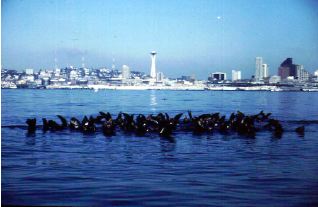
Fig. 40. California sea lions in Puget Sound. Courtesy P. J. Gearin, National Marine Fisheries Service |
| Southern California Bight |
|
The area called the Southern California Bight stretches from Point Conception to the United States-Mexico border (about 1,000 kilometers) and is around 300 kilometers at its widest point. The mainland nearshore habitats of the Southern California Bight are mostly composed of sandy beaches, whereas the roughly equivalent length of coastline on the islands is composed of rocky shores. Most of the sublittoral bottom of the Southern California Bight is sandy with rocky outcrops. Dense kelp forests and other aquatic macrophytes are particularly common around the Channel Islands, providing substantial habitat for the invertebrates, fishes, and marine mammals found there. Many of the islands, because of their relatively undisturbed condition, provide nesting and rearing sites for numerous pelagic birds, although bird production within the Southern California Bight is fairly low. Fish production, however, is high relative to primary production and approaches that of some upwelling areas because of high turnover rates and the low trophic levels of many of the pelagic fishes.
|
|
|
Western Pacific Oceanic Region |
|
The western Pacific region contains a huge number of species and few resource assessment agencies, compared to the continental United States. Great distances between the islands of the region, many of which are uninhabited, make assessment of the region's living resources difficult. In addition, economic conditions of many islands limit the effort that can be expended on resource assessment. For these reasons, there is little information on the status and trends of noncommercial species in the region, with the exception of corals and coral reefs, which have high aesthetic and conservation value. Quantitative data over time are lacking even for commercially important species in this region.
|
|
|
Environment and Physical Features |
|
The United States has jurisdiction over more than 50 Pacific Ocean islands (United Nations Environment Programme/International Union for the Conservation of Nature and Natural Resources 1988; Boehlert 1993). These include the Hawaiian Islands, American Samoa, the Mariana Islands (including Guam), Johnston Island, Kingman Reef, Palmyra Atoll, and Jarvis, Howland, Baker, and Wake islands (Table 9). Although these islands have only a total of 17,870 square kilometers of emergent land, their isolation enables the United States to claim more than 5.18 million square kilometers of ocean in the 200-mile Exclusive Economic Zone. The U.S. Pacific Islands (Fig. 41) span the tropics and subtropics across the Northern and Southern hemispheres between latitudes of 28°25' North (Kure Atoll) and 14°32' South (Rose Atoll), and across most of the central and western Pacific from the longitude of 155°30' West (Hawaii Island) to 144°38' East (Guam).
|
Fig. 41. U.S. island affiliates and the Exclusive Economic Zone in the western Pacific. The areas in color are the Pacific region's pelagic ecosystems. The numbers of island-associated, shallow-water fish species illustrate the west-to-east gradient in species richness in the Pacific. Island sizes are exaggerated for the sake of visibility. |
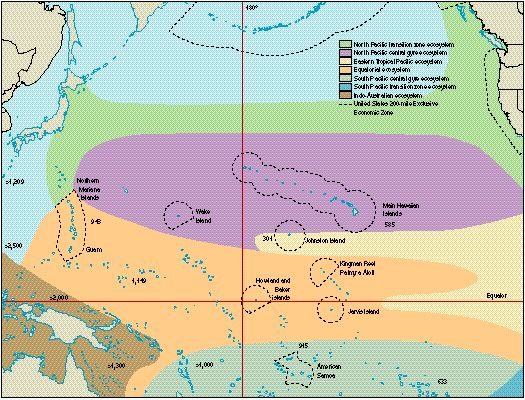
|
The living resources of the Pacific Islands are strongly influenced by dramatic differences in island location, size, elevation above sea level, annual rainfall, and human population (Table 9). The Pacific islands are categorized into two types, high and low islands, with significant differences in their habitats and biota (Kay 1980). High islands are by definition mountainous (Fig. 42), with numerous rocky headlands and narrow coastal plains fringed by beaches or rocky coastal shelves. They are frequently edged with coral reefs. Subsidence leaves many low islands (Fig. 43) as rings of islets and reefs surrounding a central, marine lagoon (United Nations Environment Programme/International Union for Conservation of Nature and Natural Resources 1988). Examples of these coral atolls are Kingman Reef, French Frigate Shoals (at the Northwestern Hawaiian Islands), and Rose Atoll (American Samoa).
|
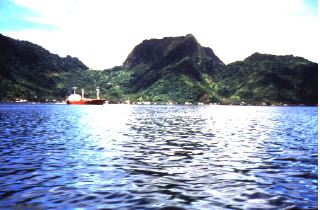
Fig. 42. Tutuila, American Samoa, is a high island with lush vegetation and estuaries. Courtesy B. Mundy, National Marine Fisheries Service |
Marine ecosystems within the oceanic Pacific are categorized here as coastal, shelf, slope or seamount, and pelagic. Although the pelagic ecosystems are relatively homogeneous, the coastal ecosystems of the Pacific Islands include numerous habitat types, and the slope ecosystem is intermediate in complexity (Holthus and Maragos 1995).
|
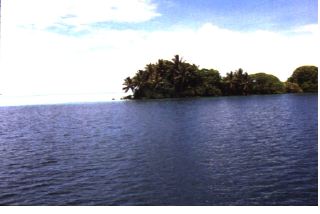
Fig. 43. Palmyra Atoll is a low island that is unusual in having abundant rainfall (more that 500 centimeters per year) and lush vegetation. Courtesy B. Mundy, National Marine Fisheries Service |
Pelagic Ecosystems |
|
|
U.S. Pacific Islands possess proportionally larger pelagic ecosystems than the continental United States because the number, dispersion, and isolation of the islands give the United States a very large Exclusive Economic Zone. The pelagic ecosystems of the Pacific correspond to major biogeographic regions defined by ocean currents (McGowan 1974). These areas are the northern and southern central gyres, the northern and southern currents that border the gyres (in regions called transition zones), the equatorial currents, and a unique area in the eastern tropical Pacific. Most pelagic fishes have ranges that encompass two or more of these areas. Large species such as whales, porpoises (Jefferson et al. 1993), sea turtles (Márquez 1990), billfish (Nakamura 1985), and tunas (Collette and Nauen 1983) are of greatest social importance. |
Table 9. Physical characteristics and human populations of U.S. island possessions in the central and western Pacific Ocean. |
| Island or archipelago |
Number of islands |
Land area (square kilometers) |
Elevation above sea level (meters) |
Average precipitation (millimeters per year)a |
Human populationa |
| Main Hawaiian Islands |
8 + several islets |
1.1-10,414 |
168-4,205 |
630->11,400, depending on area |
1,159,600 (1992) |
| Northwestern Hawaiian Islands |
>12 |
13.5 total |
3-277 |
low, <500 |
No permanent population |
| Johnston Atoll |
1 |
2.5 |
5 |
663 |
N/D (military base) |
| Palmyra Atoll and Kingman Reef |
2 |
6.0 total |
3 |
>5,080 |
No permanent population |
| Howland Island |
1 |
1.6 |
7 |
low, <500 |
Uninhabited |
| Baker Island |
1 |
1.4 |
8 |
low, <500 |
Uninhabited |
| Jarvis Island |
1 |
4.5 |
8 |
low, <500 |
Uninhabited |
| American Samoa |
7 |
2.1-135 |
3-966 |
<500 (Rose Atoll)-5,080 (Tutuila) |
50,900 (1992) |
| Guam |
1 |
541 |
405 |
2,286 |
133,152 (1990) |
| Northern Mariana Islands |
16 |
0.8-122 |
81-965 |
2,000-2,500 |
48,216 (1993) |
| Wake Island |
1 |
7.4 |
3 |
N/D |
N/D (military base) |
aN/D = no data available |
|
| Insular Shelf, Slope, and Seamount Ecosystems |
|
Insular shelves, slopes, and seamounts form the interface between coastal and pelagic ecosystems of the Pacific islands. These deeper-water habitats have unique biotas (Chave and Jones 1991; Rogers 1994). Seamounts are widely scattered throughout the Pacific Ocean, but those near U.S. islands are concentrated in the vicinity of the Marianas and the Hawaiian Islands. Most organisms at seamounts (Fig. 44) have not been threatened by exploitation because of their remoteness and great depth of occurrence (Rogers 1994). However, populations at seamounts where intensive fisheries occur may be easily overexploited (Grigg 1993; National Oceanic and Atmospheric Administration 1996). Habitat degradation of Pacific island slope and seamount habitats has been minimal.
|
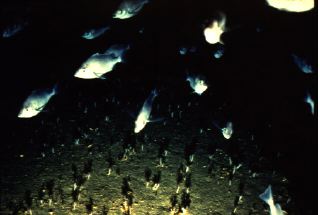
Fig. 44. Pelagic armorhead, sea urchins, and soft corals at about 250 meters depth on the summit of Hancock Seamount, north of Midway Island. Courtesy R. Humphreys, National Marine Fisheries Service |
The oceanic islands of the Pacific lack broad continental shelves. Instead, narrow shelves fringe the larger islands (Brock and Chamberlain 1968). In many areas, these are actually series of terraces with escarpments of 2-35 meters. Biological communities of the shelves, such as the pen shell beds, are poorly studied. Recent surveys have shown that sandy shelf areas are important recruitment and nursery areas for one of the slope snappers, opakapaka (Parrish 1989). Thus, the importance of this featureless habitat has been underestimated. Island shelves support fisheries for coastal species that extend into deeper waters. Certain migratory species, such as humpback whales, use island slopes or shelves during critical stages of their life histories (Fig. 45). With the exception of larger species taken by fisheries, biological resources of insular shelves are probably not under threat from habitat damage or overexploitation.
|
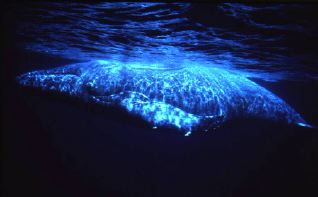
Fig. 45. Humpback whale near Kailua-Kona, Hawaii. Courtesy L. Consiglieri, National Marine Fisheries Service |
Deeper coastal habitats of many high islands consist of escarpments and narrow insular shelves (Brock and Chamberlain 1968). Wave erosion, during geological periods when sea level differed from that of the present, created rocky undersea walls or cliffs 2-35 meters high alternating with sandy terraces. Small atolls may lack shelves or terraces (Colin et al. 1986). The slope ecosystem begins beyond the coastal terraces, or where atoll slopes exceed 30° (Colin et al. 1986; Chave and Jones 1991). High-gradient slopes are rocky, whereas low-gradient areas accumulate sediments. Escarpments exist on slopes as deep as 1,100 meters at some islands, and limestone outcrops may be found to 1,650 meters. Island slopes often descend steeply (from 45° to more than 60°) to the abyssal plain 2,000-4,000 meters below.
|
|
|
Reef-building corals, which thrive above 50 meters, become rare below 100 meters, but many animals usually associated with corals may be found to a depth of 200-300 meters. A deepwater biota begins at 200-500 meters (Chave and Mundy 1994). Below 500 meters, the fauna (there are no plants) gradually becomes abyssal, composed of animals that are often lightly pigmented, with reduced tissue density and eyes that are reduced or absent.
|
|
|
Because islands rise abruptly from the ocean floor, most of their Exclusive Economic Zones are over deepwater. Traveling less than 5 kilometers offshore of Pacific islands usually places one over water more than 2,000 meters deep. Indeed, the greatest ocean depth, 11,022 meters at the Mariana Trench, borders U.S. islands.
|
|
|
| Coastal Ecosystems |
|
Coastal ecosystems of the Pacific Islands are composed of several characteristic habitats, most of which are highly structured, topographically complex, and biologically diverse (Holthus and Maragos 1995). Coastal ecosystems of the Pacific Islands are small compared to those of the continental United States, but island coasts have larger ratios of perimeter to land area. Coral reefs, rocky shorelines, seagrass and algal beds, mangrove forests, small estuaries, and terrestrial seabird and turtle rookeries are important habitats for Pacific island marine organisms.
|
|
|
Coastal habitats found on high Pacific islands but not low atolls include estuaries, mangrove forests, rocky reefs with little coral, and brackish shoreline ponds (Kay 1987). Actively volcanic islands such as Hawaii Island or Aguijan, Farallon de Medinilla, and several smaller Commonwealth of the Northern Mariana Islands have coastal habitats that are rocky, without elaborate coral or mangrove development (United Nations Environment Programme/International Union for the Conservation of Nature and Natural Resources 1988). Rocky reefs and shelves with or without coral make up a larger proportion of coastal habitat in high Pacific islands than is commonly recognized. Freshwater streams and rivers on high islands provide habitats for amphidromous species, which live in fresh waters through most of their life cycles and breed there, but have planktonic larvae that drift out to sea and return to fresh waters when they are transformed to their juvenile stage (Kinzie 1990). At the Pacific Islands, these are species in families that are usually marine, including fishes (gobies and sleepers), shrimps or prawns, and snails (nerites). Thus, high islands have a greater aquatic biological diversity than low islands.
|
|
|
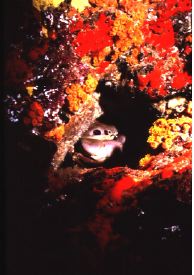
Shallow coastal habitats common to both island types include algal beds, seagrass beds, sand flats, rocky reefs, and rubble-covered bottom, but the most characteristic habitat of the Pacific Islands is coral (Kay 1987). Coral reefs are formed by the accumulated carbonate structure of ancient reefs capped by growing coral and calcareous algae, typical of low atolls. The majority of coral habitats of high Pacific islands is thus not true coral reef but coral growth on rocky substrates (Fig. 46).
|
Fig. 46. An ala kumu (also known as the 711 crab) in a basalt escarpment reef at 11 meters on Oahu, Hawaii. Although orange cup corals and brightly colored sponges are abundant on this rocky reef, reef-building corals are sparse.
Courtesy B. Mundy, National Marine Fisheries Service |
Polovina et al. 1994rshore habitat often unrecognized as important. The algal habitat in Hawaii is composed of beds or clumps of Microdictyon species less than 5 centimeters high and fields containing a variety of genera including Halimeda, Sargassum, Padina, and Dictyopterus species exceeding 10 centimeters (Parrish and Polovina 1994). This important algal habitat is used by a variety of organisms for food, shelter, and nursery grounds. Calcareous algae are a major source of sand, which in turn forms habitat for numerous other species (Kay 1987; Fig. 47).
|
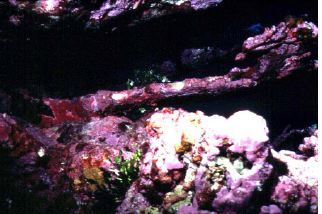
Fig. 47. Colorful calcareous algae on a patch of dead coral at 3 meters on Palmyra Atoll. The importance of algae in coral habitats and as a separate nonreef habitat in tropical ecosystems is frequently underestimated. Courtesy B. Mundy, National Marine Fisheries Service |
The extent and importance of algal habitat are frequently overlooked by resource managers. Adult green turtles, for example, forage primarily on algae and seagrasses (Forsyth and Balazs 1989). In the northwestern Hawaiian Islands, expansive algal areas are thought to provide shelter for newly recruited lobster and fish in depths of about 18-30 meters (Parrish and Polovina 1994; Figs. 48 and 49). This little-studied habitat is extensive on shallow banks throughout the Pacific basin and is vulnerable to the same environmental stress (that is, pollution and sedimentation) as coral reefs. The role of algal beds as habitat for early life stages of Pacific marine organisms should receive high priority for future research.
|

Fig. 48. A slipper lobster at 33 meters on the insular shelf of Oahu, Hawaii. Courtesy B. Mundy, National Marine Fisheries Service |
Seagrass beds are a less widespread coastal habitat in these islands. Unlike temperate seagrasses, most tropical seagrass species are small, with rapid growth rates and the potential to recover rapidly from disturbance (Coles and Leelong 1997). Like algal beds, seagrasses provide shelter for crustaceans and fish, food for sea turtles and other species, stability for bottom sediments, and a means for trapping detritus and nutrients, all of which increase productivity. Seagrasses are most diverse in the western Pacific, with seven species in Guam, but the single Hawaiian species is endemic and known from only a few sites (Coles and Kuo 1995). Little is known about the status of seagrasses in the U.S. Pacific Islands.
|
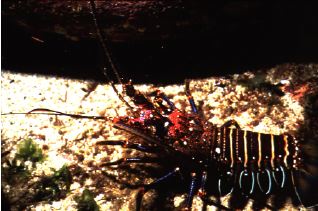
Fig. 49. An endemic Hawaiian spiny lobster at 8 meters on Oahu, Hawaii. Courtesy B. Mundy, National Marine Fisheries Service |
Lagoons and estuaries of Pacific tropical islands are usually small (United Nations Environment Programme/International Union for the Conservation of Nature and Natural Resources 1988), relative to North American estuaries. Most lagoons occur in low atolls, and only a small number of species are known to complete their entire life histories within them (Boehlert and Mundy 1993; Leis 1994). Estuaries in the western and southern Pacific are typically fringed with mangrove forests, although the clearing of mangroves has altered estuarine habitats in many areas (Ellison 1997). For example, the 10 hectares of mangrove in Pago Pago Harbor, American Samoa, were cleared for harbor development, as were mangroves in Apra Harbor, Guam, where most of the island's forests grew. Mangrove forests are extremely susceptible to damage by clearing and coastal development and are of special concern for conservation. The Coastal Management Program in American Samoa now provides for mangrove protection and management (Ellison 1997). In contrast, mangroves are an introduced species in Hawaii (Kay 1987). Transported to Hawaii in the early 20th century, they now form altered habitats in restricted locations. Removal of introduced mangroves from Pearl Harbor has been proposed to restore natural estuarine habitat for indigenous birds and fishes (U.S. Army Corps of Engineers 1995).
|
|
|
Few indigenous island species are obligate estuarine organisms, but island estuaries do serve as nurseries or primary adult habitat for some (Kay 1987). No assessments of stock status for estuarine populations in the Pacific Islands are available. In Hawaii, an example of an estuarine organism is the nehu, an endemic anchovy that is the primary bait for the local skipjack tuna fisheries. About 70% of the catch of nehu comes from Kaneohe Bay and Pearl Harbor, Oahu. Nehu numbers fluctuate greatly, but abundance is primarily measured by the bait fish catch, which varies more with socioeconomic factors than the nehu stock size (Clarke 1992). Recent studies suggest an inverse relation between nehu population abundance and salinity, but the influence of environmental factors on the marine resources of most island estuaries is poorly understood.
|
|
|
Estuaries of the Pacific Islands may be exceptionally vulnerable to coastal development because of their small size and number and their proximity to human populations (Maragos 1993). Examples of human alterations to island estuarine or lagoon habitats include Pago Pago Harbor and Pala Lagoon, American Samoa. Alteration of Pago Pago Harbor began during 1942-1945 with dredging that continued through 1960 (United Nations Environment Programme/International Union for the Conservation of Nature and Natural Resources 1988). Tuna canneries were built in the northern end of the harbor in 1956. Canneries and other sources of organic pollution added to dredging, oil spills, bilge and ballast water discharges, sewage, and agricultural pollution, and by 1977 about 95% of the corals in the inner harbor were dead. Treatment projects and reduction of direct discharge of wastes into the harbor are now under way. Pala Lagoon is a smaller embayment to the west of Pago Pago Harbor that was once open directly to the sea. About 1960, an airfield constructed on the west side of Pala Lagoon closed most of this opening (Maragos 1993). Resulting habitat damage was manifold: adjacent reefs were dredged and filled, shoreline erosion increased at nearby beach areas, and the water quality was reduced in what had been American Samoa's most important shellfish ground.
|
|
|
The coastal habitats of special concern are terrestrial nesting sites critical to the survival of seabirds and sea turtles (Fig. 50). These animals nest at remote sites that lack indigenous land mammals and are removed from most human activity. They are thus extremely vulnerable to habitat alteration and predation by introduced species. Conservation of marine bird and sea turtle nesting habitat is a high management priority for the region.
|
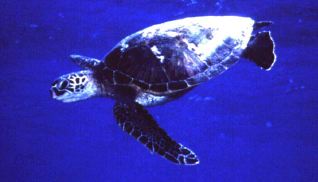
Fig. 50. A green turtle swimming at 2 meters beneath the surface over a sand flat on Oahu, Hawaii. Courtesy B. Mundy, National Marine Fisheries Service |
Patterns of Biodiversity |
|
Biodiversity patterns in the oceanic Pacific have been shaped primarily by volcanism, tectonic plate movement, sea-level change, and island subsidence--forces which together create high islands and then transform them to low atolls--as well as by ocean currents, human-caused extinctions, and species introductions (Kay 1980; Springer 1982). Substantial human populations often live on high islands in urban centers that low atolls cannot support. High islands often have substantial rainfall, allowing forests, freshwater streams, and estuaries to exist. Most atolls are dry and lack dense vegetation and estuaries. High and low islands are distributed unevenly across the Pacific, with only low islands present in the central equatorial region. This uneven distribution has greatly influenced the biogeography of the region (Stoddart 1992).
|
|
|
A west-to-east gradient of species richness exists in the Pacific, emanating from a region bounded by the Philippines, Indonesia, and New Guinea (Stoddart 1992). This region contains the greatest number of marine species on Earth, and numbers of species decline with distance away from it (Fig. 41). For example, the Mariana Islands, which are nearest this region, have 943 shore fishes, and Samoa to the southeast has 915. Hawaii, much farther to the northeast, has 585, but Johnston Island, a low atoll far to the southwest of Hawaii, has only 301 (Myers 1989; Kosaki et al. 1991; Randall 1995; Myers and Donaldson 1996).
|
|
|
The Hawaiian Islands are a biodiversity hot spot, despite their relatively low species richness, because a large percentage of Hawaiian species are endemic (Randall 1992). About 18%-25% of Hawaiian shore fishes, mollusks, polychaete worms, seastars, and algae exist only in that archipelago (Kay 1987). This proportion ranks among the highest degree of marine endemism of any of the Earth's islands.
|
|
|
Status of Taxonomy |
|
Much remains to be learned about the taxonomy and biogeography of Pacific island marine organisms (National Research Council 1995). Oceanic organisms are relatively well known, whereas mesopelagic and planktonic species associated with islands or seamounts need more study. Our knowledge of insular coastal biotas is related to the existence of research institutions in some areas (Oahu, Guam) but not in others (Wake, Howland). Hawaii and Guam have been surveyed more than other U.S. islands, whereas the species taxonomy of the small U.S. island possessions in the central equatorial Pacific is very poorly known. The deep-sea biota has received little study except near Hawaii, and the biota below 2,000 meters is almost unknown.
|
|
|
Taxonomic knowledge also varies greatly among systematic groups. Large organisms like mangroves (Ellison 1995), birds (Garnett 1984), and mammals (Jefferson et al. 1993) are well known. Although new species of seagrasses (Coles and Kuo 1995), corals (Veron 1995), and shallow-water fishes (Pyle 1995) continue to be discovered, taxonomic knowledge of these conspicuous groups is essentially at the level of systematic revision and biogeographic description. For example, of 3,392 nonpelagic fish species living above 200 meters, only 442 (13%) were awaiting description as of 1995 (Pyle 1995). The proportion of reef and shore fish families from the region that are in need of taxonomic revision (20%) is high relative to those in North America but is low relative to other taxa in the Pacific Islands.
|
|
|
Algae (Abbott 1995), mollusks (Kay 1995), and echinoderms (Pawson 1995) are somewhat well known, although much remains to be discovered about cryptic species. Their taxonomy is still at the level of species description, and it is estimated that about 25%-30% of the flora remains unknown. Several reviews of Pacific mollusks exist, but an average of 24 new species a year are still described (Kay 1995). Knowledge of Pacific echinoderms (sea urchins, sea stars, and so forth) is exemplified by a 1986 review of New Caledonian species (Guille et al. 1986), which increased the number of known species by 46%; similar results are expected from other Pacific islands (Pawson 1995).
|
|
|
Poorly known taxa in the central Pacific include sponges (Kelly-Borges and Valentine 1995), cnidarians other than corals, segmented worms (Bailey-Brock 1995), crustaceans (Eldredge 1995), and other arthropods. Numerous species undoubtedly remain undiscovered. Tiny organisms and those in esoteric taxa are almost uninvestigated in the Pacific Islands. These include marine viruses, bacteria, protists, flatworms (Fig. 51), nematodes, groups of marine worms, sipunculids, and several other phyla (for example, rotifers, gastrotrichs, phoronids).
|
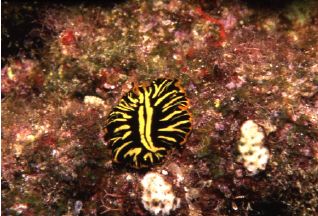
Fig. 51. A flatworm on a reef at 14 meters on Oahu, Hawaii, is a species not identified until 1995 despite its abundance and conspicuous appearance. Less is known about the taxonomy of marine life in the Pacific Islands than in other U.S. waters. Courtesy B. Mundy, National Marine Fisheries Service |
Little is known about the genetic diversity of Pacific island organisms, particularly the ones of less economic value (see, for example, studies reviewed by Palumbi 1994). The larger, socially important pelagic organisms are better studied (Graves and McDowell 1994; Hoelzel 1994), but information is still meager. Evidence for within-species genetic diversification ranges from strong (humpback whales, Baker et al. 1993; green turtles, Bowen et al. 1992) to absent (yellowfin tuna, Scoles and Graves 1993; skipjack tuna, Graves et al. 1984).
|
|
|
Primary Production, Secondary Production, and Benthic Resources |
|
Primary and secondary production are difficult to summarize for the western Pacific region because of the area's extensive geographic range and heterogeneity. Benthic resources of the region are even more difficult to characterize for these reasons and also because of the large number of species present. Our rudimentary taxonomic knowledge about benthic organisms exacerbates this difficulty. A few examples of regional benthic resources are discussed in the sections on coastal ecosystems, western Pacific invertebrates, reef animals, and nearshore resources (coral reefs). There is little information available on ecosystem processes, energy flow, or linkages between primary, secondary and tertiary production in nearshore U.S. Pacific Island ecosystems, with the exception of a study in the northwestern Hawaiian Islands (Polovina 1984).
|
|
|
Primary production in the tropical and subtropical Pacific tends to be oligotrophic compared to that of continental shelves (Mann and Lazier 1991; Olaizola et al. 1993). Oligotrophic systems are characterized by low primary productivity associated with low levels of dissolved nutrients. Reduced primary productivity and consequent low secondary productivity create the clear, blue waters for which the tropics are famous. Two processes that transport nutrients to the ocean surface along continental coasts, estuarine outflow and coastal upwelling, are not dominant features of most of the Pacific Islands. Areas of enhanced productivity exist, however, at regions of equatorial upwelling (Lindley et al. 1995; Mackey et al. 1995) and near islands (Gilmartin and Revelante 1974). Island and seamount topography also act with winds, tides, and prevailing currents to create eddies and other small or mesoscale oceanographic features that locally enhance primary productivity (Boehlert and Genin 1987; Olaizola et al. 1993). These areas of greater productivity support fisheries for tunas, swordfish, marlin, squids, and other species (Boehlert 1993).
|
|
|
Studies of the primary production, secondary production, and benthic communities of the leeward (west) coast of Oahu, Hawaii, were reviewed by Harrison (1987). Although this site cannot be considered representative of average or even typical conditions at other Pacific islands, it does serve as an example of island conditions for comparison to marine regions of the continental United States. The studies showed that Chlorophyll a concentrations at west Oahu were low at the surface (average of 0.01 microgram per liter), with a maximum (average of 0.03 microgram per liter) below the mixed layer in a depth range of 50-120 meters. Chlorophyll a concentrations were sometimes increased near shore. Picoplankton (cells smaller than 3 microns) constituted about 65% of the total phytoplankton biomass. High Chlorophyll a concentrations just below the mixed layer and a predominance of picoplankton are both characteristics of waters poor in nutrients. The average depth-integrated primary production at leeward Oahu was 13.8 milligrams of organic carbon per square meter per hour, and the average annual production was estimated at 60.4 grams of organic carbon per square meter per year. There was a semiannual cycle, with high primary production in January through May, and lower production from May to December. Secondary production was also typical of oligotrophic waters. Microzooplankton standing stocks were about 166 milligrams of organic carbon per square meter in the upper 200 meters, with a maximum at 75-125 meters as with phytoplankton. Macrozooplankton biomass was variable, as high as 4.72 milligrams of organic carbon per cubic meter in the upper 25 meters at night. Greater concentrations of macrozooplankton occurred nearshore than offshore. Benthic communities at leeward Oahu were dominated by coral reef biota and the fauna of extensive sand flats. Coral communities were rich in macrofauna, whereas sedimented areas were macrofauna-poor and characterized by a lower-diversity fauna. No quantitative estimates were made of percent cover, biomass, or productivity of benthic organisms.
|
|
|
Fisheries Resources |
|
| Western Pacific Invertebrates |
|
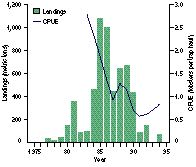
The only significant lobster fishery in the region exists in Hawaii (Polovina 1993; National Oceanic and Atmospheric Administration 1996). Lobster fisheries at other U.S. islands are small (Pitcher 1993). Recruitment of Hawaiian spiny lobsters and slipper lobsters has been low in recent years (Fig. 52) as a result of prevailing oceanographic factors (Polovina et al. 1994; see box on Hawaiian Monk Seal). The long-term potential yield of one million individuals in the early 1980's was revised downward to 200,000 in the 1990's (National Oceanic and Atmospheric Adminis-tration 1993). Annual catches have recently fluctuated around the long-term potential yield of 200,000, with 424,000 animals harvested in 1992 and 131,000 in 1994 (Haight and DiNardo 1995). The lobster fishery was closed in 1993 to allow stocks to rebuild, opened briefly in 1994, and closed again in 1995. Stocks are thought to be recovering (National Oceanic and Atmospheric Administration 1996), and new management strategies are being developed for this fishery (Wetherall et al. 1995).
|
Fig. 52. Hawaiian spiny lobster and slipper lobster landings and catch per unit effort (CPUE) in Hawaiian waters, 19751995. |
Attempts to develop deepwater shrimp fisheries at the Pacific Islands have been unsuccessful. The only sustained island shrimp fishery existed in Hawaii during 1977-1991. Declining catches and high costs made the Hawaiian shrimp fishery economically unfeasible, and the resource is not currently exploited (Polovina 1993). Shrimp fisheries at other U.S. islands have been limited to exploratory efforts (King 1993; Polovina 1993).
|
|
|
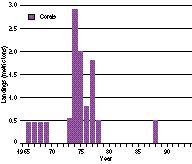
Precious corals have been harvested at the northern Hawaiian seamounts and on island slopes in the main and northwestern Hawaiian Islands (Grigg 1993; Fig. 53). No precious coral fisheries are established in other U.S. islands. Sustainable harvest of precious corals depends upon selective fishing techniques, but the prohibitive costs of these techniques has discouraged precious coral harvests in U.S. waters since 1988 (National Oceanic and Atmospheric Administration 1996).
|
Fig. 53. Landings of precious corals in Hawaiian waters, 19651994. |
Coral beds harvested by scuba divers or submersibles tend to remain productive, whereas deep coral beds exploited by nonselective tangle-nets or dredges are quickly depleted. Pink coral at seamounts north of Hawaii yielded 70 metric tons to tangle-net fishers in 1979, but by 1990 the coral was depleted and the fishery ceased. Deep coral beds on island slopes have also been overfished. In contrast, harvests of black coral and other shallow-dwelling species (in less than 100-meter depths) that are conducted by divers and by submersibles in the main Hawaiian Islands are selective and are now managed by minimum harvest size and quota (Grigg 1993; National Oceanic and Atmospheric Administration 1996). One unexplored question is the effect of precious coral harvest on other organisms, because soft corals serve as habitat for commensal species such as the longnose hawkfish, soft-coral gobies, and some shrimp species (Fig. 54). The extent of such associations is unknown. Coral tangle- netting and dredging obviously are habitat-destructive fishing techniques.
|
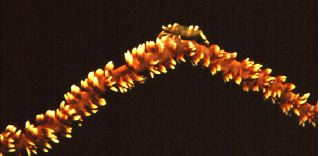
Fig. 54. A commensal shrimp on wire coral at 12-meter depths on Oahu, Hawaii. Courtesy B. Mundy, National Marine Fisheries Service |
Giant clams are an extreme example of invertebrates threatened by fishery overexploitation (Munro 1993; Fig. 55). Their high monetary value as food and the ease of their harvest have resulted in their overexploitation in many islands. The largest giant clam is locally extirpated in Guam and the Commonwealth of the Northern Mariana Islands, and the small giant clam is rare in Samoa (Lucas 1994) except at Rose Atoll (E. Flint, U.S. Fish and Wildlife Service, Honolulu, personal communication). Giant clams are currently protected by the Convention on International Trade in Endangered Species of Wild Fauna and Flora, but their market value in Taiwan and other Asian nations continues to encourage poaching. Cultured clams currently supply much of the demand, and pilot projects to restock depleted reefs with cultured clams are being evaluated (Lucas 1994).
|
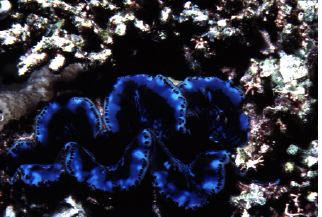
Fig. 55. A small giant clam at Palau. © B. Carlson, Waikiki Aquarium |
| Western Pacific Sharks |
|
Pelagic sharks form a large part of the bycatch of longline fisheries, though few except the shortfin mako and thresher sharks contribute major revenue to the fisheries (Bonfil 1994). Other sharks taken include the blue shark, oceanic whitetip, and silky shark. Almost 2 million blue sharks were taken by the North Pacific longline fishery in 1988, with another half million in the southern and western Pacific in 1989. The pelagic shark bycatch of disbanded North Pacific driftnet fisheries was also thought to have reached 2 million individuals by 1988. Blue sharks made up most of the driftnet bycatch, although salmon shark, shortfin mako, and cookie-cutter sharks also were caught. Much of the shark bycatch may not survive even if released. More sharks may be finned rather than landed whole; that is, the fins are cut from the sharks and retained for sale later, while the carcasses are discarded. Slow growth, large size at first reproduction, low fecundity, and long gestation periods relative to bony fishes make shark populations vulnerable to over exploitation.
|
|
|
| Oceanic Pelagic Fishes |
|
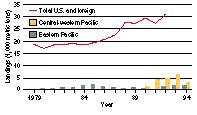
Tunas and billfishes have been considered rather resistant to overexploitation because of their high fecundity, vast ranges, and migratory capabilities. With its nearly cosmopolitan distribution, the swordfish is typical of large pelagic fishes. The rapid growth of a night longline fishery based in Hawaii increased the central-western Pacific swordfish catch from 50 metric tons in 1988 to 4,490 metric tons in 1991 (Skillman et al. 1993) and 6,100 metric tons in 1993 (National Oceanic and Atmospheric Administration 1996; Fig. 56). However, the Hawaii-based fishery declined to 3,100 metric tons in 1994. Total catches of swordfish in the U.S. and foreign Pacific Ocean region were about 29,000 metric tons in 1990-1992, with an estimated guess of long-term potential yield of 25,000 metric tons per year. A recent analysis suggested that Pacific stocks are now stable and underutilized, although catches in years since 1989 have exceeded the estimated long-term potential yield (National Oceanic and Atmospheric Administration 1996).
|
Fig. 56. Landings of swordfish by U.S. and foreign vessels in the Pacific Ocean (total), and U.S. landings in the eastern Pacific and the central-western Pacific, 19791994. |
Marlin, sailfish, and spearfish species are abundant in the open ocean and near island slopes, which arise steeply from the deep sea. The Kona coast of Hawaii is among the world's premier sport-fishing sites for marlin. However, the large size and great mobility of billfish make it exceedingly difficult to assess the status of their stocks (Skillman et al. 1993; National Oceanic and Atmospheric Administration 1996). Population levels are poorly known, and estimates rely on commercial bycatch statistics, which may reflect economic or technical fishery changes as much as biological fluctuations. Indo-Pacific blue marlin stocks are very important to recreational anglers and may be overutilized (National Oceanic and Atmospheric Administration 1996). Catch rates of these stocks in the Hawaii-based longline fishery declined from 115 kilograms per 1,000 hooks set in 1959 to less than 10 kilograms per 1,000 hooks in 1985 (Boggs and Ito 1993). In 1989, rates rose to 50 kilograms per 1,000 hooks, but this recent increase probably reflects altered fishing techniques rather than a stock increase. Limited entry and area closures in the Hawaii-based longline fishery have stabilized or reduced the longline catch of marlin. In Guam, blue marlin catches increased steadily from 15 metric tons in 1980 to 60 metric tons in 1990 (Myers 1993), and the small tournament and artisanal fishery for blue marlin in American Samoa (3-7 metric tons per year) has shown no long-term trend (Craig et al. 1993). Basic biological data on billfish species beyond catch per unit effort are grossly inadequate, making evaluation of stock changes tentative.
|
|
|
|
The current annual catch of fisheries for all highly migratory Pacific pelagic fishes until 1995 was near the estimated long-term potential yield of 1.8 million metric tons (National Oceanic and Atmospheric Administration 1996). U.S. contributions made up an average annual catch of 264,300 metric tons in 1990-1992. Knowledge of the status of most large pelagic fishes is poor because of these species' wide migratory ranges and the absence of a Pacific-wide international organization to monitor stocks. Tunas account for the greatest portion of the pelagic fisheries catch (Skillman et al. 1993; National Oceanic and Atmospheric Administration 1996; Table 10). |
Table 10. Status and trends of tuna stocks in the western Pacific.
| Species |
Status and trend |
| Albacore |
Northern stocks overutilized in 1980-1992, presently recovered but catches increasing; southern stocks uncertain |
| Bigeye tuna |
Estimates vary from under- to fully exploited |
| Skipjack tuna |
Underutilized |
| Yellowfin tuna |
Estimates vary from lightly to fully exploited |
|
| | |
| Coastal Pelagic Fishes |
|
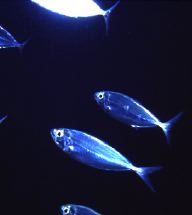
Small pelagic fishes that live near islands or seamounts form a trophic connection between coastal, slope, and pelagic ecosystems. Two of these coastal pelagic fishes, the bigeye scad (Fig. 57) and mackerel scad, are a major component of many nearshore Pacific island fisheries (Boehlert 1993; Dalzell 1993; Table 11). Bigeye scad is often the most frequently caught nearshore species in Hawaii and Guam, consistently ranking fifth or sixth among all nearshore commercial species harvested in these areas (see unpublished data reports cited in Hamm [1993], and later reports in the same series). Juvenile bigeye scad are targeted as they migrate into nearshore areas, forming an important component of the recreational fishery in Hawaii. The mackerel scad fishery is more localized, largely concentrated off the Kona coast of the island of Hawaii (Smith 1993). Both species undergo cyclic changes in abundance and seasonal migration patterns, resulting in wide variations in annual harvests. In Hawaii, 29% (184 metric tons) and 18% (113 metric tons) of the 1980-1990 mean annual commercial catch consisted of bigeye scad and mackerel scad, respectively (see unpublished data reports cited in Hamm [1993], and later reports in the same series). A small-boat fishing survey conducted on Oahu suggested that 115 metric tons of bigeye scad and 10 metric tons (combined recreational and commercial) of mackerel scad were landed in 1990 (Hamm and Lum 1992). Large seasonal runs of scad accounted for the majority of the annual fish catch in Guam in 1989 (76.5 metric tons; Myers 1993) and Samoa in 1991 (46 metric tons; Craig et al. 1993). There is no indication that bigeye scad are overutilized in Guam, Commonwealth of Northern Mariana Islands, and Samoa, but these fisheries should be closely monitored to better evaluate their status (Table 11). Life-history and population dynamics are not well known for either species, but state biologists conclude that bigeye scad and mackerel scad are fully utilized throughout the main Hawaiian Islands.
|
Fig. 57. Bigeye scad at 2-meter depth off Oahu, Hawaii.
Courtesy B. Mundy, National Marine Fisheries Service |
| Bottom Fish |
|
|
The pelagic armorhead fishery at the northern Hawaiian and Emperor seamounts exemplifies seamount fisheries vulnerable to overexploitation. This fishery peaked in 1972, with catches of more than 54 metric tons per hour, but dropped to 0.5% of that level by the early 1980's (National Oceanic and Atmospheric Administration 1993; Figs. 58 and 59). A 6-year moratorium on the fishery was declared in U.S. waters in 1986. Improved recruitment of armorhead was observed in 1990-1993, but increased catches resulting from this recruitment were short-lived, and populations of armorhead have not returned to their former levels (National Oceanic and Atmospheric Administration 1996). |
Table 11. Western Pacific nearshore fisheries--productivity in metric tons and status of fisheries.
| Area/species |
Recent average yield (metric tons) |
Fishery utilization level |
Stock level relative to long-term potential yield |
| Western Pacific region |
| Bigeye scada |
310 |
Full |
Unknown |
| Mackeral scada |
160 |
Full |
Unknown |
| Other inshore fisheriesa |
700 |
Full |
Unknown |
| Inshore reef fishesb |
90 |
Full |
Unknown |
| Inshore reef fishesc |
160 |
Full |
Unknown |
| Total |
1,420 |
|
|
| aMain Hawaiian Islands (1993-1995 average). |
| bGuam (1993-1995). |
| cAmerican Samoa (1993-1995 average). |
|
| | |
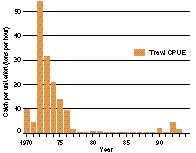
Bottom fish taken by slope fisheries include deepwater snappers, groupers, and jacks (Moffitt 1993). About 90% of the commercial bottom fish catch is taken in Hawaii (National Oceanic and Atmospheric Administration 1996; Fig. 60). Most U.S. mid-Pacific bottom fish stocks, including those of the northwestern Hawaiian Islands, have remained stable since 1985 after increasing from low levels in earlier years (Fig. 60). In contrast, bottom fish landings have declined in the main Hawaiian Islands since 1989 (Fig. 60), and stocks of four snappers and one grouper in the main Hawaiian Islands are thought to be at only 10%-20% of their original levels (National Oceanic and Atmospheric Administration 1993,1996; Table 12). Little information exists on the biology of slope resources in Guam, Commonwealth of the Northern Mariana Islands, or Samoa, making resource assessment difficult, but concern has been expressed about declining catches of slope fishes in Guam and Samoa (Craig et al. 1993; Myers 1993). Almost nothing is known about deepwater resources at the smaller, uninhabited U.S. islands.
|
Fig. 58. Catch of pelagic armorheads per unit effort (CPUE) by Japanese trawl vessels on North Pacific seamounts, 19701994. |
| Reef Animals |
|
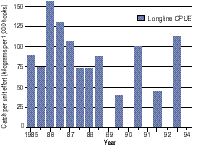
Most local reef fisheries use various gear types and seek several species. In more heavily populated areas, high fishing pressure from multigear, multispecies fisheries results in overexploitation of rare species whose harvest would be otherwise unprofitable (Munro and Fakahau 1993). This situation occurs with rare species that are highly susceptible to fishing gear and with the more abundant target species. In such instances, rare species continue to be caught as fishermen harvest the numerous other fish that occur in biologically diverse island habitats. An example may be the emperors, which make up a large portion of the fisheries catch in American Samoa (Craig et al. 1993), Guam (Myers 1993), and the Commonwealth of the Northern Marianas. Potential overexploitation is indicated by the estimated decline of annual emperor catches in Samoa and the Marianas from about 27 metric tons in the mid-1980's to about 12 metric tons in the early 1990's (see unpublished data reports cited in Hamm [1993], and later reports in the same series). Other species susceptible to continued fishery overexploitation in multigear, multispecies fisheries are the larger groupers, and also the giant humphead or Napoleon wrasse, which have become rare or locally extirpated at many populated Pacific islands. The emperors, groupers, and wrasses are protogynous hermaphrodites. They assume a functional female condition first during development before changing to a functional male state. The groupers often aggregate for spawning. These life-history characteristics make them particularly susceptible to overfishing because the fish are often caught before they change sex, thereby reducing the number of males in the population, and because fishers can target spawning aggregations for harvesting (Wright 1993). Both of these harvesting impacts reduce the reproductive success of these fishes to levels below that necessary to sustain the fishes' populations.
|
Fig. 59. Catch of pelagic armorhead on Southeast Hancock Seamount--catch per unit effort (CPUE) from bottom longlines of research cruises, 19851994. |
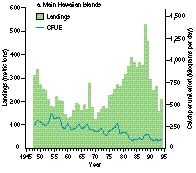
Fishing methods that involve habitat damage represent a unique threat to the region's marine resources (Munro et al. 1987; Norse 1993). In the past, extremely damaging practices of fishing with explosives or poisons were prevalent in the Pacific Islands (Alcala and Gomez 1987; Eldredge 1987; United Nations Environment Programme/International Union for the Conservation of Nature and Natural Resources 1988). Although these methods are now almost universally outlawed, poaching remains a problem in remote regions. Less extreme habitat-destructive harvest methods are also of concern. For example, in recent years, feather-duster worms have been harvested for the aquarium industry (Fig. 61). More than 90,000 feather-duster worms were estimated to have been harvested from Kaneohe Bay during 1991 and 1992 (Everson 1995). Feather-duster worms burrow into live coral, rubble, and rock, often necessitating breaking apart the substrate to remove them. The potential effect on Kaneohe's reefs from this growing industry is a point of concern. In answer to this, the State of Hawaii enacted legislation in 1993 which makes it "unlawful to intentionally take, break or damage, with crowbar, chisel or any other implement, any rock or coral to which marine life is attached or affixed."
|
Fig. 60. Bottom fishes landings and catch per unit effort (CPUE) at the main Hawaiian Islands (a), and the northwestern Hawaiian Islands (b), 19481994.
a. |
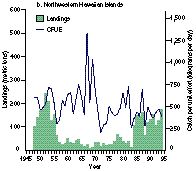
|
b. |
| Nearshore Resources: Coral Reefs |
|
Coral reefs are recognized as among the most productive and biologically diverse marine habitats (Fig. 62). They are also very susceptible to environmental degradation (United Nations Environment Programme/International Union for the Conservation of Nature and Natural Resources 1988; Maragos 1993). Although reefs were once thought to be extremely fragile, it is now believed that their ability to recover from natural disturbance contributes to their high diversity. Even so, human exploitation of and damage to coral habitats add to natural disturbances, slowing natural recovery (Wilkinson 1992). For this reason, corals are now protected from human harvest by the Convention on International Trade in Endangered Species of Wild Fauna and Flora. In general, practices destructive to corals and coral reefs are discouraged or illegal in U.S. Exclusive Economic Zones.
|
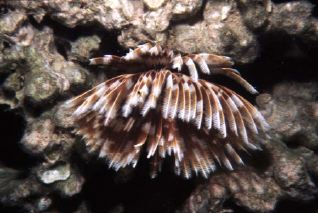
Fig. 61. A feather-duster worm at 1-meter depth on a nearshore reef off Oahu, Hawaii. Courtesy B. Mundy, National Marine Fisheries Service |
|
An example of human perturbation, habitat degradation, and recovery of a coral reef system can be found in the changes that occurred in Kaneohe Bay, Oahu, Hawaii (Hunter and Evans 1995). Kaneohe Bay's southern basin once contained some of Hawaii's largest pristine coral reefs. Extensive dredging occurred between 1939 and 1945 during construction of Kaneohe Marine Corps Air Station, which directly damaged reefs, while much of the dredge material was dumped into the bay, often burying coral. In later years, runoff resulting from clearing the surrounding hillsides for housing developments increased sedimentation. Beginning in 1951 and 1963, raw and secondary treated sewage were discharged directly into the bay from two sewage treatment plants. By the mid- 1970's, nutrient enrichment from the pollution of Kaneohe Bay's southern basin caused a bloom of bubble algae, which grew in large mats, smothering coral and associated fauna. Sewage was diverted to deepwater outfalls outside the bay in 1977-1978, after the University of Hawaii's Institute of Marine Biology published several reports detailing the problem. Sewage diversion, combined with stricter control over sediment runoff during construction projects, gradually improved Kaneohe Bay's water quality. Renewed threats to the bay's habitats in the 1990's have come in the form of nonpoint-source pollution and water diversion (Hunter and Evans 1995). |
| Species/area |
Recent average yield (metric tons) |
Current potential yield (metric tons) |
Fishery utilization level |
Stock level relative to long-term potential yield |
| Bottomfish |
|
|
|
|
| Main Hawaiian Islands |
249 |
111 |
Overutilizeda |
Below |
| Northwestern Hawaiian Islands |
184 |
222 |
Underutilized |
Near |
| American Samoa |
18 |
34 |
Underutilized |
Near |
| Guam |
24 |
25 |
Near |
Near |
| Commonwealth of the Northern Mariana Islands |
17 |
78 |
Underutilized |
Near |
| Pelagic armorhead |
0 |
0 |
|
|
| Total |
492 |
470 |
|
|
aOverutilized for five species; other species underutilized. |
|
Table 12. Western Pacific bottom fish and armorhead--productivity in metric tons and status of populations. |
Dredging, coastal development, and nonpoint-source pollution have damaged coral reefs on most U.S. islands (United Nations Environment Programme/International Union for the Conservation of Nature and Natural Resources 1988; Maragos 1993). Dredging and other military activities were extensive in the Pacific during World War II, but recovery of reefs has occurred on the smaller, uninhabited islands. Postwar population growth and urbanization have affected many of the larger islands. Oahu, Hawaii, is the most extreme example. Dredging of harbors and inland construction in the vicinity of Honolulu deposited sediment over reefs, while other reefs were filled to provide new land, including an airport runway. Attempts to stabilize beaches at Waikiki included adding seawalls and groins, which changed beach erosion and deposition patterns. Continued erosion prompted replacement of lost sand with material brought from elsewhere. The eroded sand, including imported material, moved offshore, smothering reefs seaward of Waikiki. Other shorelines on U.S. islands with heavy coastal development include the area from Tumon Bay through Apra Harbor on the west side of Guam, and the northwest shore of Saipan. Nonpoint-source pollution occurs not only in urbanized areas of Pacific Islands but also where extensive erosion occurs from inland land-clearing or where nutrients, herbicides, and pesticides from agricultural activities join freshwater runoff flowing into nearshore habitats.
|
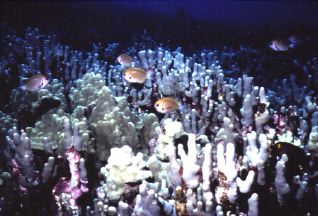
Fig. 62. Agile damselfish over finger coral at 12-meter depth on Hawaii Island. Courtesy B. Mundy, National Marine Fisheries Service |
Sea Turtles |
|
|
Five sea turtle species occur at U.S. Pacific Islands (Márquez 1990; Eckert 1993), all protected by the Endangered Species Act (National Oceanic and Atmospheric Administration 1996; Table 13). Although there is one record of the threatened olive ridley turtle nesting in Hawaii, most of its reproductive colonies are in continental coastal areas, and olive ridleys are nearly unknown around oceanic islands. The loggerhead turtle has been recorded in the Mariana Islands, Samoa, and Hawaii, but it is uncommon off of Hawaii, being primarily associated with continents and boundary currents rather than islands. Loggerheads do not nest in the U.S. Pacific Islands. Loggerheads are listed as threatened under the U.S. Endangered Species Act and as vulnerable by the International Union for the Conservation of Nature and Natural Resources. The leatherback is a pelagic sea turtle that probably occurs near all U.S. Pacific Islands--although it nests in none--with records from the Commonwealth of the Northern Mariana Islands, Guam, and Hawaii. Leatherbacks are listed as threatened by the U.S. Endangered Species Act and as endangered by the Convention on International Trade in Endangered Species of Wild Fauna and Flora and the International Union for the Conservation of Nature and Natural Resources. The hawksbill is present at all U.S. islands and nests at many. Hawksbills are listed as endangered by the U.S. Endangered Species Act, the International Union for the Conservation of Nature and Natural Resources, and the Convention on International Trade in Endangered Species of Wild Fauna and Flora. About 150 adult hawksbills were estimated in Hawaii during 1997, with only about 35 nesting females. The number of hawksbills in Samoa and Guam is unknown, but nesting has been observed at Rose Atoll and the Manua Islands. The status of leatherback, hawksbill, and loggerhead sea turtles throughout the Pacific is poorly known, but mortality of leatherbacks from fishery bycatch and continued exploitation of hawksbills for their shells in areas outside of the United States make them a special conservation concern (Eckert 1993; Wetherall et al. 1993; National Oceanic and Atmospheric Administration 1996). |
| Area/species |
Historical level |
Current levela |
Trend |
Status in United States |
| Atlantic region |
|
|
|
|
| Loggerhead |
Unknown |
20,000-28,000b |
Stablec |
Threatenedd |
| Green |
Unknown |
400-500b |
Increasing |
Threatened, endangerede |
| Kemp's ridley |
40,000 |
700-800f |
Stablec |
Endangered |
| Leatherback |
Unknown |
Unknown |
Unknown |
Endangered |
| Hawksbill |
Unknown |
Unknown |
Declining |
Endangered |
| Pacific region |
|
|
|
|
| Loggerhead |
Unknown |
Unknown |
Stable |
Threatened |
| Green |
10,000 |
1,200g |
Increasingh |
Threatened |
| Olive ridley |
Unknown |
Unknown |
Increasing |
Threatened |
| Leatherback |
Unknown |
Unknown |
Declining |
Endangered |
| Hawksbill |
Unknown |
>150i |
Unknown |
Endangered |
| aEstimates of sea turtle abundance as indicated by number of female sea turtles nesting on U.S. beaches. |
| bUsing 2.5 nests per female. |
| cStable but critically low. |
| dListed as threatened under the Endangered Species Act. |
| eListed as endangered in Florida; threatened in the U.S. Atlantic and Pacific. |
| fUsing 1.5 nests per female. Kemp's ridley turtles nest only on one Mexican beach. |
| gHistorical level for Hawaii only. Estimated 1995 nesting female population is 1,000 in Hawaii; 100-300 in American Samoa; current level in Guam is unknown. |
| hTrend in Hawaii only, monitored at French Frigate Shoals; however, great concern exists over increasing frequency of fibropapilloma disease in all Hawaiian green turtles. |
| iEstimated total adult population in Hawaii; average number of female hawksbills nesting annually in Hawaii is about 35. Current abundance in Guam and American Samoa is unknown. |
|
Table 13. Status of sea turtles in U.S. waters. |
The green turtle is the most abundant sea turtle in the region, probably present at all U.S. islands (Eckert 1993). Green turtles are listed as threatened in most areas by the U.S. Endangered Species Act and as endangered by the International Union for the Conservation of Nature and Natural Resources and the Convention on International Trade in Endangered Species of Wild Fauna and Flora. The historical Pacific green turtle population is estimated to have been about 10,000 (National Oceanic and Atmospheric Administration 1993). In 1997, about 1,000 individuals were estimated to nest in Hawaii, with more than 500 of these at French Frigate Shoals in the northwestern Hawaiian Islands, where more than 90% of their nesting in Hawaii occurs. An additional 100-300 green turtles are estimated to be nesting in American Samoa, primarily at Rose Atoll, but the numbers at Guam were unknown, with only sporadic nesting recorded (National Marine Fisheries Service, unpublished data). The population nesting at French Frigate Shoals is thought to be increasing. In the main Hawaiian Islands green turtles are under threat from lethal fibropapillomas (tumors) of unknown cause (Herbst 1994). In 1991, 31% of Kaneohe Bay's green turtles were afflicted, and in 1989-1990, 77%-85% of the stranded turtles on Maui had fibropapillomas. Research to determine the cause of this disease is a high priority for green turtle conservation because the Hawaiian population was among the few increasing stocks before the disease became prevalent (Fig. 63).
|
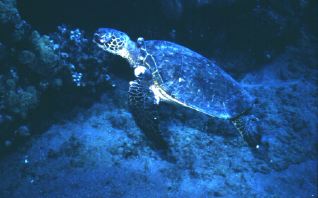
Fig. 63. A green turtle afflicted with a fibropapilloma disease of unknown cause. Courtesy B. Mundy, National Marine Fisheries Service |
Marine Birds |
|
Pacific island seabird populations are only a remnant of what they were before the arrival of humans and introduced mammalian predators (Steadman 1995). Different seabird species are vulnerable to different introduced predators, depending on their size and nesting habits (Croxall et al. 1984; Vermeer et al. 1993). Tree-nesting species are relatively immune to predation by most nonclimbing animals (Flint 1997); white terns may even be observed nesting in urban areas such as Honolulu.
|
|
|
Small, ground-nesting birds (Fig. 64) are particularly defenseless against the entire range of introduced predators, from rats to dogs. Of 53 extant Pacific island seabird species (Flint 1997), 34 are vulnerable to the rats introduced during the migrations of indigenous peoples and European colonization (Harrison et al. 1984; Flint 1997). On most of the Pacific Islands, small seabird species vulnerable to predation by rats are now extinct (Garnett 1984). Larger ground-nesting birds are able to defend nests and young from rats, and the very largest can sometimes fend off larger predators like domestic cats or mongoose. Cats, introduced by Europeans, have been a major problem for seabirds that can survive rat predation. Recent cat elimination programs have been successful on some islands, giving populations of larger seabirds a chance for survival. Populations of larger seabirds on Howland and Jarvis islands seem to be recovering following this effort by the U.S. Fish and Wildlife Service (Flint 1997). Cats were eradicated from Baker Island in the 1960's, and all seabird populations except the small, burrow-nesting shearwaters, petrels, and storm-petrels have recovered there. Three burrow-nesting species (that is, procellariform or tubenoses) have been seen nesting at Jarvis, giving hope that all seabird populations will eventually recover there. An experimental rat control program was conducted in 1990 at Rose Atoll, the major seabird nesting site of American Samoa, with apparent success; rats were not found there by a U.S. Fish and Wildlife Service survey in 1993 and in subsequent surveys.
|

Fig. 64. A Bonin petrel in its nesting burrow in Hawaii. Courtesy E. Kridler, U.S. Fish and Wildlife Service |
Although relatively immune from predation by introduced species, albatross populations have been diminished by hunting and other factors. Black-footed albatrosses are now restricted to breeding colonies in the Northwestern Hawaiian Islands and Japan's Izu and Ryukyu islands (Croxall et al. 1984; Fig. 65). Breeding colonies are extinct at Wake, Johnston, and the northern Marianas. Laysan albatrosses exist in greater abundance (Fig. 66). Albatrosses can constitute a significant bycatch of epipelagic fisheries (McDermond and Morgan 1993). For example, an estimated 17,500 Laysan albatrosses were taken as bycatch of North Pacific driftnet fisheries in 1990, reducing the population's recovery rate by 0.4%-1.6% per year (Gould and Hobbs 1993). The estimated annual bycatch of black-footed albatrosses was 4,400 birds, or 2.2% of the population. The problem of high rates of albatross mortality from the bycatch in driftnets is presumed to be eliminated now that driftnet fisheries are outlawed, but the bycatch of albatross by pelagic longline fisheries remains a conservation concern.
|
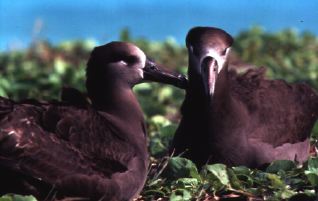
Fig. 65. Black-footed albatross at Tern Island, French Frigate Shoals, Northwest Hawaiian Island National Wildlife Refuge. Courtesy E. Flint, U.S. Fish and Wildlife Service |
|
The status and trends of tropical Pacific island seabird populations are best known for the Hawaiian Islands (Table 14). Species nesting in the northwestern Hawaiian Islands have often suffered declines on one or more of the islands, but most generally have stable populations or populations that have not been adequately assessed to determine trends (Harrison et al. 1984; Flint 1997). Several smaller seabird species in Hawaii are a source of special conservation concern: the dark-rumped petrel, Bonin petrel, Newell's Townsend's shearwater, band-rumped storm-petrel, Bulwer's petrel, Tristram storm-petrel, and Christmas shearwater (Harrison et al. 1984; Flint 1997; U.S. Fish and Wildlife Service Pacific Island Ecoregion, unpublished data). |
Table 14. Status and trends of selected seabird species in the western Pacific with emphasis on the Hawaiian Islands. |
| Species |
Status and trend |
| Audubon's shearwater |
Status and trends unknown in most of range. Recolonizing Jarvis Island following U.S. Fish and Wildlife Service predator eradication programs |
| Black-footed albatross |
Most nesting occurs in the northwestern Hawaiian Islands with about 67,000 pairs. Populations declining in last decade |
| Blue-gray ternlet |
Population trends unknown but probably stable in areas unaffected by human disturbance or mammalian predators, such as Nihoa and Necker islands in the northwestern Hawaiian Islands |
| Bonin petrel |
Hawaiian populations greatly reduced. Increasing at Laysan and Lisianski islands. Declining at Midway Island, from 500,000 pairs (1984) to 7,500 pairs; successful nesting occurs only where U.S. Fish and Wildlife Service controls rats |
| Christmas shearwater |
About 14,000 individuals in Hawaii. Declined at Laysan and Lisianski islands but populations stable at reduced levels. Declining at Midway Island. Status and trends unknown in other archipelagos |
| Gray-backed tern |
Populations stable at Laysan and Lisianski islands but reduced from historical levels. Declining at Midway and Kure islands because of rat predation |
| Harcourt's storm-petrel |
Status and trends unknown; proposed for listing under the Endangered Species Act. Fledglings found on Kauai Island suggest breeding occurs there, but at risk from mammalian predators |
| Hawaiian dark-rumped petrel |
Endangered; subspecies endemic to Hawaii with most of the approximately 400-600 individuals nesting at Haleakala National Park, Maui. Nesting colonies of unknown sizes recently discovered at high elevations on Kauai. Trends unknown |
| Laysan albatross |
Most nesting occurs in the northwestern Hawaiian Islands with about 616,000 pairs. Populations stable |
| Newell's Townsend's shearwater |
Threatened; Hawaiian endemic. Most nesting colonies are on Kauai Island, which has about 4,000-6,000 individuals. Trends unknown |
| Short-tailed albatross |
Endangered. Number of sightings is increasing |
| Sooty storm-petrel |
Status and trends unknown. Important breeding colony on Nihoa Island in northwestern Hawaiian Islands |
| Sooty tern |
Populations stable in northwestern Hawaiian Islands except declining at Midway and Kure islands. Population trends unknown in main Hawaiian Islands |
| Wedge-tailed shearwater |
Status unknown. Trends variable. Declining where rats occur (for example, on Midway Island). Recolonizing Jarvis Island following predator eradication |
|
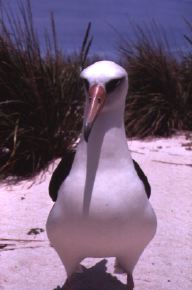
Less is known about seabird populations on other U.S. Pacific Islands. At least three seabird species once present on Johnston Island no longer nest there, but all 15 species that survived have stable or increasing populations (Harrison et al. 1984; Flint 1997). Rats are established on Palmyra, and dogs have been introduced at various times. Small, ground- nesting shearwaters and petrels were absent in a 1992 survey of Palmyra, perhaps as a result of rat predation (U.S. Fish and Wildlife Service Pacific Islands Ecoregion, unpublished data). Most seabird nesting in the northern Marianas occurs on Naftan Rock, Gaguan, Maug, and Uracus, all wildlife refuges, and on Farallon de Medinilla, a bombing range (United Nations Environment Programme/International Union for the Conservation of Nature and Natural Resources 1988; Reichel 1991). Introduced mammals threaten seabirds at all of these. On Guam, the introduced brown tree snake threatens populations of white terns, brown noddies, and white-tailed tropicbirds (Reichel 1991). This snake has extirpated most of the terrestrial birds in Guam not already driven to extinction by rats and is clearly a major conservation problem (Fritts and Rodda 1995).
|
Fig. 66. Adult Laysan albatross at Lisianski Island in the Northwest Hawaiian Islands National Wildlife Refuge.
Courtesy E. Flint, U.S. Fish and Wildlife Service |
Only six of the eight island countries with healthy seabird communities have wildlife reserves, and only three of these, including the United States, have eradication programs for nonindigenous predators (Flint 1997). The small number of reserves and predator control programs gives the most protected seabird nesting islands extreme global importance. Notable among pristine Pacific Island nesting sites are the northwestern Hawaiian Islands, Howland, Baker, and Jarvis islands, and Rose Atoll.
|
|
|
Marine Mammals |
|
The western Pacific Ocean region supports 26 species of marine mammals (Jefferson et al. 1993; Table 3). Three are recorded from the region only as strays, and two are restricted to the subarctic and transitional waters of the North Pacific, occurring only within the region at the northernmost Hawaiian Ridge seamounts and islands. Bottlenose dolphin, otherwise circumglobal, are known only from Hawaii on the Pacific tectonic plate; this distribution pattern has been seen for other organisms (Springer 1982) and is probably not an artifact of observation. In contrast, whitebelly spinner dolphin is absent from the central North Pacific, including Hawaii, but probably occurs at the other islands. The tropical bottlenose whale is known only from the equatorial Pacific. The remaining cetaceans probably occur at all U.S. islands, although records are uneven and many have migration patterns that concentrate them in particular regions seasonally (Stone et al. 1997).
|
|
|
There are few assessments of population sizes (Klinowska 1991) or estimates of trends in population changes (National Oceanic and Atmospheric Administration 1993, 1996) for marine mammals at the U.S. Pacific Islands. Regional population information is totally absent for 14 species. Four dolphin species have large, stable populations in the eastern Pacific, but population estimates are lacking at U.S. islands, except for those of spinner dolphins in Hawaii. Estimates of population size for the northern right whale dolphin vary widely, creating great uncertainty in the assessment of mortality and subsequent recovery from the high-seas drift net fisheries (Hobbs and Jones 1993).
|
|
|
According to the criteria provided in the 1994 amendments to the Marine Mammal Protection Act, there are four strategic marine mammal stocks in Hawaiian waters: blue whales, fin whales, and sperm whales--all of which are listed as endangered under the U.S. Endangered Species Act--and the Hawaiian monk seal, which is both endangered and listed as depleted under the Marine Mammal Protection Act. The Hawaiian Islands are also visited each winter by endangered North Pacific humpback whales, which breed throughout the islands but concentrate near Maui, Kahoolawe, Lanai, and Molokai. In addition, endangered sei whales occur throughout the Pacific Island region. With the exception of the Hawaiian monk seal, whose decline has been discussed in the accompanying highlight box, the population trends of these stocks are unknown (Klinowska 1991; National Oceanic and Atmospheric Administration 1996). Nothing is known of the status of marine mammal stocks at U.S. Pacific Islands other than Hawaii.
|
|
|
Humpback whales in the eastern North Pacific Ocean use the insular shelves of Hawaii during the winter calving season after migrating from the temperate and subarctic waters of northern California and Alaska where they feed (Klinowska 1991; National Oceanic and Atmospheric Administration 1993; Fig. 67). A western population of humpback whales winters as far south as the Commonwealth of the Northern Mariana Islands, although most of this population remains in the Ryukyu and Ogasawara islands of southern Japan. Previously, North Pacific humpback whales were estimated to be at 13% of their pre- whaling (around 1850) population of 15,000 (National Oceanic and Atmospheric Administration 1996). Photographic identification of individual whales and other evidence suggest that the total population now exceeds 3,000 (National Oceanic and Atmospheric Administration 1996). There is too little information on humpback whales to judge whether populations are increasing and whether human activities may be affecting their recovery. Some female humpbacks with calves apparently abandoned traditional nearshore nursery habitats near Maui, Hawaii, possibly in response to repeated human contact. Females with calves appear to have returned to these areas after restrictions on "thrill-craft" operations were implemented. In 1993, a National Marine Sanctuary for humpback whales was designated near Maui.
|
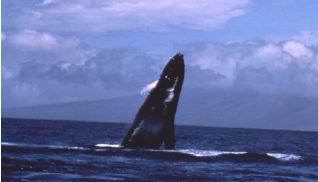
Fig. 67. Humpback whale breeching, western Maui. Courtesy L. Consiglieri, National Marine Fisheries Service |
National Status and Trends |
|
Estuarine Resources |
|
Many of the nation's commercial and recreational fisheries depend on estuaries. For example, the species making up the top four fisheries in the Gulf of Mexico (shrimp, menhaden, oyster, and blue crab) use estuaries extensively, and the quantity, quality, and timing of freshwater inflow to these areas can be particularly important to the within-year and between-year success of these fisheries (Stickney 1984; Turek et al. 1987). Several of the most valuable south Atlantic fisheries (for example, shrimp, blue crab, hard clam, and summer flounder) are also estuarine-dependent. In the North Atlantic, softshell clam, Atlantic salmon, Atlantic herring, winter flounder, and other fishery species require or prefer estuarine areas at some time of the year. Although the relative area of estuarine habitat in the Pacific region is small, three of the top five most valuable fisheries (salmon, Dungeness crab, and oyster) are all estuarine-dependent.
|
|
|
Mollusks are of special concern in estuaries because they are sessile. In 1990, more than 69,000 square kilometers of estuarine waters nationwide were classified as shellfish harvest areas (National Oceanic and Atmospheric Administration 1991b). However, many areas were occasionally restricted for harvest because of public health threats from bacterial or viral contamination. Urban stormwater runoff, sewage treatment plant effluent, agricultural runoff, and increased boating activity are the primary causes of harvest restrictions (National Oceanic and Atmospheric Administration 1990a, National Oceanic and Atmospheric Administration, unpublished data).
|
|
|
Humans place a high value on estuarine areas for living, working, and recreating. Estuaries provide cooling waters for industry and energy production and sites for aquaculture, accommodate the needs of large ships and tanker traffic, buffer coastal areas against storm and wave damage, provide wetlands and bottom habitat, supply space for coastal development, and accumulate pollutants from the rivers and streams entering coastal waters. Estuarine areas are among the most densely populated and heavily used areas in the United States and are home to an estimated 45% of the country's human population (Culliton et al. 1990). As human populations grow, demands for increased use of estuarine resources are expected to continue.
|
|
|
Coral Reef Ecosystems |
|
Coral reef ecosystems can be classified in two broad categories: pristine coral reefs and coral reefs at risk. Pristine coral reef ecosystems are those in remote locations with little or no human threat to ecosystem health. By definition (and with minor localized exceptions) the status of these ecosystems is good and the trend in health is steady. Areas under U.S. jurisdiction with pristine coral reef ecosystems include the Flower Garden Banks in the Gulf of Mexico, and, in the Pacific Ocean, the uninhabited northwest Hawaiian Islands, Wake Island, the Northern Mariana Islands (except Saipan), Palmyra Atoll and Kingman Reef, Howland Island, Baker Island, and Jarvis Island.
|
|
|
Coral reef ecosystems at risk are located near human population centers, with some or all of the reefs experiencing local anthro-pogenic stress. Some important sources of stress include nutrient enrichment from sewage and agriculture, overfishing, and stress from high sedimentation caused by deforestation, agriculture, vessel traffic, and coastal runoff. The status of many coral reefs within these areas is poor, and the trends in their health are declining. However, because of the lack of comprehensive understanding of these ecosystems, it is difficult to make a statement on their status and trends on an islandwide or even reef-tract basis. Coral reef ecosystems at risk within U.S. jurisdiction include the Florida reef tract (Puerto Rico and the U.S. Virgin Islands in the western Atlantic and Caribbean) and, in the Pacific Ocean, the inhabited parts of the main Hawaiian Islands, Johnston Atoll, Guam, Saipan (Northern Mariana Islands), and American Samoa.
|
|
|
Time is running out for many of the coral reef ecosystems that are at risk. In a social climate of increasing human population and declining budgets for environmental issues, effects of stresses to the ecosystems are compounding faster than cases can be made for protective measures. Swift legislative efforts and public works programs to reduce nutrients, sediments, and overfishing may be the only way to save many of these areas for the benefit and enjoyment of present and future generations. Immediate remedies in these areas are therefore of critical importance.
|
|
|
Deep-Sea Resources |
|
Little information is available to assess the status and trends of deep-sea animals. General data suggest that deep-sea animals are long-lived and slow growing, except in the case of animals associated with hydrothermal vents and seeps. In such areas, where temperatures are significantly higher than normal at similar depths, communities of organisms have evolved that are specifically adapted to life based on bacteria that use sulfur from the vents as energy. The animals (for example, tube worms, mussels, clams, crabs, and shrimps) seem to have very high growth rates made possible by high temperatures and locally abundant food. In fact, such growth is a necessity because vents may last only for a few months, during which time animals must colonize the area, mature, and reproduce if the species are to endure. Jannasch (1995) reported that there are still about 50,000 square kilometers of unexplored submarine tectonic spreading zones girdling the globe, where several thousand hydrothermal vent sites are predicted.
|
|
|
Although it is difficult to reach, the deep sea can provide sources for minerals, food, and energy. Exploitable resources of all three are known to exist, although at present the cost of exploiting them is generally greater than their value. Hydrothermal vents are being considered as mineral sources with implications for the unique communities they support. Deep-sea animals seem unlikely to form the basis for viable fisheries, and because of their slow growth rate they are expected to be highly vulnerable to overfishing.
|
|
|
One potential but unexploited resource of the deep sea may be marine microorganisms. Most antibiotics of microbial origin come from one terrestrial taxonomic group, the order Actinomycetales. According to Fenical and Jensen (1993), the rate of discovery of new antibiotics from terrestrial actinomycetes is declining, meaning that new sources must be explored. Although terrestrial organisms exhibit great species diversity, marine organisms represent greater diversity based on evolutionary origin. Only a superficial examination of their potential as sources of bioactive agents has been made. Bacteria and microalgae, including the dinoflagellates that occupy a unique position between the plants and the animals, are showing extraordinary promise. Fenical and Jensen (1993) suggest that the diverse marine microorganisms "must be considered a major, but largely undeveloped (and undescribed), biomedical resource."
|
|
|
Fisheries Resources |
|
|
Fisheries resources are those taken for their commercial and recreational value. Their status has been comprehensively reported and periodically updated--by species and by major ecological group--by the National Marine Fisheries Service in the federal report Our Living Oceans (National Oceanic and Atmospheric Administration 1991c, 1992, 1993, and 1996). According to the 1996 report, the long-term potential yield of all fishery resources fished by the United States within its 200-nautical mile Exclusive Economic Zone was estimated at 8.14 million metric tons (Table 15). This yield represents about 7% of the world's yield potential of 120 million metric tons of marine and freshwater fisheries production. |
Table 15. Productivity of fisheries resources of the United States, 19921994 (National Oceanic and Atmospheric Administration 1996).
| Region |
U.S. long-term potential yielda |
U.S. recent average yield |
| Northeast |
844,810 |
449,730 |
| Southeast |
1,474,340 |
1,168,530 |
| Alaska |
4,423,670 |
2,733,300 |
| Pacific coast |
1,116,210 |
462,760 |
| Western Pacific |
283,340 |
242,490 |
| Total |
8,142,370 |
5,056,810 |
aCompiled from Table 2 from Our Living Oceans, 1995 (National Oceanic and Atmospheric Administration 1996). |
|
| | |
The total recent average annual catch by the United States during 19921994 was 5 million metric tons, or 62% of the long-term potential yield. The additional 38% potential yield was not realized because some of the stocks were underutilized while others have been overutilized and are currently no longer producing at their full long-term potential. By region, the percentage distribution of recent average catches was 9% Northeast, 23% Southeast, 54% Alaska, 9% Pacific coast, and 5% western Pacific.
|
|
|
The Northeast region's finfish and invertebrate resources have a combined long-term potential yield of 844,810 million metric tons, or 10% of the U.S. long-term potential yield. Recent annual catch totaled about 449,730
metric tons, or about 53% of the region's long-term potential yield because of significant overuse of some 18 stocks, principally groundfish species (Northeast Fisheries Science Center 1993). The long-term potential yield for
the Southeast region is about 1.47 million metric tons (18% of the U.S. long-term potential yield); recent catches have run about 1.17 million metric tons (National Oceanic and Atmospheric Administration 1996). The Alaska region dominates the fisheries resources that could be obtained in the long term for the United States (long-term potential yield of 4.42 million metric tons). Those resources are generally healthy, with current potential yield only 9% below long-term potential yield. Recent average catches have been steady at about 2.73 million metric tons, or 62% of Alaska's long-term potential yield. The Pacific coast fisheries resources have a combined long-term potential yield of 1.12 million metric tons (14% of the U.S. long-term potential yield). Recent catches were only 462,760 metric tons, or 41% of long-term potential yield, due to low abundance of coastal pelagic fishes. Most of the stocks are fully utilized or overutilized. The western Pacific fisheries resources include highly migratory pelagic fishes that migrate to and from other U.S. regions and to other countries in the Pacific. For the purpose of yield comparison, the highly migratory pelagic fishes are apportioned by the share that would accrue to the United States only. Thus, the long-term potential yield of fisheries resources in the western Pacific totals only 283,340 metric tons, or 3% of U.S. long-term potential yield. If all the available yields from this group are added, long-term potential yield would be almost seven times higher (or 2.04 million metric tons).
|
|
|
A rough estimate of the recreational marine finfish catch for the Atlantic and Gulf of Mexico coasts is about 300 million fish per year. On the Pacific coast, the recreational catch is at least 55 million fish, 25% of which are salmon. All recreational catch estimates are uncertain, since they are determined from random surveys of anglers.
|
|
|
It is difficult to assess the status of all nearshore species around the entire U.S. coast because they come under varied jurisdiction and data collection regimes. No firm estimates exist for long-term potential yield or current potential yield. Management authority is typically a regional, state, or local responsibility because most fisheries occur within the 3-mile interior boundary to the federally controlled Exclusive Economic Zone. Generally, Atlantic oysters, hard clams, softshell clams, bay scallops, and abalones are overutilized, at least in part of their ranges. Fully utilized resources include Pacific shrimps and clams, Dungeness crab, blue crab, and calico scallop. The 1992-1994 averaged catch has been conservatively estimated at 284,000 metric tons.
|
|
|
Marine Mammals |
|
Approximately 163 stocks of at least 62 species of marine mammals are found within waters of U.S. jurisdiction (Table 3). The U.S. Fish and Wildlife Service has authority for stocks of North Pacific walrus, Alaska polar bear, West Indian manatee, and Alaska and California sea otters, and the National Marine Fisheries Service is responsible for the remaining cetaceans and pinnipeds (155 stocks, including 10 eastern tropical Pacific dolphins). The 1994 Amendments to the Marine Mammal Protection Act identified strategic stocks as those that are listed as endangered or threatened under the U.S. Endangered Species Act or that are declining and likely to be listed in the foreseeable future, those designated as depleted under the Marine Mammal Protection Act (that is, below the optimal sustainable population level), and those for which human-caused mortality exceeds the estimated replacement yield. Of the 153 marine mammal stocks managed under Section 117 of the Marine Mammal Protection Act (using 1995 totals), 54 are classified as strategic. These include 2 stocks that are depleted under the Marine Mammal Protection Act, 4 that are listed as threatened and 24 listed as endangered under the Endangered Species Act, 16 for which the total annual mortality exceeds Potential Biological Removal, and 6 stocks for which information on stock status or fisheries-related mortality is uncertain. In addition, 2 of 10 stocks of eastern tropical Pacific dolphins managed under Section 104(h) of the Marine Mammal Protection Act are listed as depleted under the Marine Mammal Protection Act.
|
|
|
Of the total 163 marine mammal stocks in U.S. waters, there is sufficient long-term population information to describe trends for only 55 stocks (33%); the status of the remaining 108 stocks (66%) is unknown. Of those for which we have information, 24 (15%) are known to be increasing, 8 (5%) are declining, and 23 (14%) are believed to be stable. Once implemented by the National Marine Fisheries Service and the U.S. Fish and Wildlife Service, the new management regime established by the 1994 Marine Mammal Protection Act amendments will contribute to the long-term data base needed to detect and evaluate trends for all marine mammal stocks.
|
|
|
National Issues and Threats |
|
Overfishing |
|
Overfishing is recognized as a potential threat to living marine resources. Three historically important groundfish species (cod, haddock, and yellowtail flounder) on Georges Bank off New England are presently among the most overfished stocks in U.S. waters. Catches were projected to be only 23% of their combined long-term potential yield of 98,000 metric tons in 1994 and even lower in 1995. Haddock and yellowtail flounder are classified as collapsed by virtue of their current low abundance (biomass of spawners is about 10% of the mid-1970's levels)--due to prolonged excessive fishing pressure--and by catches less than 25% of long-term potential yield. The cod stock was in imminent danger of collapse in 1994, but drastic management measures reduced the fishing mortality rate by 83% and improved spawning stock biomass by 48% from 1994 to 1996. The cod stock, however, is still considered overexploited and at low population levels.
|
|
|
All five species of Pacific salmon (chinook, coho, sockeye, pink, and chum), which begin their lives in the rivers and streams of Washington, Oregon, and California, are considered overfished. However, the main cause for their decline appears to be related to freshwater habitat alterations, such as water diversion and river-stream blockage by hydroelectric dams, which cause severe restrictions on upstream (adult spawning) and downstream (juvenile migration to the ocean) movements. Intense fishing pressure from competing user groups is an additional problem. Commercial and recreational catches of these five species have fluctuated widely and have averaged in total about 75% of the long-term potential yield (11.8 million fish per year) in the last several years.
|
|
|
In the Gulf of Mexico, king mackerel was severely depleted because of excessively high catches in the late 1970's and early 1980's. The population supports catches about 28% of long-term potential yield. Red snapper, traditionally the most important reef fish in the gulf, is taken mainly as incidental catch in the shrimp fishery and currently supports catches of only about 15% of long-term potential yield. Red drum was subjected to intense fishing in the 1980's in response to consumer demands for the Cajun dish blackened redfish and currently provides catches at about 35% of the long-term potential.
|
|
|
Examples of many other overfished stocks can be found throughout the country. Many are disproportionately affected by fishing because of their low numbers in relation to more abundant target species. In recent years there is growing awareness of responsibility and federal actions needed to mitigate overfished situations. To prevent overfishing, all federal fishery management plans require that numerical overfishing levels be defined and implemented according to sound population dynamics principles derived for each species' biological situation. Restrictions on catches are normally regulated in order to rebuild overfished stocks. Despite a vigilant watch for overfishing, resources do decline--some naturally, some through habitat change, and some through excessive fishing efforts.
|
|
|
Bycatch |
|
The incidental take of nontarget species in fishing operations reflects the situation that species do not live in pure, discrete, exploitable patches but as members of intermixing communities. The groundfish fisheries have notoriously visible bycatch problems. These fisheries, whether conducted with trawl gear, longlines, or pot gear, catch and discard large volumes of animals that are of the wrong size, species, maturity stage, or other distinguishing factor. For instance, as much as 80% of the catch of rock sole in the Bering Sea may be discarded because the individual fish are not the valuable roe-bearing females. According to a comprehensive report on bycatch amounts worldwide, Alverson et al. (1994) estimated that 20%-40% of groundfish caught may be discarded routinely in fisheries of the United States and other parts of the world. Bycatch in these fisheries may be a serious threat to species already low in abundance.
|
|
|
Habitat Alterations |
|
Habitat degradation and loss affect mostly inshore and estuarine ecosystems. The primary threats are wetland destruction, alteration of freshwater flows, toxic chemicals, and nutrient overenrichment. Alterations to the freshwater input through damming and diversions of major rivers have affected coastal systems adapted to seasonal discharges of fresh water. Loss of aquatic plant-based habitats (for example, wetlands, eelgrass, and kelp beds) resulting from development, such as for marinas and docking facilities, adversely affects a variety of food webs that are important to adults and juveniles of several marine and anadromous species. Dredging and dredge disposal in estuaries and bays also cause significant habitat destruction. Marine ecosystems are damaged by habitat loss or alterations in rivers, such as effects due to certain forestry, industrial, and agricultural practices (for example, excess sedimentation, hydroelectric dams, dike construction).
|
|
|
Estuaries and coastal systems near urban areas are degraded by runoff from farmlands and by urban development. Much of the contaminant input to waters flowing seaward consists of organic substances having nutritional value for phytoplankton, which form the base of the food chain. Nitrogenous substances, a range of carbohydrates and fats, phosphates, and other nutrients from atmospheric contamination or discharges to rivers in the coastal zone, result in nutrient enrichment. For instance, some of the greatest standing stocks of phytoplankton and highest rates of primary production have been measured in coastal waters of the New York Bight, enriched by ocean dumping and nonpoint sources (O'Reilly et al. 1987).
|
|
|
Coral reefs subject to habitat degradation have exhibited a natural ability to recover from disturbance, but this recovery is hampered by further damage from human exploitation. The Convention on International Trade in Endangered Species of Wild Fauna and Flora protects coral reefs from destruction by human harvests.
|
|
|
Destructive fisheries methods also damage habitat. In the past, extremely damaging practices of fishing with explosives or poisons were prevalent in the Pacific Islands. These are now almost universally outlawed, but poaching by these methods remains a problem in remote regions of the western Pacific Islands. Less extreme habitat-destructive harvest methods are also of concern. Habitat alterations--for example, artificial reefs--can also be purposefully beneficial to living marine resources.
|
|
|
Nonindigenous Species |
|
Marine organisms have been transported from their original ranges to new localities since humans began using boats to cross oceans (Carlton 1987). Many of these introductions have been beneficial to humans as food sources, but introduced organisms can also affect indigenous species, threaten human health, and create financial burdens on human societies (U.S. Congress, Office of Technology Assessment 1993). No nonindigenous marine species have become as notorious or costly as the freshwater zebra mussel, introduced to the Great Lakes from Eurasia via ship ballast water in the 1980's (Nalepa and Schloesser 1993). The increasing alteration of community structure and function in estuaries and other coastal habitats by invasive species has prompted speculation that these may now be among the most threatened ecosystems on earth (Carlton and Geller 1993).
|
|
|
Among marine and estuarine examples, cholera bacteria, found in eastern oysters of Mobile Bay, Alabama (Motes et al. 1994), were probably transported via ballast water in ships arriving from South America (McCarthy and Khambaty 1994). Asian clams introduced to San Francisco Bay filter plankton from water so efficiently that they capture much of the bay's productivity at the expense of its fishes (Nichols et al. 1990). The capacity of the San Francisco Bay drainage to sustain valuable fisheries production may be reduced as a consequence. Many other nonindigenous marine organisms are found in all regions (DeVoe 1992; Rosenfield and Mann 1992). Because the taxonomy and biogeography of many families of organisms are poorly investigated, the number of nonindigenous species in U.S. waters is likely underestimated (Chapman and Carlton 1991).
|
|
|
Many introductions of aquatic species were intended to enhance fisheries productivity or to establish organisms of cultural importance as people immigrated to new regions. For example, Pacific oysters introduced to the U.S. Pacific coast from Japan now account for much of the aquaculture production in that area. The introduction of this species to Chesapeake Bay was proposed as a way to rebuild a declining Eastern oyster fishery. Managers argued that introduced Pacific oysters would compete for food and nursery space with the native oyster, or carry new diseases and predators to the east coast (Mann et al. 1992). The dangers of introductions are now better appreciated, and numerous regulations exist to control them (DeVoe 1992; Rosenfield and Mann 1992; Aquatic Nuisance Species Task Force 1994a,b; also see chapter on Nonindigenous Species). In most cases, the risks from intentional introductions are compared to the benefits before decisions are made. Even so, unforeseen adverse effects from introductions do occur (Aquatic Nuisance Species Task Force 1994a).
|
|
|
Unintentional introductions are increasing even as intentional introductions have declined (Aquatic Nuisance Species Task Force 1994b). Unintentional aquatic introductions include the release of ornamental organisms from the aquarium trade, the accidental release of cultured species, and the release of species into new areas by transport via ships' ballast waters. Release of aquarium species is a problem of increasing magnitude in fresh water; in Hawaii, for example, about 20-25 freshwater ornamental species have become established since 1980 (Devick 1991). Records of nonindigenous marine aquarium organisms from Florida (Courtenay 1995) and Hawaii (Randall 1995) indicate that this is a potential problem, but thus far, aquarium releases have had little effect on marine systems.
|
|
|
The discovery of nonindigenous shrimp species in the waters of South Carolina is an example of the more common problem of introductions from aquaculture sources. Pacific black tiger prawns and Pacific white shrimp, introduced when animals escaped from aquaculture ponds, have both been taken by South Carolina shrimp trawlers in the 1980's (Wenner and Knott 1992). Pacific white shrimp in particular are known to sometimes harbor infectious hypodermal virus, hematopoietic necrosis virus, and other diseases that could devastate native shrimp stocks (Brock 1992). Another mechanism of unintentional introduction is net pen escapes. Atlantic salmon cultured in net pens in the Atlantic Northeast and Pacific Northwest are known to escape and may spawn with natural salmon runs, leading to erosion of local genetic integrity (Wing et al. 1992; Thomson and McKinnell 1995). Double-mesh nets and the use of sterile animals (triploidy) are ways to possibly reduce effects of net pen escapes.
|
|
|
The major source of successful introductions of marine species is presently thought to be ballast water (Carlton and Geller 1993). The huge quantities of ballast water that are transported and exchanged from port to port each year carry planktonic stages of numerous species around the world. Ballast water introductions are suspected of causing the increased incidence of toxic dinoflagellate blooms (red tides) in Australia (Hallegraeff and Bolch 1992), the collapse of fisheries in the Black Sea (Harbison and Volovik 1993), and the alteration of estuarine community structure in San Francisco Bay (Nichols et al. 1990). Ballast water introductions are clearly a major concern for the future.
|
|
|
Nonindigenous organisms are difficult or impossible to eradicate once they become established (U.S. Congress, Office of Technology Assessment 1993). The effects of introductions are impossible to predict. Slowing the spread of nonindigenous marine species and reversing the effects of introduced species already established are conservation problems of growing importance (see chapter on Nonindigenous Species).
|
|
|
Transboundary Stocks |
|
Many living marine resources straddle the boundaries between states and between countries, complicating their exploitation and management. Effective conservation and management of these resources require coordination, cooperation, and agreement among the respective management entities. Stocks located within the waters of more than one state are, to an increasing extent, managed by interstate compacts. An example of a successful interstate management program for a shared resource is the recovery of Atlantic striped bass (National Oceanic and Atmospheric Administration 1993). After Atlantic striped bass were reduced to very low abundance in the 1970's, a plan was developed by the Atlantic States Marine Fisheries Commission which called for a series of tight restrictions on fishing during 1981-1990, followed by a gradual relaxation of controls as remedial measures began to take effect, and culminating in a declaration in January 1995 of full stock restoration.
|
|
|
Stocks living totally or primarily within federal waters are managed by plans prepared by regional fishery management councils and implemented and enforced by the National Marine Fisheries Service. Stocks whose distribution overlaps the jurisdiction of more than one regional council require the participation of several councils.
|
|
|
Most stocks that extend beyond the U.S. Exclusive Economic Zones are managed wholly or in part under international conventions. In the Atlantic, highly migratory species such as bluefin tuna and swordfish fall under the jurisdiction of the International Commission for the Conservation of Atlantic Tunas. Regulation of these particular species is difficult because international consensus is not always reached on catch levels for these high-value fish, nor are agreed measures always equally enforced by all nations.
|
|
|
Another example in which shared management of transboundary stocks has not worked well is on Georges Bank. A 1984 World Court decision resolving the United States-Canada maritime boundary dispute awarded each country part of the bank. The resulting Hague Line gave each country custody of the fisheries occurring in their respective waters on stocks that were distributed over the entire bank. In spite of the obvious need for joint management of important stocks such as cod, haddock, pollock, yellowtail flounder, and sea scallops, each country has so far exercised separate control of fisheries in its own zone. The lack of joint management has been an important factor in the present severely overfished condition of most of these stocks.
|
|
|
In some cases, foreign fisheries target migrating stocks originating in the United States but found outside the U.S. Exclusive Economic Zone, which can be a threat to U.S. management of those stocks. One such example was the interception of U.S. pollock stocks found in the international zone of the central Bering Sea, known as the Donut Hole area. Several international meetings were organized to solve the problem, and a temporary agreement was reached among the parties to cease fishing for 1992-1995. In 1994, an international treaty was drawn up to replace the temporary agreements and to manage the Aleutian Basin pollock stock.
|
|
|
Salmon in both the Atlantic and the Pacific, which begin life in freshwater rivers and streams and migrate to the open ocean to mature before returning to their home waters to spawn, are subjected to fishing in both domestic and foreign waters. Heavy exploitation in commercial fisheries off Greenland of Atlantic salmon that originate in the United States has recently been reduced through control measures implemented by the North Atlantic Salmon Conservation Organization. On the Pacific coast, some salmon of U.S. origin are intercepted by Canadian fishermen while the fish migrate through Canadian waters, whereas some sockeye and pink salmon originating in the Fraser River of Canada are caught by U.S. fishermen when the fish move through from U.S. waters. The always-contentious allocation of catches from stocks originating in each country to fishermen from the two countries is handled by the United States-Canada Pacific Salmon Commission. In the Pacific Ocean, driftnet fishing for salmon in high seas is now banned under a United Nations General Assembly Resolution and by the North Pacific Anadromous Fish Commission.
|
|
|
Effects of Commercial Fisheries on Marine Birds and Mammals |
|
The ecological effects of commercial fisheries on marine birds and mammals are still largely unknown. Estimates of kills of marine mammals by direct interactions with fishing gear are generally low for most U.S. fisheries; however, there are significant fisheries-related mortalities of some marine mammals. The magnitude of direct kills of marine birds due to interactions with fishing activities is not well known (Johnson et al. 1993).
|
|
|
An important indirect threat to marine birds and mammals by fishing appears to be competition for fish. Marine birds and mammals consume a wide variety of fish species, some of which are commercially important. Many marine mammals in Alaska, particularly seals and sea lions, consume juvenile groundfish, whereas fisheries tend to target adult-sized groundfish. Thus, although direct competition for prey is reduced, commercial fisheries may disrupt prey availability through bycatch of small fish, removal of spawning fish, or general disruption of the food web.
|
|
|
Another ecological consequence of commercial fisheries is the fish-processing waste that can alter the feeding habits of some marine birds and mammals. Gulls, sea lions, bottlenose dolphin, and killer whales feed on fish wastes discharged by processing vessels and plants. Disposal of this waste at sea may create an artificial dependency that is not beneficial for the long-term well-being of the animals. Increases in predator populations (such as large gulls) resulting from this supplemental feeding may be detrimental to populations of their prey, such as other marine birds, and their buildup may also displace other bird species from their nesting areas.
|
|
|
Toxic Wastes and Public Health |
|
Toxic contaminants in estuarine and marine areas originate from a variety of sources, including industrial and sewage treatment plants, urban and agricultural runoff, and air pollution (see chapter on Environmental Contaminants). These contaminants include toxic metals, organic chemicals such as chlorinated hydrocarbons (for example, PCB's and DDT's), and petroleum compounds (for example, polycyclic aromatic hydrocarbons). Toxic effects can range from sublethal changes--such as growth inhibition--to death. Bottom fish species from a number of chemically contaminated areas in the vicinity of such major cities as Boston, New York, Los Angeles, and Seattle have exhibited liver cancers and other lesions that lead to liver cancer (Johnson et al. 1994). Although cancers are the most dramatic of the lesions observed, early degenerative or proliferative conditions are much more prevalent in animals from moderately contaminated sites. Others may suffer various types of reproductive impairment, such as inhibited spawning ability and reduced viability of eggs and larvae.
|
|
|
In addition to demersal animals, certain anadromous fish species, such as salmon, feed on sediment-dwelling organisms as the fish migrate through urban estuaries. During their relatively short residency, the fish can bioaccumulate significant concentrations of toxic chemicals through their diet. Little is known about the effects of contaminants on marine mammals, although there are ongoing studies on the effects of DDT and PCB's on California sea lions.
|
|
|
es, occasionally contain elevated levels of toxic chemicals that could be potentially harmful to human health. A variety of human health effects are also associated with the consumption of seafood containing marine toxins, such as paralytic shellfish poisoning and domoic acid or amnesiac shellfish poisoning. Paralytic shellfish poisoning results from the consumption of mollusks infected with specific strains of dinoflagellates. Domoic acid outbreaks have occurred in a variety of seafood products and have caused huge losses to the seafood industry. For example, in the fall of 1991, an outbreak of domoic acid poisoning in Monterey Bay, California, moved north along the coast and reached Washington and Oregon. Like paralytic shellfish poisoning, the primary route of human exposure to domoic acid is from the consumption of mollusks (for example, razor clams), although the viscera of Dungeness crab is also known to accumulate high levels of the toxin. The mechanism by which clams accumulate domoic acid is not clear, even though the diatom Pseudonitzshia australis has been implicated in the domoic acid poisoning of marine birds. Infectious microorganisms from agricultural and domestic sources can also contaminate clams, oysters, and other shellfish consumed by humans (Bourne and Chew 1994). This risk to humans has resulted in the closing of vast areas of coastal waters to shellfish growing and harvesting. Other types of poisonings from marine toxins have been reported but are less common in the United States.
|
|
|
Overall, the risks to human health from consumption of most seafood products containing chemical contaminants, microbial pathogens, or marine toxins from U.S. coastal waters are generally low, largely due to present management practices. However, a sufficient likelihood of occasional episodes of environmental contamination exists to warrant implementation of a seafood safety inspection program by the National Marine Fisheries Service, in cooperation with other federal agencies (such as the U.S. Food and Drug Administration) to ensure seafood quality and the detection of low levels of contamination.
|
|
|
Marine Debris |
|
Marine debris pollutes all of the world's oceans, but the problem hardly starts in the ocean itself. Close to 80% of the debris in the ocean is washed, blown, or dumped from shore. Such debris casts a wide net of effects over marine and littoral animals, plants, and perhaps even entire ecosystems. Biological studies tell us that waterborne litter entangles wildlife and masquerades as a food source, smothers beaches and bottom-growing plants, and provides a surface for colonizing small organisms that travel on marine debris to distant shores, perhaps with adverse ecological consequences. Entanglement is the most obvious of all biological effects on living marine resources. Entangled northern fur seals were spotted as early as the 1930's. We get only fleeting glimpses of entangled animals from planes and ships. Many die and sink or are eaten without being detected; others stay submerged and hidden beneath the debris. At least 135 species of marine vertebrates and 8 invertebrates have been reported entangled in marine debris. The list now includes most of the world's sea turtle species, more than 25% of marine mammal species, and more than 15% of marine bird species (Faris and Hart 1995; Fig. 68).
|

Fig. 68. Hawaiian monk seal killed by entanglement in marine debris. Courtesy J. Henderson, National Marine Fisheries Service |
Ingestion of marine debris can also be a serious threat to wildlife. Sea turtles mistake clear plastic bags for jellyfish, one of their favorite meals. Birds mistake plastic pellets for fish eggs. Other times, plastic is accidentally eaten in association with natural food. All are harmful, if not fatal. Ingested debris damages the digestive tract, causes starvation by blocking food, may be toxic, and often kills marine animals.
|
|
|
For centuries, humans, at sea and on land, have used the oceans as dumping grounds for waste. At present there are two global conventions to combat marine debris pollution from sea sources, the London Dumping Convention and the International Convention for the Prevention of Pollution from Ships (MARPOL 73/78). The land-based sources of marine pollution are beginning to be addressed globally in follow-up meetings to the 1992 United Nations Conference on Environment and Development. The United States is party to these forums and takes an active role in mitigating marine debris issues. Education and promotion of awareness of the problem and its many solutions seem the best way to combat this widespread pollution.
|
|
|
Taxonomic Knowledge |
|
There is much more to discover and learn about the taxonomy of many marine organisms (Winston 1992). This is due in part to the large number of animal and plant groups that are entirely or primarily marine. For the most part, these groups are composed of small species; the paucity of knowledge about these species is made evident by their lack of common names. On a regional basis, taxonomic knowledge may be ranked as best (first) for the Northeast because many of the nation's oldest and most numerous universities and museums are located there. Second or third in rank might be the Northwest region or perhaps Alaska, with the Southwest region ranked fourth because of elements of a richer subtropical biota found in its southern fringes. The Southeast region ranks fifth despite the long history of academic research in the region because subtropical areas and the tropical Caribbean contain large numbers of marine species that need taxonomic review. Last, with the most poorly known biota, is the western Pacific region; this region contains the largest number of species, covers the largest area, includes several global biogeographic regions, and has the shortest history of taxonomic research.
|
|
|
Taxonomic knowledge decreases with the depth of the ocean being considered (Winston 1992; Norse 1993). The marine biota most accessible to humans is that of the shoreline, thus it is the best known taxonomically. Sampling becomes a huge problem as one travels deeper into the ocean. Organized sampling of the deep sea did not begin until 1869 and 1872 with the Porcupine and Challenger expeditions (Mills 1983). Despite numerous oceanographic expeditions throughout this century, less is known about the identities and distributions of organisms the deeper one looks in the sea. For example, almost no biological samples have been taken from below 2,000 meters near any of the U.S. islands in the Pacific.
|
|
|
The ocean contains many more species than previously thought (National Research Council 1995). Entire communities of organisms, many undescribed, were found to live around deep-sea hydrothermal vents, at seepages of natural petroleum from the sea floor, and at areas of deepwater brine seepage. Studies of tropical invertebrates and algae continue to find that 25%-70% of the smallest species are new to science, even in areas like Waikiki, Hawaii, virtually at the front door of local universities and museums. Even well-known organisms--including certain mussels, oysters, shrimps, and crabs of the northeastern United States--have recently been found, with the advent of new genetic techniques, to consist of several physically similar but genetically distinct sibling species. Entire new groups of organisms continue to be found in the sea as exploration widens, including tiny algae (picoplankton) species that contribute to a significant portion of the earth's carbon cycling. The discoveries of previously unknown marine bacteria and the Archaea--organisms as different from bacteria as bacteria are from plants or animals--have altered perceptions of the role of marine microbes in the earth's geochemical cycles.
|
|
|
Ecosystem Biodiversity and Sustainability |
|
Human intervention and ocean warming cause changes in biodiversity and sustainability of biomass yields in marine ecosystems that are important to the economies of U.S. coastal regions. The diversity of ecological processes and the health of coastal ecosystems are being diminished by increased stress from human-induced toxic effluents, habitat degradation, excessive nutrient loadings, harmful algal blooms, emergent diseases, fallout from aerosol contaminants, and losses of living marine resources from pollution effects and overexploitation. A growing awareness that the quality of coastal ecosystems is being adversely affected by multiple forces has accelerated legislative efforts to encourage federal agencies to assess, monitor, and mitigate coastal stressors from an ecosystem perspective. Among recent Congressional efforts is the enactment of the National Coastal Monitoring Act of 1992. The act provides for assessing the changing states of coastal ecosystem health and report-ing the findings to the U.S. Congress as a growing giant or bull kelp, an upper understory of larger macrophytes, and a lower understory of coralline and filamentous algae. Only a few invertebrates--such as limpets, kelp crabs, and sea urchins--are commonly found well off the bottom, although many species use the cover provided by the understory and holdfasts of the kelp. The subtidal sandy-bottom habitats are generally devoid of most attached vegetation but may contain a substantial biomass of detritus that has been deposited from nearshore regions. This detritus supports a high biomass of scavenging epifauna such as starfishes, crabs, and small crustaceans in the inshore area, which progressively gives way, with increasing depth, to suspension-feeding polychaete worms, sea pens, sand dollars, shrimp, and bivalves.
|
|
|
Since the enactment of the National Coastal Monitoring Act, greater emphasis has been focused within the National Oceanic and Atmospheric Administration on the assessment and mitigation of coastal stressors on the biodiversity of marine populations within the geographic extent of seven large marine ecosystems. These ecosystems are each characterized by distinct bathymetry, hydrography, productivity, and trophic linkages (American Association for the Advancement of Science 1986, 1989, 1990, 1991, 1993). They are depicted by the National Oceanic and Atmospheric Administration in a Folio Map Series (National Oceanic and Atmospheric Administration 1988) and include the Northeast shelf, Southeast shelf (Ray et al. 1980), Gulf of Mexico (National Oceanic and Atmospheric Administration 1986), California Current, and flounder stocks of the Northeast shelf ecosystem from 1960 through 1994 is the result of excessive fishing effort rather than any significant oceanographic regime changes or coastal pollution (Northeast Fisheries Science Center 1993; Murawski 1996). Less is known of the causes of the fluctuations in fisheries yields of the Southeast shelf and Gulf of Mexico ecosystems. Reduced oxygen levels caused by excessive nutrient loadings within the northern Gulf of Mexico from the Mississippi River drainage basin have been linked to extensive die-offs of coastal fishes (Brown et al. 1991). Excessive nutrient loadings from river basin drainages have also been observed within the Northeast shelf ecosystem and may be the cause of the growing frequency and extent of harmful algal blooms (Smayda 1991) and the emergence of marine mammal and human pathogens (Epstein 1995).
|
|
|
Adjusting the level of fishing effort to changing ecosystem states through adaptive management is an evolving concept that has led to promising management practices for limiting fishing effort to allow for the recovery of depleted stocks (Collie 1991; Rosenberg et al. 1993). However, more effort is required to improve degraded marine habitats. The growing problem of eutrophication of coastal ecosystems is a trend that must be reversed. Effective strategies must be implemented to reduce excessive nutrient loading in coastal ecosystems, particularly along the Atlantic and gulf coasts. Such strategies should be science-based and implemented at local, state, and regional levels of government to ensure adequate control over both point-source and nonpoint-source coastal eutrophication. This effort will require collaboration between the state and federal agencies responsible for the stewardship of coastal ecosystems, including their habitats and drainage basin effluents, and the health of their marine fish, bird, and mammal populations.
|
|
|
A modularized approach for improving the health of coastal ecosystems has been developed by the National Oceanic and Atmospheric Administration for application within the ecosystems of the United States. This assessment strategy is being implemented in the United States and elsewhere, including the Gulf of Guinea, the Yellow Sea, the Baltic Sea, the Black Sea, and the Benguela Current ecosystems. Five component models developed by the National Oceanic and Atmospheric Administration are being used as measures of changing ecosystem states and guidelines to sustainability. They include indicators of biodiversity, stability, yields, productivity, and resilience (Sherman and Solow 1992; Sherman 1994). The data for deriving the models are obtained from time-series assessments of key ecosystem parameters that include productivity, fish and fisheries, pollution and ecosystem health, socioeconomic conditions, and governance. Sustainable use of renewable marine resources and maintenance of marine biodiversity are possible--according to scientific assessment of biological, social, and economic considerations (Rosenberg et al. 1993; Mangel et al. 1993)--when humans use living components of ecosystems in ways that allow natural processes to replace what is removed. Under these conditions, an ecosystem can renew itself indefinitely, and human use is sustainable.
|
|
|
Empirical and theoretical aspects of biomass, along with biodiversity yield models for large marine ecosystems, have been reviewed by several ecologists. According to Beddington (1986), Daan (1986), Levin (1990), and Mangel (1991), published dynamic models of marine ecosystems offer little guidance on the detailed behavior of communities. However, these authors concur on the need for covering the common ground between observation and theory by monitoring key components of ecosystems over large areas and long periods of time (decades). Understanding the possible mechanisms underlying observed patterns in large marine ecosystems is described by Levin (1990) as: (1) statistical analyses of observed distributional patterns of physical and biological variables; (2) construction of competing models of variability and patchiness based on statistical analyses and natural scales of variability of critical processes; (3) evaluation of competing models through experimental and theoretical studies of component systems; and (4) integration of validated component models to provide predictive models for population dynamics and redistribution. Likens (1992) has developed a conceptual diagram of processes driving changing ecosystem states.
|
|
|
Significant multispecies, ecosystem- oriented assessments in support of the management of marine resources have not been widely practiced until recently. In 1991, the Advisory Committee on Fishery Management of the International Council for the Exploration of the Sea reached an important milestone by including guidance for providing "the advice necessary to maintain viable fisheries within sustainable ecosystems" (International Council for the Exploration of the Sea 1992). The designation and management of large marine ecosystems involve, at present, an evolving scientific and geopolitical process (Morgan 1988; Alexander 1989; American Association for the Advancement of Science 1993). There has been sufficient progress to make useful comparisons among different processes influencing large-scale changes in the biomass yields of large marine ecosystems (Bax and Laevastu 1990; Bakun 1993). Among the more recent findings is the marked decline in biodiversity among the principal fish stocks of the Black Sea, based, in part, on the introduction of a nonindigenous species of a ctenophore that has undergone a population explosion, causing severe predation on both early life stages of fish and their prey (Mee 1992). The influence of changes in the gene pool of wild stocks from inadvertent releases of cultured stocks is another concern of scientists engaged in large marine ecosystem studies.
|
|
|
The broad-spectrum approach to research and monitoring of large marine ecosystems provides a conceptual framework for collaboration in process-oriented studies conducted by the National Science Foundation-National Oceanic and Atmospheric Administration-sponsored Global Ocean Ecosystems Dynamics program in the United States and the International GLOBEC program. The development of large marine ecosystem assessment strategies is compatible with the proposed Global Ocean Observing System of the Intergovernmental Oceanographic Commission, United Nations Educational, Scientific, and Cultural Organiza-tion, including those modules to be focused upon living marine resources and ecosystem health (Intergovernmental Oceanographic Commission 1993).
|
|
|
Effective management strategies for large marine ecosystems will be contingent on identifying the major driving forces behind large-scale changes in biomass. Improving the understanding of the physical factors forcing biological change will enhance management of species that respond to strong environmental signals, thereby enhancing forecasts of El Niño-type events. In other large marine ecosystems, where the prime driving force is predation, options can be explored for implementing adaptive management strategies (Collie 1991). Remedial actions are required to ensure that the pollution of the coastal zones of large marine ecosystems is reduced and does not force changes in biodiversity or resource sustainability in any large marine ecosystem.
|
|
|
Outlook |
|
A range of human activities affects living marine resources, including fishes, marine mammals, and marine birds. Increasingly intensive fishing efforts, in conjunction with uses of more sophisticated fishing gear and electronics, have resulted in gross overfishing of some marine populations. Associated with fishing is bycatch, when nontarget animals are taken in fishing operations. These problems have caused marine resource management to create controlled access to fishing, whereby catch quotas are allocated to individual fishing vessels instead of allowing free and open access. Quota allocation to individual vessels is gaining acceptance.
|
|
|
Another major issue today is mitigation necessary to protect endangered or threatened species. A recent example of this situation is with certain salmon runs in Pacific coast streams. The use of river waters for irrigation, power generation, and domestic consumption by large urban areas has compromised these streams and the survival of the salmon runs. The people and the courts have become more involved with the mitigation of the issues, and some rather extreme options, such as the removal of some Columbia River dams, are under consideration.
|
|
|
Habitat alterations have taken place in rivers and estuaries, as well as in coastal zones, as a result of urbanization. Along with urbanization come alteration of freshwater flows, erosion, introduction of toxic chemicals and other contaminants into the waters, introduction of nonindigenous species, and degradation of the marine habitats essential to the survival of living marine resources. There are numerous demographic trends that suggest these conditions and threats are not likely to change in the immediate future. Some 50% of our population reportedly lives within a 2- or 3-hour drive of major freshwater systems (the Great Lakes) or coastal waters. As the nation grows, there will be further growth in coastal zones. Our desire to live within sight of the ocean has never abated and, increasingly, urban dwelling areas are being developed on or near shorelines. Often these developments alter coastal and marine ecosystems and affect living marine resources.
|
|
|
There are also many natural changes in the dynamics of ecosystems that may exacerbate the aforementioned issues. For instance, attention to global warming over the past two decades is now culminating in data that show widespread climatic effects on living marine resources. Articles in recent issues of major scientific publications such as Science indicate a progressive subtle warming of Pacific coastal waters and consequently an extirpation of certain species that would have been found in these waters a half-century ago. Similar trends have been speculated about and, to some degree, measured in shelf waters as well as in the coastal zone of the northwest Atlantic. We need a far better understanding of how human activities, in concert with short- and long-term climatic changes, compromise living marine resources.
|
|
|
Thus far, the use and management of the nation's living marine resources have been approached mainly from a resource-by-resource point of view. As information on multispecies relationships, ecosystem interactions, and environmental influences becomes more readily available, management has moved toward more explicit considerations of effects of human activities on all components of the ecosystem, including marine mammals and marine birds. The goal is to move toward use of living marine resources for their combined ecological, recreational, commercial, and other aesthetic values. These optimal values and uses are no simple matter to define, let alone achieve. This task remains a formidable challenge for science and management.
|
|
|
On the whole, the outlook for the welfare of the nation's living marine resources is guarded, with a need to remain vigilant. The watch is conducted by the National Marine Fisheries Service and regional fishery management councils, for fisheries and marine mammal resources within the U.S. Exclusive Economic Zone; by the Department of the Interior, for marine birds; by the various coastal states, for nearshore resources; and by international commissions, for specific species. The crash of the Northeast groundfish fisheries, the poor welfare of some Pacific coast salmon stocks, and declines in some marine mammal populations are examples of situations that need special attention. Although many other of the nation's marine resources are in good condition, they too must be attentively managed and conserved under a suite of federal laws and international treaties. The science of the marine environment and the state of its resources must be improved, for without reliable scientific knowledge, resource use and management must necessarily be more conservative.
|
|
|
| Acknowledgments |
|
We express thanks and appreciation to countless unnamed colleagues for their diligence in collecting the data, performing the research, and conducting the analyses that provide the basis for much of the information presented here. Particular assistance for unpublished data, figures, and critical review were rendered by P. Bowman, Louisiana Department of Wildlife and Fisheries, Baton Rouge, Louisiana; W. F. Gandy, National Marine Fisheries Service, Stennis Space Center, Mississippi; L. L. Massey, National Marine Fisheries Service, Miami, Florida; G. M. Meaburn, National Marine Fisheries Service, Charleston, South Carolina; J. V. Merriner, National Marine Fisheries Service, Beaufort, North Carolina; J. M. Nance, National Marine Fisheries Service, Galveston, Texas; J. M. Coe, D. P. DeMaster, B. J. Goiney, Jr., A. W. Kendall, Jr., T. R. Loughlin, L. L. Jones, and J. A. Pearce, National Marine Fisheries Service, Seattle, Washington; E. N. Flint (seabirds), U.S. Fish and Wildlife Service Hawaiian and Pacific Islands National Wildlife Refuge Complex, Honolulu, Hawaii; L. G. Eldredge, Pacific Science Association, Bernice P. Bishop Museum, Honolulu, Hawaii; S. Abbott-Stout, G. H. Balazs (sea turtles), C. H. Boggs, R. P. Clarke, E. E. DeMartini, W. R. Haight, D. C. Hamm, D. R. Kobayashi, R. M. Laurs, J. J. Naughton, E. T. Nitta, J. J. Polovina, T. J. Ragen (Hawaiian monk seal), M. P. Seki, and J. A. Wetherall, National Marine Fisheries Service, Honolulu, Hawaii; A. E. Dizon, National Marine Fisheries Service, La Jolla, California; and C. B. Grimes, National Marine Fisheries Service, Santa Cruz, Californa.
|
|
|
| |
Authors
Organizers and principal authors
Loh-Lee Low
National Marine Fisheries Service, NOAA
Alaska Fisheries Science Center
7600 Sand Point Way Northeast
Seattle, Washington 98115
Allen M. Shimada
Steven L. Swartz*
Michael P. Sissenwine**
National Marine Fisheries Service, NOAA
Office of Science and Technology
1315 East West Highway
Silver Spring, Maryland 20910
*Current address:
National Marine Fisheries Service, NOAA
Southeast Fisheries Science Center
75 Virginia Beach Drive
Miami, Florida 33149
**Current address:
National Marine Fisheries Service, NOAA
Northeast Fisheries Science Center
166 Water Street
Woods Hole, Massachusetts 02543
Northeast Region
John B. Pearce
Emory D. Anderson
National Marine Fisheries Service, NOAA
Northeast Fisheries Science Center
166 Water Street
Woods Hole, Massachusetts 02543
Kenneth Sherman
James E. O'Reilly
National Marine Fisheries Service, NOAA
Narragansett Laboratory
28 Tarzwell Drive
Narragansett, Rhode Island 02882
Robert N. Reid
Frank W. Steimle
National Marine Fisheries Service, NOAA
James J. Howard Marine Sciences Laboratory
75 McGruder Road
Highlands, New Jersey 07732
James H. W. Hain
National Marine Fisheries Service, NOAA
Northeast Fisheries Science Center
166 Water Street
Woods Hole, Massachusetts 02543
Southeast Region
Thomas D. McIlwain
National Marine Fisheries Service, NOAA
Mississippi Laboratories
P.O. Drawer 1207
Pascagoula, Mississippi 39568
Alaska Region
Loh-Lee Low
National Marine Fisheries Service, NOAA
Alaska Fisheries Science Center
7600 Sand Point Way Northeast
Seattle, Washington 98115
Howard W. Braham
National Marine Mammal Laboratory
7600 Sand Point Way Northeast
Seattle, Washington 98115
James C. Olsen
National Marine Fisheries Service, NOAA
Auke Bay Laboratory
11305 Glacier Highway
Juneau, Alaska 99801
Patrick J. Gould
U. S. Geological Survey
Alaska Science Center
1011 East Tudor Road
Anchorage, Alaska 99503
Allen M. Shimada
National Marine Fisheries Service, NOAA
Office of Science and Technology
1315 East West Highway
Silver Spring, Maryland 20910
Pacific Coast Region
Bruce B. McCain
National Marine Fisheries Service, NOAA
Hatfield Marine Science Center
2030 S. Marine Science Drive
Newport, Oregon 97365
Alec D. MacCall
National Marine Fisheries Service, NOAA
Tiburon Laboratory
3150 Paradise Drive
Tiburon, California 94920
Robert L. Emmett
National Marine Fisheries Service, NOAA
Hatfield Marine Science Center
2030 S. Marine Science Drive
Newport, Oregon 97365
Richard D. Brodeur
National Marine Fisheries Service, NOAA
Alaska Fisheries Science Center
7600 Sand Point Way Northeast
Seattle, Washington 98115
Western Pacific Oceanic Region
Bruce C. Mundy
Alan R. Everson***
National Marine Fisheries Service, NOAA
Southwest Fisheries Science Center
Honolulu Laboratory
2570 Dole Street
Honolulu, Hawaii 96822
***Current address:
U.S. Army Corps of Engineers
Pacific Ocean Division, Building 230
Fort Shafter, Hawaii 96858
National Status and Trends
Loh-Lee Low
National Marine Fisheries Service, NOAA
Alaska Fisheries Science Center
7600 Sand Point Way Northeast
Seattle, Washington 98115
Howard W. Braham
National Marine Fisheries Service, NOAA
National Marine Mammal Laboratory
7600 Sand Point Way Northeast
Seattle, Washington 98115
James H. W. Hain
National Marine Fisheries Service, NOAA
Northeast Fisheries Science Center
166 Water Street
Woods Hole, Massachusetts 02543
Stephen C. Jameson
Steven H. Jury
Mark E. Monaco
National Ocean Survey, NOAA
Office of Ocean Resources Conservation and Assessment
1305 East West Highway
Silver Spring, Maryland 20910
Allen M. Shimada
National Marine Fisheries Service, NOAA
Office of Science and Technology
1315 East West Highway
Silver Spring, Maryland 20910
David L. Stein
Office of Oceanic and Atmospheric Research, NOAA
Program Development and Coordination
1315 East West Highway
Silver Spring, Maryland 20910
Steven L. Swartz*
National Marine Fisheries Service, NOAA
Office of Science and Technology
1315 East West Highway
Silver Spring, Maryland 20910
*Current address:
National Marine Fisheries Service, NOAA
Southeast Fisheries Science Center
75 Virginia Beach Drive
Miami, Florida 33149
National Issues and Threats
Loh-Lee Low
National Marine Fisheries Service, NOAA
Alaska Fisheries Science Center
7600 Sand Point Way Northeast
Seattle, Washington 98115
Bruce C. Mundy
National Marine Fisheries Service, NOAA
Southwest Fisheries Science Center
Honolulu Laboratory
2570 Dole Street
Honolulu, Hawaii 96822
Bruce B. McCain
National Marine Fisheries Service, NOAA
Hatfield Marine Science Center
2030 S. Marine Science Drive
Newport, Oregon 97365
Thomas D. McIlwain
National Marine Fisheries Service, NOAA
Mississippi Laboratories
P.O. Drawer 1207
Pascagoula, Mississippi 39568
Emory D. Anderson
National Marine Fisheries Service, NOAA
Northeast Fisheries Center
166 Water Street
Woods Hole, Massachusetts 02543
Kenneth Sherman
National Marine Fisheries Service, NOAA
Narragansett Laboratory
28 Tarzwell Drive
Narragansett, Rhode Island 02882
|
References
|
